inner
I am a person, who have a few interests, who have made no contribution to human beings at all.
code / symbolic language ...
Cangjie
Features
- 倉頡內碼、字型產生器與極大字庫
Learn (input method)
collection
Reverse Discrimination
Many country/region have reverse discrimination. Here are some examples in China mainland.
Quote:
最近发现一个很尴尬的事[tv_冷漠]
国内客服电话,如果中文服务就AI客服把你绕半天而且即便接通客服人员也是屡见推诿。
但是如果直接选择英文服务,就能快速接通,而且客服人员权限似乎更大解决问题效率更高....
classes
chinese literature
小學
chemistry
物理化学【南大 傅献彩版】 【物理化学】南京大学傅献彩版 - 我讀過第一本物理化學教材好像也是南京大學版本的 MIT 5.111 Principles of Chemical Science, Fall 2014
configurations
AMD64 Devices
List
- Macbook Pro 2017 (high resolution, polished)
- ASUS Ryzen laptop (fast)
- GPD MicroPC (portable)
How to use
- Install everything on SSD
- Plug in SSD to a device according to the circumstances
But some devices can have built-in operating systems.
Mobile
Not-eReader 103
Usage
KOReader
historic
Huawei Devices
Usage
- Patriotism or national pride
- None
Acer Chromebook Spin 512
Usage
- Browsing
- OneNote
- More
IPad Mini 5
Usage
- Try out the poorly designed Apple Pencil 1st generation
- Play
National College Entrance Examinationvideos at 2x - 4x speed using Chrome
Play videos at 2x - 4x speed
Add a bookmark: javascript:document.getElementsByTagName("video")[0].playbackRate=2
IPhone SE 2
Usage
- Evil Chinese Apps
Why not buy the latest model?
The ugly notch screen
Nexus 5X
Usage
- Portable router
- Debian instance for emergency
Installation
- Install Maru OS https://maruos.com/ https://github.com/maruos/builds/releases/tag/v0.6.8
- Install apps: VPN Hotspot https://github.com/Mygod/VPNHotspot AirScreen
Running Debian
- Connect Bluetooth keyboard & mouse
- Start AirScreen
- Cast to the phone itself
pixel slate
Usage
- Browsing
- OneNote
- More
Samsung Note 10 5G
Usage
- Google Apps
- [WIP] KVM (LimboPC, Windows 10 on ARM) https://github.com/limboemu/limbo/wiki/KVM
- Taking down notes
- Minecraft Java edition https://github.com/AOF-Dev/MCinaBox
Installation
- flash stock ROM (disable auto reboot)
- press volume down + power to reboot. hold volume up + power to boot into stock recovery
- wipe data & cache. reboot to bootloader
- flash TWRP. hold volume up + power to boot into TWRP
- remove
/sdcard/TWRP - flash modified multi-disabler
- flash kernel
- boot into system
TWRP
https://forum.xda-developers.com/t/recovery-official-3-5-0-x-twrp-for-galaxy-note-10-5g-exynos.4198409/
multi-disabler
https://forum.xda-developers.com/t/pie-10-11-system-as-root-multidisabler-disables-encryption-vaultkeeper-auto-flash-of-stock-recovery-proca-wsm-cass-etc.3919714/ https://github.com/ianmacd/multidisabler-samsung/commit/df9e06eecfc6c3c64e7d17c9552180aba1ed0ee6
Modify:
Remove "Disable FBE" (Encrypt)
https://github.com/ianmacd/multidisabler-samsung/blob/df9e06eecfc6c3c64e7d17c9552180aba1ed0ee6/META-INF/com/google/android/update-binary
remove disable_fbe
Kernel
CruelKernel
https://github.com/CruelKernel/samsung-exynos9820
Useful Features: Github Actions Build; Magisk
ThundeRStormS
https://forum.xda-developers.com/t/kernel-thunderstorms-kernel-for-samsung-galaxy-s10-n10-family-only-exynos.4154863/ https://github.com/ThunderStorms21th/Galaxy-S10
Useful Features: Magisk
TODO: Docker
TODO: qemu user mode
https://github.com/multiarch/qemu-user-static
Smart Watch Kospet Prime 2
Usage
- Android apps
- Fun
os
Chrome OS
- How to run multiple vms / containers, with Launcher icon integration
- Install Archlinux
- Installing Nix on Crostini
GPU
HowTo Install Minecraft on a Chromebook
Enable chrome://flags/#crostini-gpu-support
Minecraft
Enable chrome://flags/#exo-pointer-lock
Save Space in crostini
sudo btrfs filesystem defragment -r -v -czstd /find ~ -name '*' | xargs --delimiter='\n' chattr +csudo find / -name '*' | sudo xargs --delimiter='\n' sudo chattr +c
ArchWiki - btrfs - Compression
Fedora Silverblue For Security Through Isolation
Method 1
Toolbox
the git commit the PR the workaround
Method 2
Podman / Docker
Tools
Xpra
inspired by subuser
Download - version 33
USTC mirror Tsinghua mirror Checksum
NixOS: Opt In State - Immutable Linux Installation
NixOS with ZFS NixOS with btrfs
Devices
GPD MicroPC
In order to make the keyboard available during Stage 1 boot, where the LUKS passphrase is entered, the battery kernel module must be available. Add it by appending "battery" to boot.initrd.availableKernelModules in the nix configuration.
Enable thermald and TLP.
services.thermald.enable = true;
services.tlp.enable = true;
Installation
Stage I
2: EFI 1: LUKS; BTRFS (swap as a file ArchWiki)
sudo su
WHOLEDISK=...............
DISK=....................
parted "$WHOLEDISK" -- mklabel gpt
parted "$WHOLEDISK" -- mkpart primary 512MiB 100%
parted "$WHOLEDISK" -- mkpart ESP fat32 1MiB 512MiB
parted "$WHOLEDISK" -- set 2 esp on
mkfs.vfat -n boot "$DISK"2
cryptsetup -v luksFormat "$DISK"1
cryptsetup open "$DISK"1 RootFS
mkfs.btrfs /dev/mapper/RootFS
mount -t btrfs /dev/mapper/RootFS /mnt
for x in root home nix persist log swap; do
btrfs subvolume create /mnt/$x
done
btrfs subvolume snapshot -r /mnt/root /mnt/root-blank
umount /mnt
mount -o subvol=root,noatime,nodiratime /dev/mapper/RootFS /mnt
for x in home nix persist swap; do
mkdir /mnt/$x
mount -o subvol=$x,noatime,nodiratime /dev/mapper/RootFS /mnt/$x
done
mkdir -p /mnt/var/log
mount -o subvol=log,noatime,nodiratime /dev/mapper/RootFS /mnt/var/log
mkdir /mnt/boot
mount "$DISK"2 /mnt/boot
cd /mnt/swap
truncate -s 0 ./swapfile
chattr +C ./swapfile
btrfs property set ./swapfile compression none
dd if=/dev/zero of=./swapfile bs=1M count=4096 status=progress
chmod 600 ./swapfile
mkswap ./swapfile
swapon ./swapfile
cd
nixos-generate-config --root /mnt
nano /mnt/etc/nixos/hardware-configuration.nix # add `neededForBoot = true;` in /var/log
nano /mnt/etc/nixos/configuration.nix
nixos-install
Reboot and configure desktop environment
Stage II
Security Through Isolation
A: nixos-container
Consider adding -U option. Declarative NixOS containers
GUI Apps - attempt A: xpra only
inspired by subuser
Failed attempt
networking.nat.enable = true;
networking.nat.internalInterfaces = [ "ve-+" ];
networking.nat.externalInterface = "eth0";
networking.networkmanager.unmanaged = [ "interface-name:ve-*" ];
containers.xpraServer = {
ephemeral = true;
autoStart = true;
};
containers.xpraServer.config = {config, pkgs, ...}: {
environment.systemPackages = with pkgs; [ xpra ];
users.users.user = {
isNormalUser = true;
};
systemd.services.xpraServer = {
wantedBy = [ "multi-user.target" ];
after = [ "network.target" ];
serviceConfig = {
Type = "simple";
User = "user";
ExecStart = ''${pkgs.xpra}/bin/xpra --no-daemon start :7'';
};
};
networking.firewall.allowedTCPPorts = [ 6007 ];
};
systemd.user.services.xpraClient = {
wantedBy = [ "default.target" ];
serviceConfig = {
Type = "simple";
ExecStart = ''${pkgs.xpra}/bin/xpra attach tcp:localhost:7'';
};
};
containers.firefox.config = {config, pkgs, ...}: {
environment.systemPackages = with pkgs; [ firefox gnome3.gedit wget file xfce.terminal gnome3.nautilus xpra ];
users.users.user = {
isNormalUser = true;
};
};
GUI Apps - attempt B: ssh with Xpra
let
createContainer = containerConfig: {
autoStart = false;
privateNetwork = true;
hostAddress = "192.168.7." + toString containerConfig.id;
localAddress = "192.168.7." + toString (containerConfig.id + 1);
config = { config, pkgs, ... }: let raw = containerConfig.config { config = config; pkgs = pkgs; }; in raw // {
environment = ({ systemPackages = {}; } // raw).environment // { systemPackages = [ pkgs.xpra ] ++ raw.environment.systemPackages; };
users.users.user = {
isNormalUser = true;
openssh.authorizedKeys.keys = [ SSH-KEYS-GO-HERE ];
extraGroups = ["audio" "video"];
};
services = ({ services = {}; } // raw).services // { openssh = {
enable = true;
forwardX11 = true;
}; };
};
};
in { config, pkgs, ... }:
{
networking.firewall.allowedTCPPorts = [ 4713 6000 ];
hardware.pulseaudio = {
enable = true;
systemWide = true;
support32Bit = true;
tcp = { enable = true; anonymousClients = { allowedIpRanges = ["127.0.0.1" "192.168.7.0/24"]; }; };
};
networking.nat.enable = true;
networking.nat.internalInterfaces = [ "ve-+" ];
networking.nat.externalInterface = "eth0";
networking.networkmanager.unmanaged = [ "interface-name:ve-*" ];
........... (please install xpra)
script
#!/bin/sh
CONTAINER=...
APP=...
sudo nixos-container stop "$CONTAINER"
sudo nixos-container start "$CONTAINER"
exec xpra --opengl=yes --bandwidth-limit=0 --pulseaudio=yes --compression_level=0 --encoding=rgb --terminate-children=yes start ssh://user@"$(nixos-container show-ip $CONTAINER)"/ --border=red --start-child="$APP"
Final Configuration File
configuration.nix
(please replace ________________________________________________________________________________________________)
{ config, pkgs, ... }:
{
imports =
[ # Include the results of the hardware scan.
./hardware-configuration.nix
];
# Use the systemd-boot EFI boot loader.
boot.loader.systemd-boot.enable = true;
boot.loader.efi.canTouchEfiVariables = true;
boot.kernelPackages = pkgs.linuxPackages_latest;
boot.supportedFilesystems = [ "btrfs" ];
hardware.enableAllFirmware = true;
nixpkgs.config.allowUnfree = true;
swapDevices = [ { device = "/swap/swapfile"; size = 4096; } ];
networking.hostName = "________________________________________________________________________________________________"; # Define your hostname.
networking.networkmanager.enable = true;
# networking.wireless.enable = true; # Enables wireless support via wpa_supplicant.
# Set your time zone.
time.timeZone = "________________________________________________________________________________________________";
# The global useDHCP flag is deprecated, therefore explicitly set to false here.
# Per-interface useDHCP will be mandatory in the future, so this generated config
# replicates the default behaviour.
networking.useDHCP = false;
networking.interfaces.eno1.useDHCP = true;
networking.interfaces.wlp1s0.useDHCP = true;
# Configure network proxy if necessary
# networking.proxy.default = "http://user:password@proxy:port/";
# networking.proxy.noProxy = "127.0.0.1,localhost,internal.domain";
# Select internationalisation properties.
i18n.defaultLocale = "en_US.UTF-8";
# console = {
# font = "Lat2-Terminus16";
# keyMap = "us";
# };
# Enable the X11 windowing system.
services.xserver.enable = true;
# Enable the Plasma 5 Desktop Environment.
services.xserver.displayManager.sddm.enable = true;
services.xserver.displayManager.autoLogin.enable = true;
services.xserver.displayManager.autoLogin.user = "user";
services.xserver.desktopManager.plasma5.enable = true;
nixpkgs.config.firefox.enablePlasmaBrowserIntegration = true;
powerManagement.enable = true;
# Configure keymap in X11
services.xserver.layout = "us";
# services.xserver.xkbOptions = "eurosign:e";
# Enable CUPS to print documents.
# services.printing.enable = true;
# Enable sound.
sound.enable = true;
hardware.pulseaudio.enable = true;
hardware.cpu.intel.updateMicrocode = true;
hardware.opengl.enable = true;
services.thermald.enable = true;
services.tlp.enable = true;
services.chrony.enable = true;
# Enable touchpad support (enabled default in most desktopManager).
services.xserver.libinput.enable = true;
# Define a user account. Don't forget to set a password with ‘passwd’.
users.users.user = {
isNormalUser = true;
extraGroups = [ "wheel" ]; # Enable ‘sudo’ for the user.
};
# List packages installed in system profile. To search, run:
# $ nix search wget
environment.systemPackages = with pkgs; [
brise # rime
wget file
];
i18n.inputMethod = {
enabled = "fcitx";
fcitx.engines = with pkgs.fcitx-engines; [ rime libpinyin ];
};
# Some programs need SUID wrappers, can be configured further or are
# started in user sessions.
# programs.mtr.enable = true;
# programs.gnupg.agent = {
# enable = true;
# enableSSHSupport = true;
# };
# List services that you want to enable:
# Enable the OpenSSH daemon.
# services.openssh.enable = true;
# Open ports in the firewall.
# networking.firewall.allowedTCPPorts = [ ... ];
# networking.firewall.allowedUDPPorts = [ ... ];
# Or disable the firewall altogether.
# networking.firewall.enable = false;
# This value determines the NixOS release from which the default
# settings for stateful data, like file locations and database versions
# on your system were taken. It‘s perfectly fine and recommended to leave
# this value at the release version of the first install of this system.
# Before changing this value read the documentation for this option
# (e.g. man configuration.nix or on https://nixos.org/nixos/options.html).
system.stateVersion = "20.09"; # Did you read the comment?
}
Download - 20.09
Tsinghua mirror Official sha256sum
Qubes OS
Usage
Running Linux programs without GPU
Installation
- Install Qubes OS 4.1 (btrfs)
- Clone all templates for backup; create a backup vm; backup sys-*
- Clone debian template and install apps on the new one
Templates
Debian 10
sudo cp /etc/apt/sources.list '/etc/apt/sources.list:::backup'
sudo sed -i 's/deb.debian.org/mirrors.ustc.edu.cn/g' /etc/apt/sources.list
sudo apt install fcitx-googlepinyin aria2 p7zip-full gparted gnome-disk-utility gnome-system-monitor curl python3-pip gimp libreoffice default-jdk maven squashfs-tools vlc
#texlive-full latexila
# building dependencies
#sudo apt-get install build-essential libncurses-dev libtinfo5 bc bison flex libssl-dev libelf-dev
#sudo mkdir /opt/graalvm-ce
#GRAALVM_VERSION=20.2.0
#ALL_PROXY=http://127.0.0.1:8082/ curl -L https://github.com/graalvm/graalvm-ce-builds/releases/download/vm-$GRAALVM_VERSION/graalvm-ce-java11-linux-amd64-$GRAALVM_VERSION.tar.gz | sudo tar --strip-components=1 -xzvC /opt/graalvm-ce
#echo 'export PATH="$PATH:/opt/graalvm-ce/bin"' | sudo tee /etc/profile.d/local-graalvm-ce.sh
#sudo sh -c '. /etc/profile;http_proxy=http://127.0.0.1:8082/ gu install native-image'
#sudo mkdir /opt/maven
#ALL_PROXY=http://127.0.0.1:8082/ curl -L https://downloads.apache.org/maven/maven-3/3.6.3/binaries/apache-maven-3.6.3-bin.tar.gz | sudo tar --strip-components=1 -xzvC /opt/maven
#echo 'export PATH="$PATH:/opt/maven/bin"' | sudo tee /etc/profile.d/local-maven.sh
# https://www.jetbrains.com/idea/download/#section=linux
sudo mkdir /opt/idea
IDEA_VER=2020.3.3
ALL_PROXY=http://127.0.0.1:8082/ curl -L https://download.jetbrains.com/idea/ideaIU-$IDEA_VER.tar.gz | sudo tar --strip-components=1 -xzvC /opt/idea
## https://www.jetbrains.com/clion/download/download-thanks.html?platform=linuxl
#sudo mkdir /opt/clion
#ALL_PROXY=http://127.0.0.1:8082/ curl -L https://download-cf.jetbrains.com/cpp/CLion-2020.1.1.tar.gz | sudo tar --strip-components=1 -xzvC /opt/clion
#sudo mkdir /opt/go
#ALL_PROXY=http://127.0.0.1:8082/ curl -L https://dl.google.com/go/go1.14.1.linux-amd64.tar.gz | sudo tar --strip-components=1 -xzvC /opt/go
#echo 'export PATH="$PATH:/opt/go/bin"' | sudo tee /etc/profile.d/local-golang.sh
# # https://visualstudio.microsoft.com/ -> https://code.visualstudio.com/docs/setup/linux
# ALL_PROXY=http://127.0.0.1:8082/ curl https://packages.microsoft.com/keys/microsoft.asc | gpg --dearmor > packages.microsoft.gpg
# sudo install -o root -g root -m 644 packages.microsoft.gpg /usr/share/keyrings/
# sudo sh -c 'echo "deb [arch=amd64 signed-by=/usr/share/keyrings/packages.microsoft.gpg] https://packages.microsoft.com/repos/vscode stable main" > /etc/apt/sources.list.d/vscode.list'
# # not secure version:
# sudo apt update && sudo apt install code
# ## more secure version:
# #sudo apt clean && sudo apt-get update && sudo apt-get -d install code
# #dpkg -e /var/cache/apt/archives/code_<TAB>
# #less ./DEBIAN/*
# #rm -fr ./DEBIAN
# #sudo apt-get install code
## There is no such file before
#cat << 'EOF' | sudo tee /etc/gtk-3.0/settings.ini
#[Settings]
#gtk-application-prefer-dark-theme=1
#EOF
AppVM
Config Fcitx on the first boot (add googlepinyin and hide status panel and not use system tray icon)
Upgrade
Fedora
sudo dnf upgrade && sudo dnf remove $(dnf repoquery --installonly --latest-limit=-1 -q)
Debian
sudo apt update && sudo apt full-upgrade && sudo apt autoremove --purge && sudo apt clean
Dom0
sudo qubes-dom0-update && sudo dnf remove $(dnf repoquery --installonly --latest-limit=-1 -q)
Fix EFI
/boot/efi/EFI/config.sh
#!/bin/sh
# https://web.archive.org/web/20210328100018/https://www.qubes-os.org/doc/uefi-troubleshooting/#boot-device-not-recognized-after-installing
rm -fr fedora/ BOOT/
cp -r qubes/. BOOT
cp BOOT/grub.cfg BOOT/BOOTX64.cfg
cp BOOT/grubx64.efi BOOT/BOOTX64.efi
SSD - fstrim
maybe enabled by default
Windows
Usage
- Win32 apps
Installation
- Install it:
- Disconnect the network for creating local users
- Name the user as
adminand leave the password empty - Debloat Windows10Debloater
- Disable automatic driver installation How to disable automatic driver updates on Windows 10
- Reboot; Connect to the network
- Install sandboxie sandboxie on Github
- Set the password
- Create a user named
userand always use this user - Create a sandbox for a app
Evil Chinese Apps
Move them into a different directory https://github.com/sandboxie-plus/Sandboxie/issues/677
Extra
Install Windows10 into a usb key
Use Hyper-V:
- Add the usb key as a hard disk of the virtual machine
- Install
programs
Security Through Isolation
firejail
subuser
aria2
aria2c -s65536 -j65536 -x16 -k1M ...
build
Minetest
sudo apt install g++ make libc6-dev cmake libpng-dev libjpeg-dev libxxf86vm-dev libgl1-mesa-dev libsqlite3-dev libogg-dev libvorbis-dev libopenal-dev libcurl4-gnutls-dev libfreetype6-dev zlib1g-dev libgmp-dev libjsoncpp-dev
sudo apt install libbz2-dev
cd irrlicht
cmake . -DBUILD_SHARED_LIBS=OFF
make -j6
cd ..
cd minetest
git clone --depth 1 https://github.com/minetest/minetest_game.git games/minetest_game
cmake . -DRUN_IN_PLACE=TRUE -DIRRLICHT_LIBRARY=../irrlicht/lib/Linux/libIrrlichtMt.a -DIRRLICHT_INCLUDE_DIR=../irrlicht/include/
make -j6
uBLockOrigin
! bilibili.com
bilibili.com##li.nav-link-item:nth-of-type(1n+2)
! www.bilibili.com video
www.bilibili.com##.r-con > .report-scroll-module.report-wrap-module.ad-floor.ad-report
www.bilibili.com##.rec-list
www.bilibili.com##.rec-footer
www.bilibili.com##.split-line
www.bilibili.com##.next-play > .video-page-card
www.bilibili.com##a.report-scroll-module.report-wrap-module.ad-report:nth-of-type(1)
www.bilibili.com##.danmaku-box
www.bilibili.com##.report-scroll-module.report-wrap-module.pop-live
www.bilibili.com##.act-end.report-scroll-module.report-wrap-module.activity-m
www.bilibili.com##.rank
www.bilibili.com##.plad
www.bilibili.com##.bilibili-player-video-hint
www.bilibili.com##.results.b-head-t
www.bilibili.com##.bilibili-player-ending-panel-box-videos
! https://www.bilibili.com index
www.bilibili.com##.b-wrap.first-screen
www.bilibili.com##.b-wrap.storey-box
www.bilibili.com##.international-footer
www.bilibili.com##.bili-banner
www.bilibili.com##.primary-menu-itnl
www.bilibili.com##.contact-help
! https://search.bilibili.com
search.bilibili.com##.international-footer
search.bilibili.com##.rocket-con
! https://space.bilibili.com
space.bilibili.com##.to-top
! https://account.bilibili.com
account.bilibili.com##.international-footer
! https://t.bilibili.com
t.bilibili.com##.back-top
! https://www.youtube.com index
www.youtube.com###guide-links-primary
www.youtube.com###guide-links-secondary
www.youtube.com###copyright
www.youtube.com##ytd-guide-section-renderer.ytd-guide-renderer.style-scope:nth-of-type(3)
www.youtube.com###content > .ytd-rich-item-renderer.style-scope
! https://www.youtube.com video
www.youtube.com##.iv-branding.annotation-type-custom.annotation
www.youtube.com##.ytd-comments-header-renderer.style-scope.count-text
www.youtube.com###related
Web
Speed Up Video
document.getElementsByTagName("video")[0].playbackRate = 2
Execute it or
Add a bookmark javascript:document.getElementsByTagName("video")[0].playbackRate=2
Not Working:
pan.baidu.comon Chrome due to Shadow DOM. Solution: FirefoxsetInterval(()=>{document.getElementsByTagName("video")[0].playbackRate = 4}, 100)(Evil baidu started to forcibly set speed of video at some point in 2021)window.playbackRate=4;setInterval(()=>{document.getElementsByTagName("video")[0].playbackRate=window.playbackRate}, 100)for better quality:window.playbackRate=4;setInterval(()=>{document.getElementsByTagName("video")[0].playbackRate=window.playbackRate}, 1)- Android devices (haven't find a browser that supports the bookmark or has console except Chromium on
Debian no root)
definitions / models / wiki / ...
Cognitive neuroscience
Body transfer illusion
The illusion of not real body ownership
A man formed the illusion and crushed the fake hand Crushing My Own Hand In a Hydraulic Press—Crazy Experiment on My Brain - Youtube
The Rubber Hand Illusion - Horizon: Is Seeing Believing? - BBC Two - Youtube
advantages / good points / usages
- Virtual Reality
- artificial limb? Nika uses Esper Hand. By Esper Bionics - Youtube
material
ICE
ice II to ice XVIII
Real-number
Nat -> Rational
References
nature
Synchronization
https://web.archive.org/web/20210403001317/https://www.youtube.com/watch?v=t-_VPRCtiUg&feature=youtu.be
Instances
Chemical clock: Belousov–Zhabotinsky reaction
12:40
You are allowed to oscillate and damp out to equilibrium in an facilitatory way
https://web.archive.org/web/20210331211916/https://en.wikipedia.org/wiki/Belousov%E2%80%93Zhabotinsky_reaction
physics
One-way speed of light
The speed of light is the same in all directions, by definition.
References
Why No One Has Measured The Speed Of Light - Veritasium - Youtube
electronics
the technical field of electronics
temperature coefficient
negative temperature coefficient
理解方式一: 一个开关。温度高时闭合,温度低时断开
Adjust resistance (调整电阻)
Adjust the critical state.
江蛟(Teacher of Greentown Yuhua): 同大同小法
legacy / Archive: Public Relic of a person who no longer exists
旧时的我的遗迹
旧文档。按原样呈现
AIinNCEE: An Introduction to essentials used in the National College Entrance Examination of the the People's Republic of China, A Great Involution
This book is dedicated, in respect and admiration, to the machines that works in the examination.
Preface
For over a decade, I have been basically killing my time, paying little attention to the class, and leaving homework undone whenever possible. This is because a school is never a place for learning knowledge and it can only deprive me of sleep. I have never attached enough importance to grades or entering a higher school. Now I have only one way to enter a university in China mainland, which is purely getting enough grades in the National College Entrance Examination. 90% is barely enough to enter a average university, and I think 95% is sufficient for me.
Occupied with doing research on NCEE, I basically stopped learning, researching and creating other things.
Foreword
Gross domestic product, Engel's coefficient, Wealth, Grades in education. Products, students, lifespan, air, virus, cities and some societies are compared with some accurate figures. Widespread use of figures employs a succession of gamesmanship and people devoted to it, referred to as machines. To appreciate getting grades as an intellectual activity in its own right you must turn to examination-oriented learning; you must read and firmly remember and use rules, facts and some models, and finally forget them after a short period of time. It doesn't matter much whether they are true or what applications they serve. What does matter is how well you brain perform just like a database or a machine running machine learning algorithms and how smoothly you fit with other people in the creation of a great civilization. The learner must seek both perfection of part and adequacy of collection.
The author
204 days before the final examination
Chemistry
Chemical equilibrium
Overall concentration changes
Increasing the concentration of the reactants is equivalent to increasing the pressure.
\( K_c \)
Procedure
- When the gas coefficients on both sides of the reaction equation are equal, \( V \) can be canceled, that is one can use \( n \) instead of \(c \).
NCEE
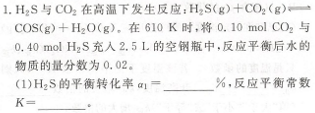
\( K_p \)
Procedure
- Sometimes \( p \) is proportional to \( n \) (\(p V = n R t \))
- \( K_p = \frac{p(C)^c p(D)^d}{p(A)^a p(B)^b} = \frac{(p \cdot x(C))^c (p \cdot x(D))^d}{(p \cdot x(A))^a (p \cdot x(B))^b} = p^{(c + d) - (a + b)} \frac{x(C)^c x(D)^d}{x(A)^a x(B)^b} \) (\(x \) is Mole fraction)
Constant pressure
NCEE
1

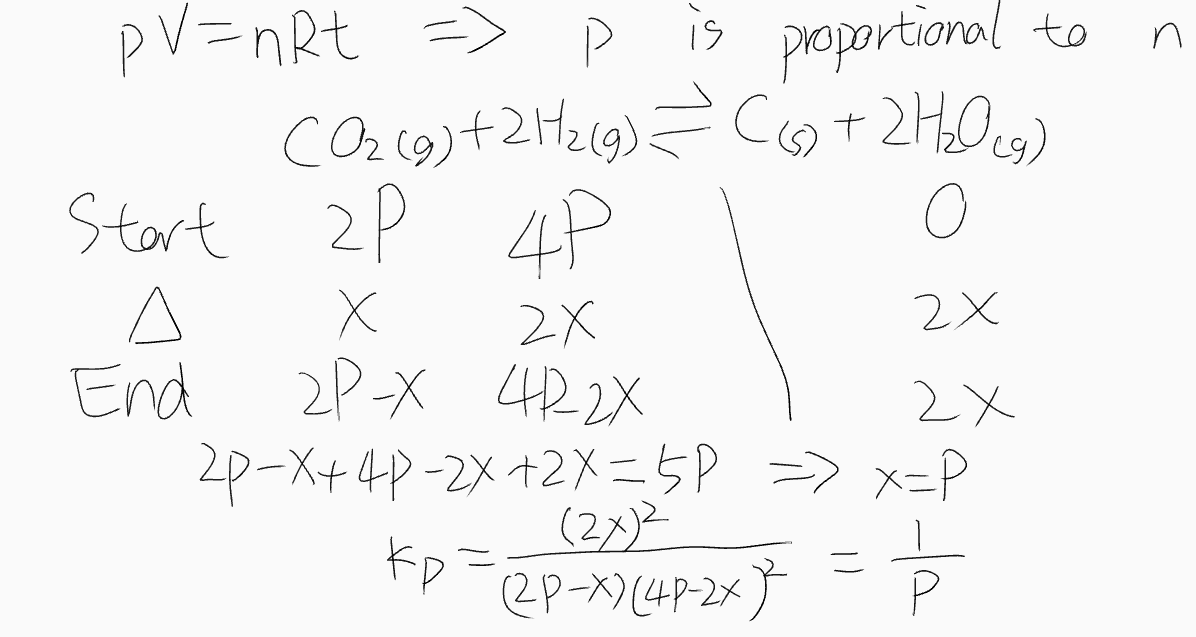
\( N_2 + 3H_2 \rightleftharpoons 2NH_3 \)
\( \frac{3-x}{6-2x} \) = 2
Conservations in Solutions
Charge conservation
Sign: no molecule, only ions
NCEE

Procedure 1
If \( c(A^+) + c(B^+) = c(C^-) + c(D^-) \)
\( c(A^+) > c(B^-) > c(C^+) > c(D^-) \) and \( c(A^+) > c(C^+) > c(B^-) > c(D^-) \) are false
In other word, The first and last ion must be both positive or both negative.
NCEE

Conservation of Matter
Sign: has ions and molecules; no \( H^+ \) \( OH^- \)
Conservation of protons
Sign: has ions and molecules and \( H^+ \) and \( OH^- \)
Extra: Concentration comparison
Major forms > Primary hydrolysis products and Primary ionization products > others
\( MA : HA = 1 : 1 \)
Either \( c(HA) > c(M+) > c(A^-) \) or \( c(A^-) > c(M+) > c(HA) \) is true
Maximum number of coplanar atoms
The only case where all atoms are not coplanar is saturated carbon atoms. A saturated carbon atom is a carbon atom that has only single bonds between other atoms.
Procedure
- Locate saturated carbon atoms
- Cut out 2 bonds in the principle of maximizing the number of atoms remaining
Exercise
How many maximum number of atoms are coplanar in
Extra: Asymmetric carbon
some 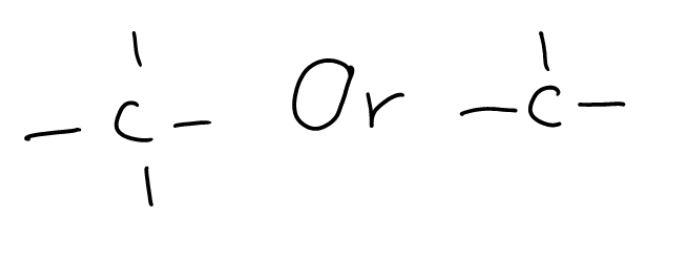 with branch chains
with branch chains
Organic
Procedure
- Degree of unsaturation: C + 1 + N/2 – H/2 – X/2 Wikipedia
Aldehydes and Ketones
Mnemonic
-
\( \require{AMScd} \begin{CD} RCHO + 2 Ag(NH_3)_2OH @>{\Delta}>> H_2O + 2Ag \downarrow + 3NH3 + RCOONH_4 \end{CD} \) \( \begin{CD} RCOONH_4 @>{H^{+}}>> RCOOH \end{CD} \)
-
\( \begin{CD} RCHO + 2 Cu(OH)_2 + NaOH @>{\Delta}>> Cu_2O \downarrow + 3 H_2O + RCOONa \end{CD} \) \( \begin{CD} RCOONa @>{H^{+}}>> RCOOH \end{CD} \)
Primary cell and Electrolytic cell
Mnemonic
- The positive electrode and cathode are only responsible for transferring electrons
- Primary cell
- Negative oxidation; positive reduction (负氧正还)
- Positive positive negative negative (正正负负): Positively charged ions flow to the positive electrode, and negatively charged ions flow to the negative electrode.
- Positive increase; negative decrease (正增负减): The pH of positive electrode increases, and the pH of negative electrode decreases. Requirements: no proton-exchange membrane
- Negative electrode: Reducing substances For example: metal, \( H_2 \)
- Positive electrode: Oxidizing substances For example: \( O_2 \) \( Cl_2 \)
- Electrolytic cell
- Anode oxidation; cathode reduction (阳氧阴还)
- The anode is connected to the positive pole, and the cathode is connected to the negative pole
- Anode: producing oxidizing substances
- Cathode: producing reducing substances
- The anode and the cathode attract each other (阴阳相吸): Positively charged ions flow to the cathode, and negatively charged ions flow to the anode.
- The cathode rise and the anode fall (阴盛阳衰): The pH of the cathode increases, and the pH of the anode decreases. Requirements: no proton-exchange membrane
NCEE
Primary cell

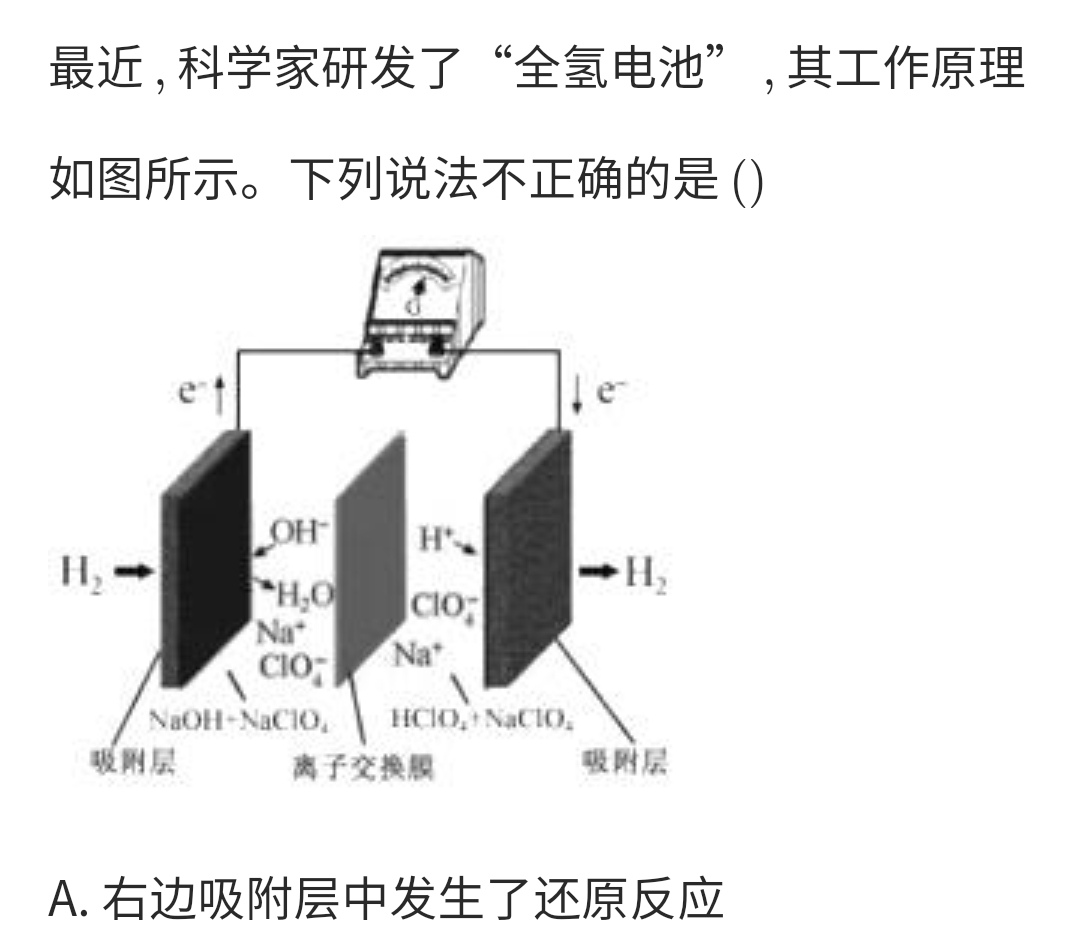

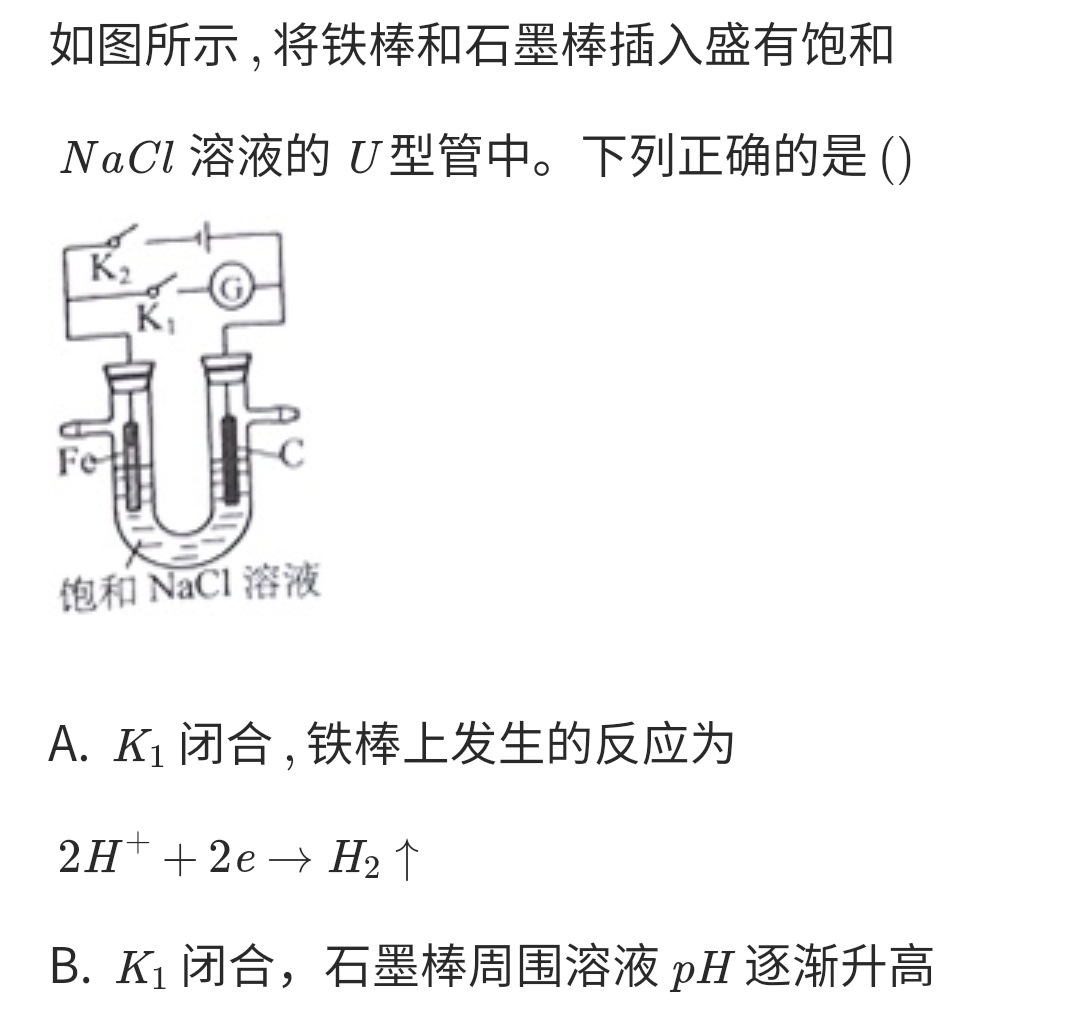
Electrolytic cell
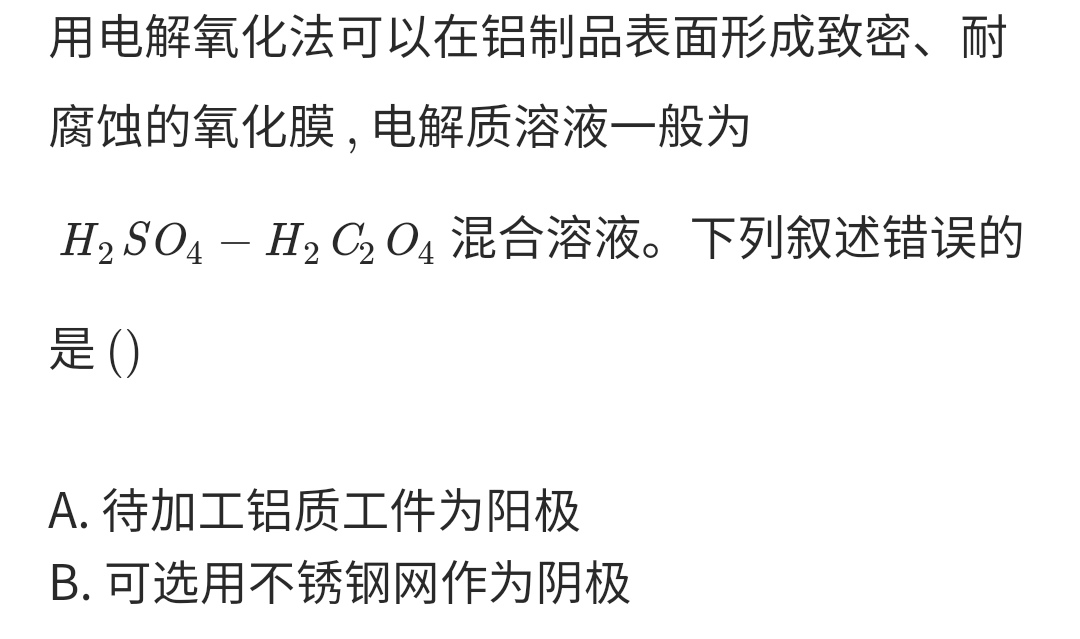
Electrode reaction

Redox
Mnemonic
-
失升氧化还原剂,得降还原氧化剂
-
Primary cell and Electrolytic cell
- 留点铁修路 \( S^{2-} > I^{-} > Fe^{2+} > Br^{-} > Cl^{-} > OH^{-} \) -> \( S - I_2 - Fe^{3+} - Br_2 - Cl_2 - O_2 \)
- 印铁通勤 \( Ag^{+} > Fe^{3+} > Cu^{2+} > H^{+} \) -> \( Ag - Fe^{2+} - Cu - H_2 \)
Procedure: 0
When the chemical valences of elements of a substance is difficult to know, they can be marked with 0.
Structure of matter: Electron-dot diagram & Structural formula
The numbers of covalent bonds for Short-period elements (common situation)
(determined by valence electron)
- 1: H F Cl
- 2: O S
- 3: B Al N P
- 4: C Si
- 5: P
- 6: S
- 7: Cl
Exercise
1
Electron-dot diagram of Sodium azide
(No, it is not  . This is illegal in NCEE.)
. This is illegal in NCEE.)
Weak electrolyte
Mnemonic for speed
- Negative Negative Positive Positive: \( X^{+} + H_2O \rightleftharpoons XOH + H^{+} \) \( X^{-} + H_2O \rightleftharpoons HX + OH^{-} \)
Unimportant Procedure 1
\( \frac{v_{postive}}{v_{negative}} = \frac{K}{Q} \)
Proof for example
\( 2NO_2 (g) = 2NO (g) + O_2 (g) \) \( v_{postive} = k_{postive} c^2(NO_2) \) \( v_{negative} = k_{negative} c^2(NO) \cdot c(O_2) \) When balanced, \( v_{postive} = v_{negative} \) \( \frac{k_{postive}}{k_{negative}} = \frac{c^2(NO) \cdot c(O_2)}{c^2(NO_2)} = K \) Other times, \( \frac{v_{postive}}{v_{negative}} = \frac{k_{postive}}{k_{negative}} \cdot \frac{c^2(NO_2)}{c^2(NO) \cdot c(O_2)} = \frac{K}{Q} \)
\( K_h \)
\( K_h = \frac{K_w}{K_a} \)
Proof:
\( K_h = \frac{c(HA) \cdot c(OH^-)}{c(A^-)} = \frac{c(HA) \cdot c(OH^-) \cdot c(H+)}{c(A^-) \cdot c(H+)} = \frac{K_w}{K_a} \)
NCEE
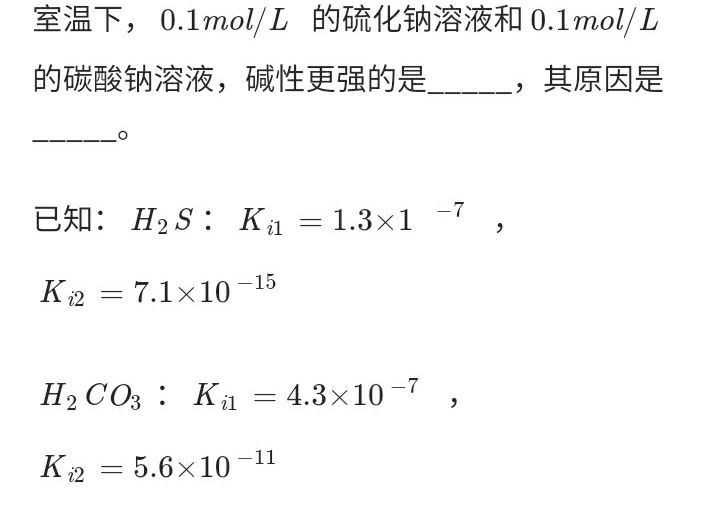
Chinese
Classical Chinese
Statistical conclusion: Multiple choice question of meanings of words
Uncommon words and meanings = correct
Same meaning in modern and classical Chinese = wrong
Different meanng in modern and classical Chinese = mostly correct
Novel
Themes
The unique social environment and values of mainland China form featured themes in examinations.
- Beauty (人性美) and ugliness (人性丑) of humanity
- Beauty: family love (亲情), intimacy (爱情), friendship (友情), national sentiment (民族情) and love with strangers (陌生人情) etc
- Ugliness: arrogant and ignorant (傲慢无知), follow the crowd and trending (从众趋新), complacency (固步自封)
- Complexity (人性的复杂)
- Sympathy and mercy (同情与怜悯)
- War and Peace (战争与和平)
- Anti-war and yearning for peace (反战和对和平的向往)
- Red culture, revolutionary tradition (红色文化 革命传统)
- Thinking of civilization (文明的思考)
- The future of humanity (人类未来): Science and fantasy (科学与幻想)
- Thoughts on the process of urbanization (城镇化进程的思考)
- Thinking of tradition (对传统的思考)
- Changes of the times (时代的变革)
- Human and nature (人类与自然)
- Live in harmony (人与自然和谐共处)
Magic & Reality
Representative Writers: Gabriel García Márquez
Template
- The magic storyline has a basis in reality.
- Magical details are vivid and realistic, with no contradiction to reality.
- Magical things and phenomena symbols, represents and suggests real life.
NCEE
1
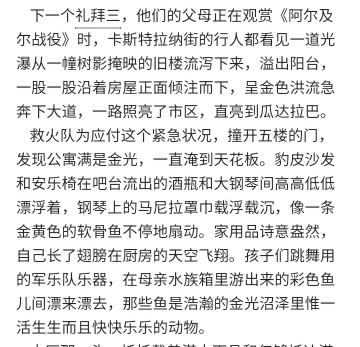
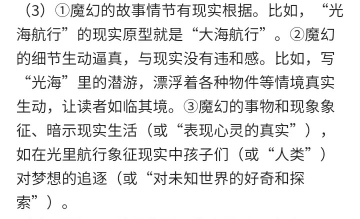
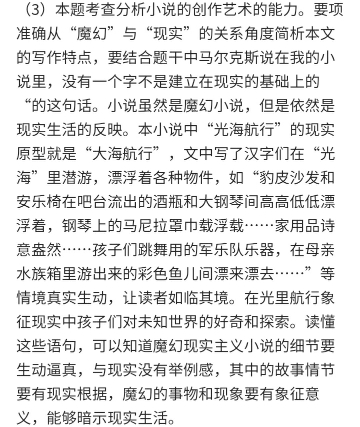
2
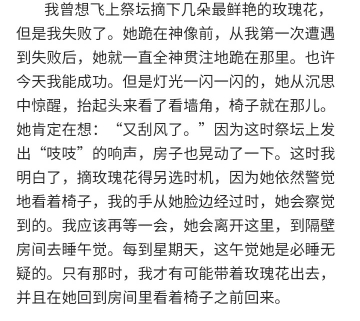

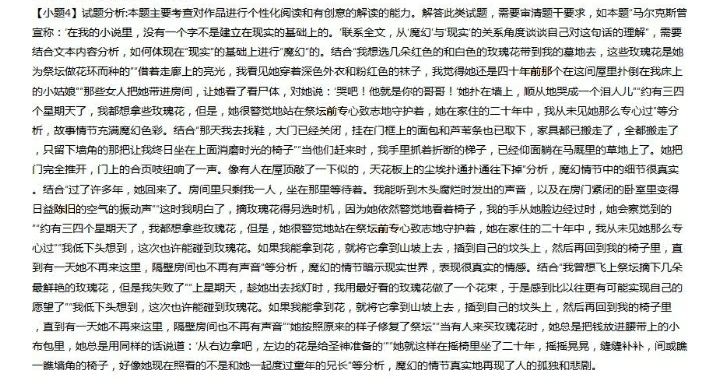
Poetry
"命蹇词工"
-- The reason
- Youth (青年): make a sightseeing tour (游山玩水); Eager to be used (渴望重用)
- The prime of life (壮年): running for achievements (奔走功名); frustration with career path (失意仕途)
- Old age (暮年): aged with great aspirations (老骥伏枥); feelings about hiding (隐逸情怀)
Themes
- 山水田园 官场黑暗;向往宁静;淡泊名利
- 边塞征战 建功立业;厌战思归;边塞豪情
- 咏史怀古 历史变迁;借古讽今;以古自喻
- 羁旅思乡 孤寂漂泊;思乡思亲;壮志难酬
- 咏物抒怀 托物言志;以物自喻
- 送别劝勉 离愁別绪;豁达豪迈
- 生活杂感 青春易逝;仕途失意;偶得喜悅
Techniques (手法)
Sorted by frequency in NCEE (2010-2020)
- 虚实结合
- 衬托
- 对比
- 借景抒情
- 用典
- 拟人
- 比喻
表达效果常用术语
- 生动形象/化抽象为具体
- 突出了/平添了丰富了...
- 委婉含蓄写出了...
- 化静为动/化虚为实
- 意蕴丰富/贴切自然
- 细致传神地刻画了...
- 具有极强的艺术感染力
- 构思新奇/用词巧妙
Write from memory

論語-MindMap
format: https://markmap.js.org/repl/ https://github.com/gera2ld/markmap
为政以德
以德治国
- 2.1
反对战争,武力,权数,苛政
- 2.3
- 16.1
- 14.5
- 12.19
民本
- 12.9
富民,教民
- 13.9
正己
- 12.7
- 13.6
克己复礼
How
Why
诲人不倦
教育
作用
- 17.3
身教
- 17.19
因才施教
-
11.3
-
11.22
对象
- 15.39
方法
启发诱导式
- 7.8
建立在德行之上
- 3.8
精益求精
- 1.15
Handwriting
It's necessary to have a prefect handwriting for any examinations.
Mathematics
This is a subject that examine students' following skills.
- Comprehension
- Calculate numbers fast and without mistakes just like a old school calculator
- ...
Algebraic substitutions
Trigonometric substitution
Vector
\(a\cdot b+c\cdot d=(a,c)\cdot(b,d)=\left\lvert(a,c)\right\rvert\cdot\left\lvert(b,d)\right\rvert\cdot cos\theta\)
Exercise 1
\(\sqrt{1-x}+2\sqrt{x}\) max
Cauchy–Schwarz inequality
\((\bar a\cdot\bar b)^2\leq\left\lvert\bar a\right\rvert^2\cdot\left\lvert\bar b\right\rvert^2\)
\(x_1x_2+y_1y_2\leq\sqrt{(x_1^2+y_1^2)(x_2^2+y_2^2)}\)
Exercise 1
\(x+2y+3z=3\) Solve \(\sqrt{x}+\sqrt{y}+\sqrt{z}\)
Derivative
Procedure: L'Hôpital's rule
https://web.archive.org/web/20210121123228/https://en.wikipedia.org/wiki/L%27H%C3%B4pital%27s_rule
Exponential & Logarithm
Logarithmic identities
https://en.wikipedia.org/wiki/List_of_logarithmic_identities
NCEE
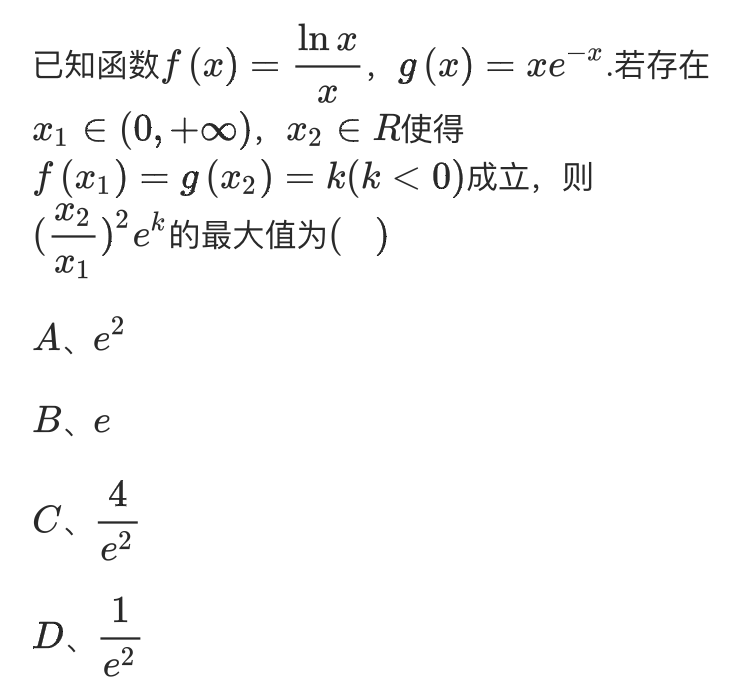

Function
Periodic function
NCEE

2
\( f(x) = 2ax^2+bx-3a+1 \) \( \forall{x} \in [-4,4] . f(x) \geq 0 \) \( 5a+b \) min
Solution
\( f(x) = (2x^2-3)a +xb+1 \)
\( \frac{2x^2-3}{1} = \frac{5}{1} \)
......
\(-\frac{1}{3}\)
Inequality
Procedure: Sugar water inequality
Inequality of arithmetic and geometric means
NCEE
Make Up Proportion
来源: 疑似杭四中
\( x, y, z \in R^+\) 已知 \( x + y + z = 1 \) 求 \( \sqrt{x y} + \sqrt{x z} - y - z \) 的最大值
Solution
\( \sqrt{x y} + \sqrt{x z} - y - z = \sqrt{\lambda x (\frac{1}{\lambda}) y} + \sqrt{\mu x (\frac{1}{\mu}) z} - y - z \leq \frac{\lambda + \mu}{2} x + (\frac{1}{2 \lambda} - 1) y + (\frac{1}{2 \mu} - 1) z \)
\( \frac{\lambda + \mu}{2} = \frac{1}{2 \lambda} - 1 = \frac{1}{2 \mu} - 1 \)
......
\(\frac{\sqrt{3}-1}{2}\)
Taylor series (Maclaurin series)
\(\displaystyle \sum_{n=0}^\infty \frac{f^{(n)}(0)}{n!}x^n\) \(\displaystyle \sum_{n=0}^\infty \frac{f^{(n)}(a)}{n!}(x-a)^n\)
Sometimes the first few terms of the series is used.
Special case 0: Deflation as tangent (放缩为切线)
Number sequence
Procedure
- Given \( a_{n+1} = k a_n + p a_{n-1} \), \( a_{n+1} - x a_n = (k - x) (a_n - x a_{n-1}) \) where \( x^2 = k x + p \)
Procedure: y = x Model
NCEE
数列 { \( a_n \) } 满足 \( a_1 = a \), \( a_{n+1} = a_n^2 + a \) 且 \( \left\lvert a_n \right\rvert \leq 2 \), 则 \( a \) 的取值范围为 ()
A. [-2,2] B. [-2,0] C. [0,\( \frac{1}{4} \)] D. [-2,\( \frac{1}{4}\)]
Scaling
\(a_1\frac{1-q^n}{1-q}\leq\frac{a_1}{1-q}\) where \(q\in(0,1)\)
NCEE


On A Plane ...
Line
General Form: \( A x + B y + C = 0 \) Form 1: \( y = k x + b \)
Theorem 1
\( A x + B y + C \) have the same sign \( \iff \) Points are on the same side
\( A x + B y + C \) have the different sign \( \iff \) Points are on the different side
NCEE

Theorem 2
If the range of angles is continuous
90 degree is in the range and it is not the endpoint \( \iff \) the range of slope is discontinuous
90 degree is in the range \( \iff \) there is \( \infty \) in the expression of the range of slope
NCEE
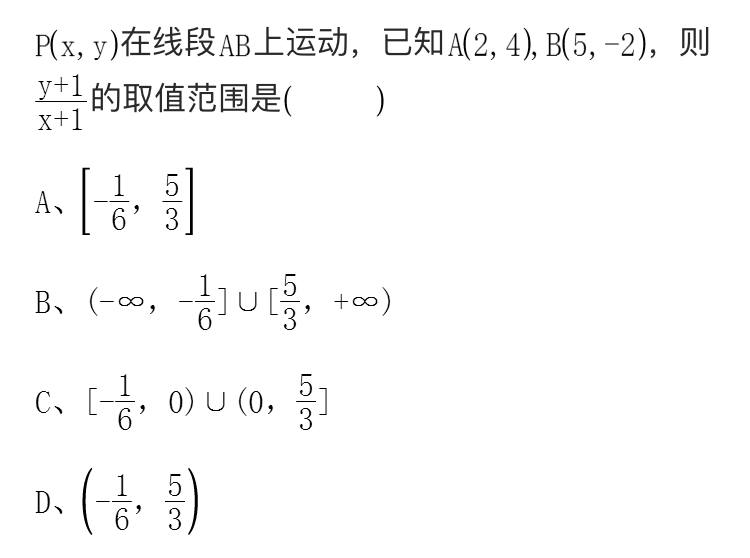
NCEE: Parallel; Vertical and Auxiliary Rounding




Parametric Equation
Procedure: reflect a point across a line
Given
Line \( Ax+By+C=0 \)
Point 0 \( P_0(x_0,y_0) \)
,
\(d_2=\frac{Ax_0+By_0+C}{A^2+B^2}\)
Point 1 \(x=x_0-2d_2A\) \(y=y_0-2d_2B\)
Circle
\((x-a)^2+(y-b)^2=r^2\)
Tangent:\((x-a)(x_0-a)+(y-b)(y_0-b)=r^2\)
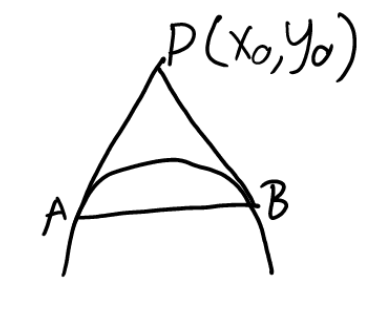
Line AB: \((x-a)(x_0-a)+(y-b)(y_0-b)=r^2\)
NCEE
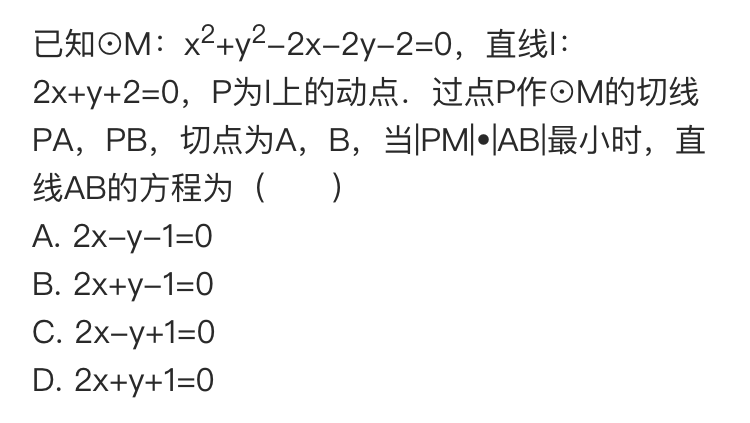
NCEE: Relations between multiple circles
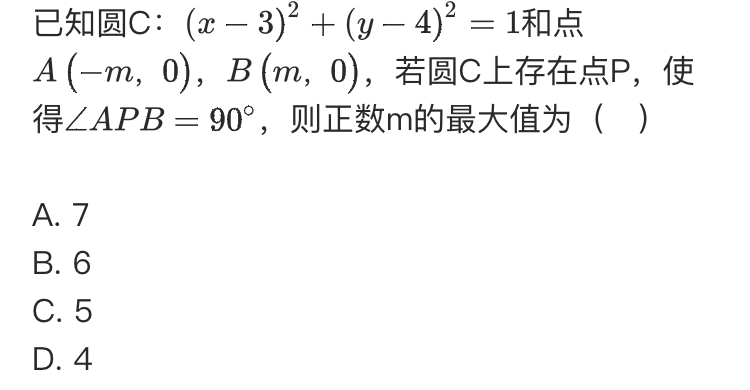
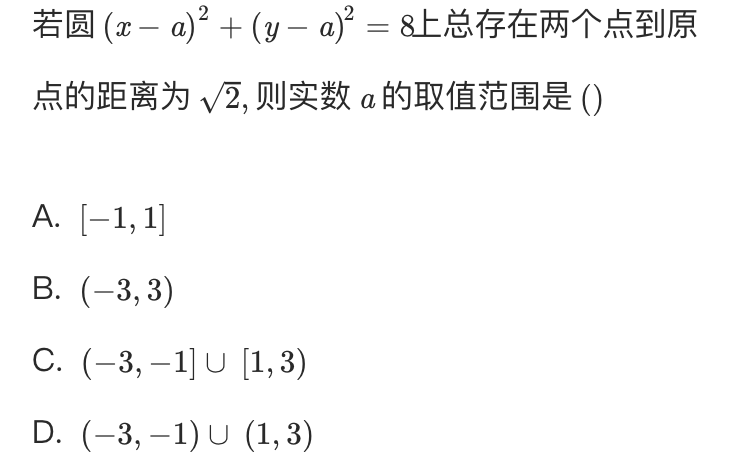
Ellipse
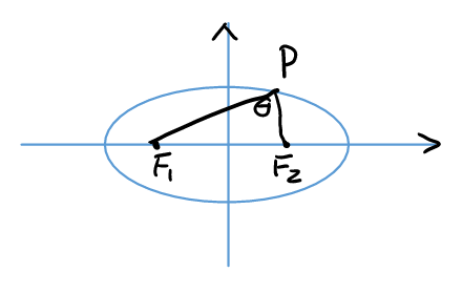
Theorem:
\( S_{\Delta F_1 P F_2} = \frac{1}{2} \left\lvert F_1F_2 \right\rvert \left\lvert y_p \right\rvert = c \left\lvert y_p \right\rvert \)
\( S_{\Delta F_1 P F_2} = b^2 tan \frac{\theta}{2} \)
Theorem 1
\(c\in[sin\frac{\theta}2,1)\)
NCEE


Theorem 2
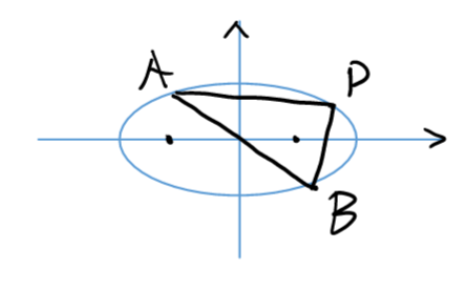
Ellipse/Hyperbola \(k_{PA}\cdot k_{PB}=e^2-1\)
Proof: \(x^2+(\frac{a}{b}y)^2=a^2\) Then regard it as a circle
(or, can alternatively be deduced from point difference method)
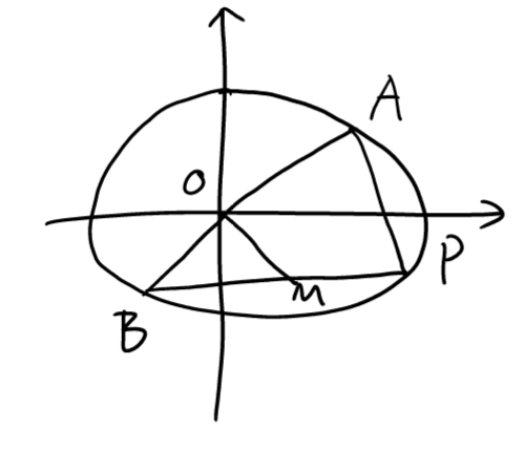
Ellipse/Hyperbola \(k_{MO}\cdot k_{BP}=e^2-1\)
Hyperbola
\( S_{\Delta F_1 P F_2} = b^2 cot \frac{\theta}{2} \)
NCEE

Parabola
Theorem 1
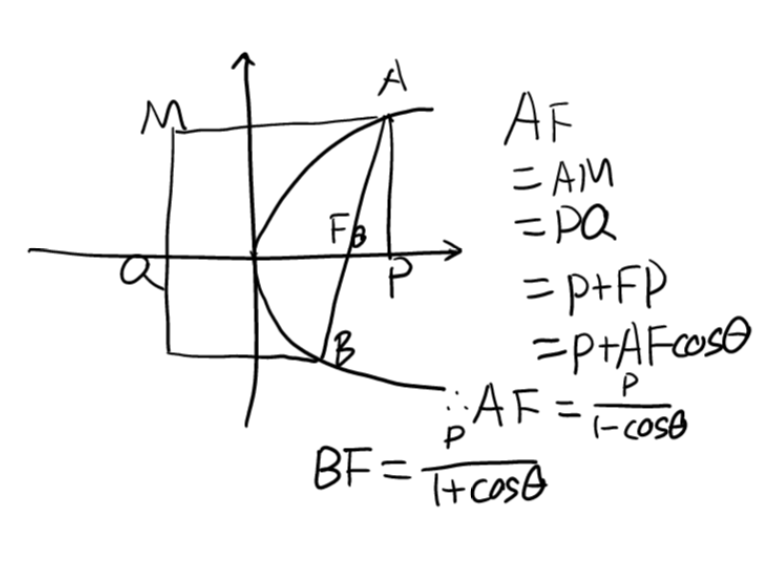 \(AB=AF+BF=\frac{2p}{1-cos^2\theta}=\frac{2p}{sin^2\theta}\)
\(AB=AF+BF=\frac{2p}{1-cos^2\theta}=\frac{2p}{sin^2\theta}\)
Ellipse/Hyperbola: \(AF=\frac{\frac{b^2}a}{1-e\cdot cos\theta}BF=\frac{\frac{b^2}a}{1+e\cdot cos\theta}\)
Parabola/Ellipse/Hyperbola: \(AF=\lambda BF\iff \left\lvert e\cdot cos\theta\right\rvert=\left\lvert\frac{\lambda-1}{\lambda+1}\right\rvert\)
Mnemonic
\(\frac{p}{1\pm\left\lvert cos\theta\right\rvert}\) Long minus;short add
NCEE


设点联立韦达
1
Ellipse:
\(\frac{x^2}{a^2}+\frac{y^2}{b^2}=1\) and \(Ax+By+C=0\)
\(\iff\)
\(\Delta=4b^2B^2a^2(a^2A^2+b^2B^2-C^2)\)
\(\Delta'=a^2A^2+b^2B^2-C^2\)
Hyperbola: \(\frac{x^2}{a^2}-\frac{y^2}{b^2}=1\iff\frac{x^2}{a^2}+\frac{y^2}{(b i)^2}=1\) so \(\Delta'=C^2+b^2B^2-a^2A^2\)
NCEE

2
\(\alpha x^2+\beta y^2=\gamma\) and \(Ax^2+By+C=0\) \(\iff\) \((\alpha B^2+\beta A^2)x^2+2CA\beta x+\beta C^2-\gamma B^2\)
Ellipse: \(l=\frac{2\sqrt{a^2b^2(A^2+B^2)\Delta'}}{a^2A^2+b^2B^2}\)
Hyperbola: \(l=\frac{2\sqrt{a^2b^2(A^2+B^2)\Delta'}}{\left\lvert a^2A^2+b^2(Bi)^2 \right\rvert}=\frac{2\sqrt{a^2b^2(A^2+B^2)\Delta'}}{\left\lvert a^2A^2-b^2B^2 \right\rvert}\)
Solid geometry
round, sphere
Procedure: Radius of circumscribed sphere
1
\( R^2 = \frac{1}{4} h^2 + r^2 \)
Proof for example:
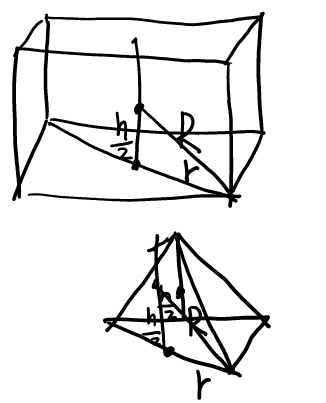
2
\( R = \frac{l^2}{2} \)
Proof for example:
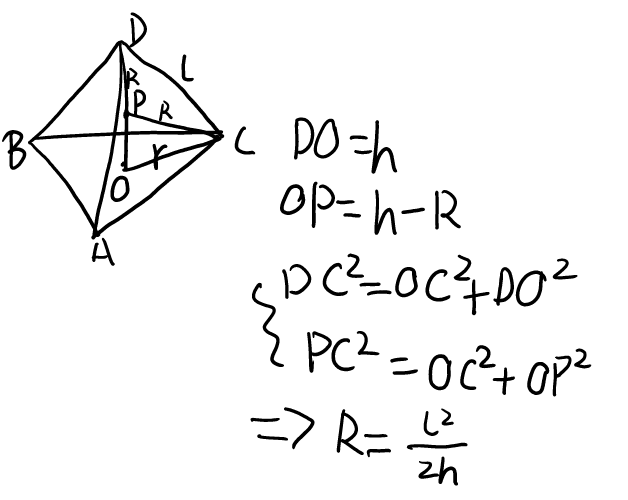
Mnemonic: 两只老虎
Tetrahedron
Opposite sides are equal

NCEE

Inscribed sphere of a Pyramid
\( R = \frac{3V}{S} \)
Regular tetrahedron with edge length \( a \): \( R = \frac{\sqrt{6}}{12} a \)
normal vector
Procedure: intercept
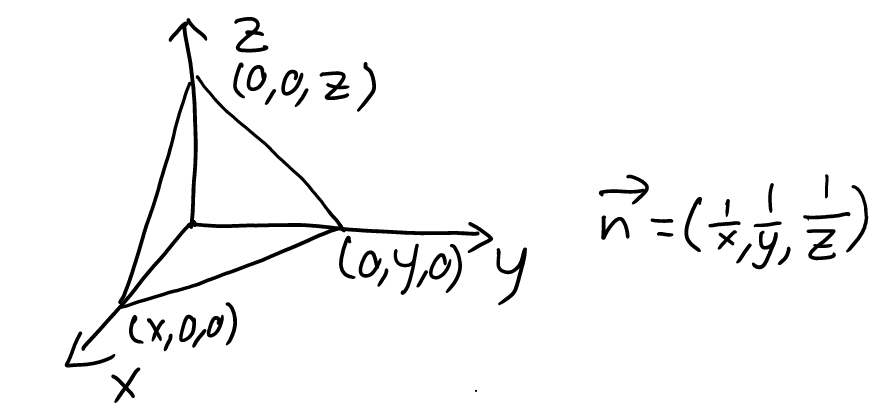
No intersection: For example, \( n = (0, y, z) \) if and only if there is no intersection between the plane and the x-axis.
Procedure: Point-to-Plane Distance
\( \frac{\vec{v}\vec{n}}{\left\lvert n \right\rvert} \)
Procedure: Pyramid Projection
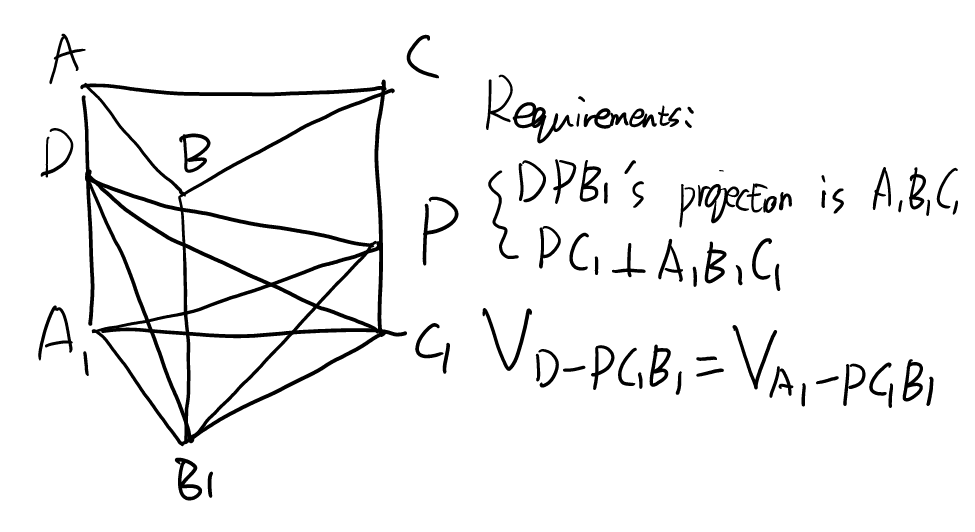
Note: The side edge is perpendicular to the projection surface.
NCEE

Theorem 0
(need more study)
\(sin\alpha=sin\beta\cdot\sin\gamma\) \(\alpha\) 线面 \(\beta\) 锐二面角 \(\gamma\) 线与交线夹角
Statistical Theorem 1
\(V=\frac{4}{3}\pi R^3\)
In general, the radius of the ball is regular which means that radius won't be something like \(\sqrt[3]{\text{...}}\)
NCEE

Some (General?) Methods
Making up Proportion
2

\((x\bar a+y\bar b+z\bar c)^2=...\)
Making up function and number sequence
Construct a constant function or a constant number sequence that satisfies the multiple-choice question whenever possible.
Skip the step of construct \(g(x)\)
......+\(f'(x)\)+.........\(<0 \iff\) \(g'(x) < 0\)
Specific value: 2D -> 1D
Represent the two-dimensional figure described in the multiple-choice question on a one-dimensional line whenever possible.
Statistics & Probability
\( \displaystyle \sum_{i=1}^n (x_i - \bar x)^2 = \displaystyle \sum_{i=1}^n x_i^2 - n \bar x^2 \)
\( s^2 = \displaystyle \sum_{i=1}^n \frac{(x_i - \bar x)^2}{n} = \frac{\displaystyle \sum_{i=1}^n x_i^2}{n} - \bar x^2 \)
NCEE

Trigonometric
Brocard points
NCEE

张角定理
Apollonius's theorem
Physics
Procedure: Multiple choice
Statistical conclusion:
If you can't solve it, just choose D
Conveyor belt
\(Q=E_k\)
Eletric
\(\varphi=k\frac{Q}{R}\)
Eletric Field
Uniform electric Field
Procedure
- In a parallelogram ...

Procedure: Symmetry
NCEE
1

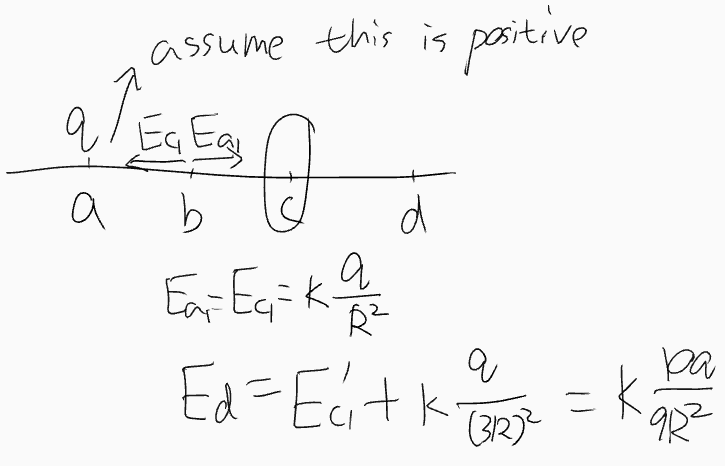
2

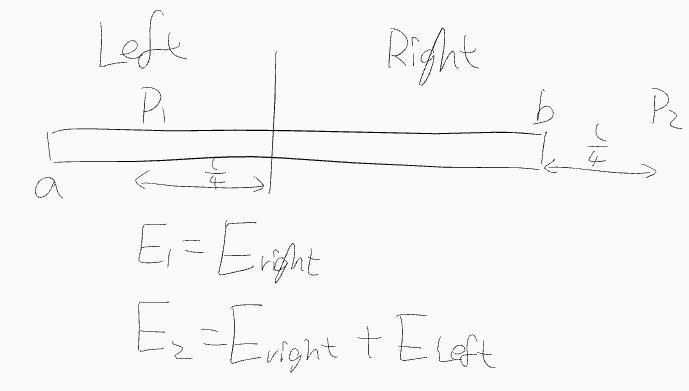
Procedure 2

Capacitor
\( C = \frac{Q}{U} \) \( C = \frac{\epsilon_r S}{4 \pi k d} \)
\( E = \frac{U}{d} \)
Procedure: \( E \propto \frac{Q}{S} \)
Proof: \( E = \frac{U}{d} = \frac{Q}{C \cdot d} = \frac{Q}{\frac{\epsilon S}{4 \pi k d} d} = \frac{4 \pi k Q}{\epsilon S} \)
Alternating Current
Procedure: Equivalent current
- sine, cosine: \( I = \frac{I_{max}}{\sqrt{2}} \)
- Calculate the average of \( I^2 \)
Procedure: Dynamic analysis of the circuit with internal resistance
Components connected in series: Inverted ratio Paralleled: proportional ...
Force
Procedure: Similar triangles
- Geometric triangles are similar to vector triangles
NCEE
1

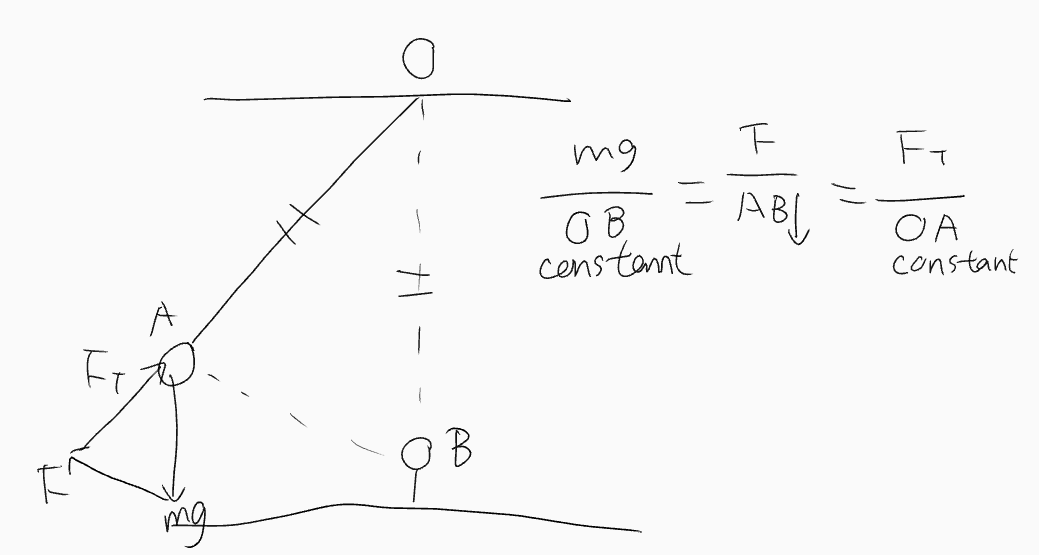
Procedure: Deformed Lever
- Two balls balanced by three forces
- Have a pair of internal forces (e.g., coulombic forces)
- Another pair of forces crossed at one point, which is the fulcrum
NCEE

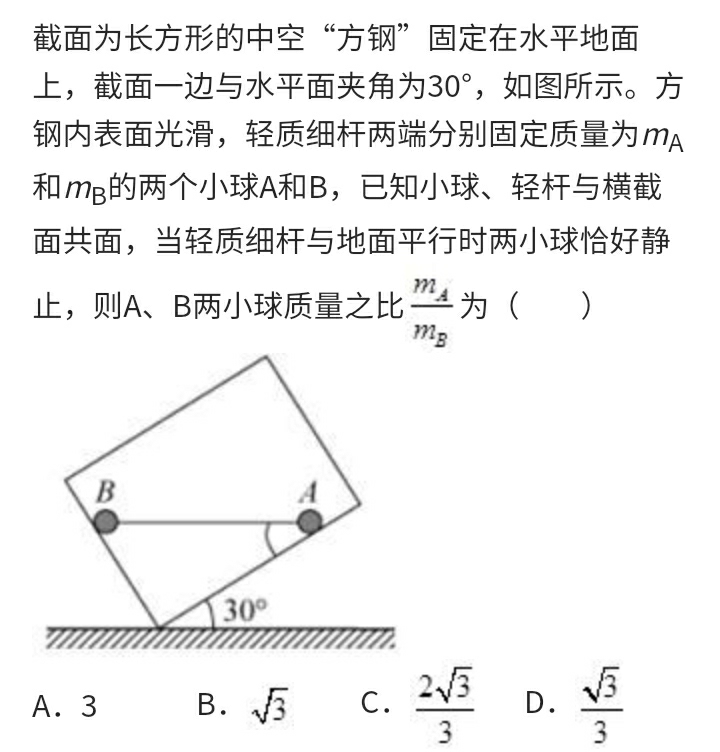

Procedure 3
Requirement: The resultant force of multiple forces is zero
If a force \( F \) is reversed, the resultant force after that is \( 2F \)
Kinetic energy
Work-energy theorem
Procedure: decomposition
one case
Requirement: The speed in one direction is unchanged Explanation: reference frame conversion
Proof for one case: \( \frac{1}{2} m v_1^2 - \frac{1}{2} m v_0^2 = \frac{1}{2} m (\sqrt{v_0^2 + v_y^2})^2 - \frac{1}{2} m v_0^2 = \frac{1}{2} m v_y^2 \)
general
\( F_x = m \frac{v_x^2 - v_{x0}^2}{2x} \)
\( W_x = F_x x = \frac{1}{2}m v_x^2 - \frac{1}{2}m v_{x0}^2\)
Magnetic Field
Procedure: Forces between two currents
Two wires carrying current in the same direction attract each other, and they repel if the currents are opposite in direction.
Procedure: Test Electric Current
Used to analyze the strength of the magnetic field generated by multiple currents.
- Imagine that there is a current at the coordinates to be analyzed
- Calculate the resultant force
- Use Left-hand rule to determine the direction of the magnetic field; \( F \propto B \propto I \)
NCEE
1

Solution

2
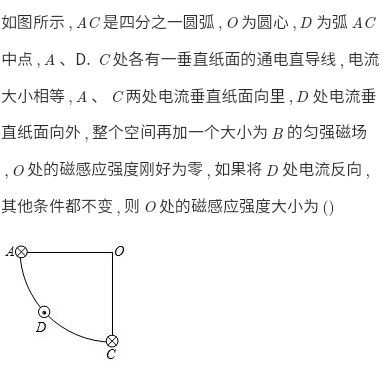
Circular motion
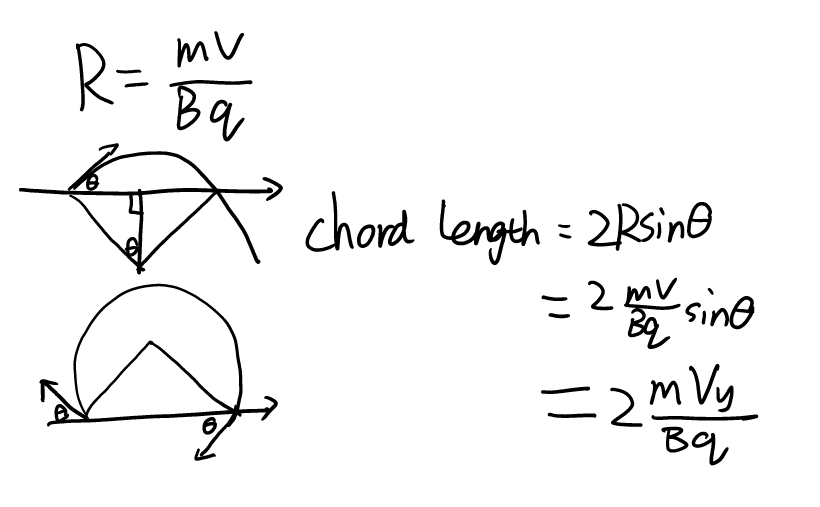
Velocity deflection angle = central angle = 2 * chord tangent angle (or \(2\pi\) - 2 * chord tangent angle)
2
If the point of the center of the circle is on the lines of the enter and/or exit velocities
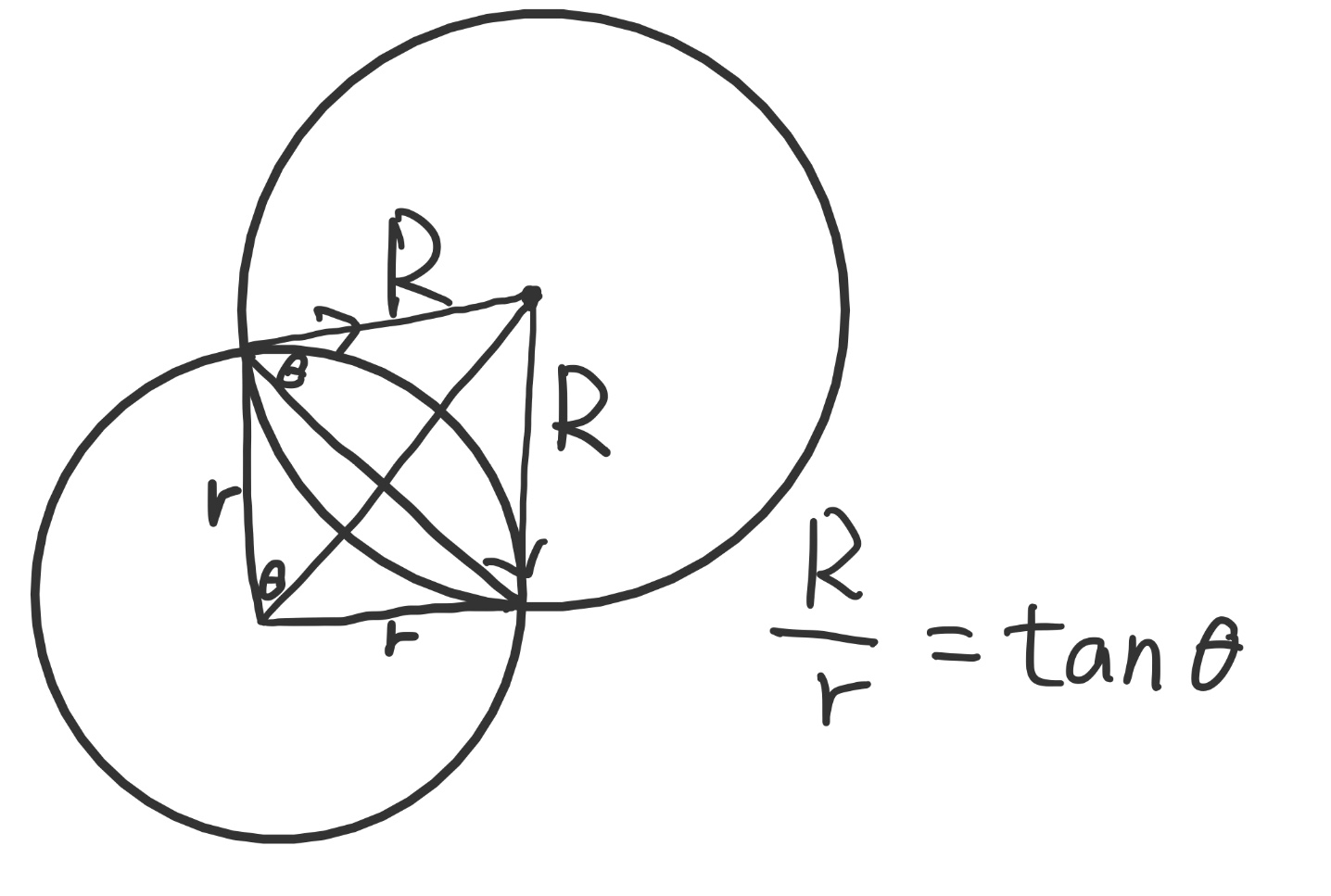
Minimal circle
diameter of the circle = chord length of the motion
area of mimimal rectangle = height of ircular segment * chord length
NCEE
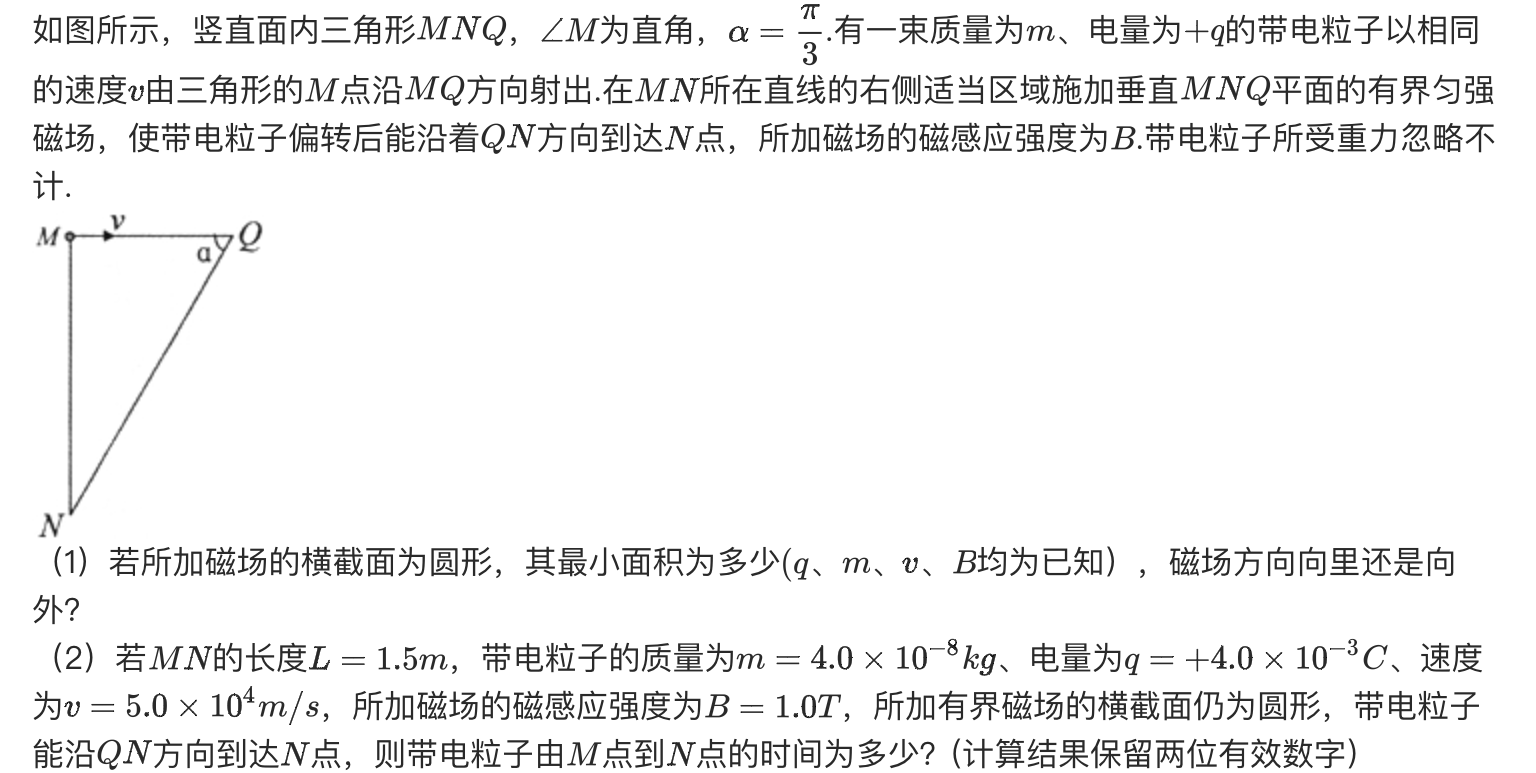
Procedure: Decompose Lorentz force
\( F_x = q(E_x + v_y B_z - v_z B_y ) \)
For NCEE:
\( q l_x B = \Sigma q v_x B t = m \Delta v_y \)
\( q l_y B = \Sigma q v_y B t = m \Delta v_x \)
NCEE

2

Hint: rotate the diagram
Momentum
Perfect Elastic Collision
\( m_1 v_1 + m_2 v_2 = m_1 v_1' + m_2 v_2' \)
\( \frac{1}{2} m_1 v_1^2 + \frac{1}{2} m_2 v_2^2 = \frac{1}{2} m_1 v_1'^2 + \frac{1}{2} m_2 v_2'^2 \)
Procedure
- \( v = \frac{m_1 v_1 + m_2 v_2}{m_1 + m_2} \)
- \(v_1\), \(v\) and \(v_1'\) form an arithmetic sequence. \(v_2\), \(v\) and \(v_2'\) form another arithmetic sequence. (\( v - v_1 = v_1' - v \) and \( v - v_2 = v_2' - v \))
Perfectly inelastic collision
\( m_1 v_1 + m_2 v_2 = (m_1 + m_2) v' \)
Procedure
- \( Q = \frac{1}{2} \frac{m_1 m_2}{m_1 + m_2} (v_1 - v_2)^2 \) (Available energy, deduced from König's theorem)
- Use a special reference frame in which total momentum is zero.

Recoil
Requirement: The total momentum is zero.
Procedure
- Momentum and impulse are equal and opposite.
- \( \frac{a_1}{a_2} = \frac{v_1}{v_2} = \frac{x_1}{x_2} = \frac{E_{k1}}{E_{k2}} = \frac{m_2}{m_1} \)
Collision multiple times
Procedure
- For any collision occurring in an isolated system, momentum is conserved.
- One people throwing a ball at a wall \( I' = I = (2n - 1) m v \) ; \( I' = M v_n \)
- Two people throwing a ball at each other \( I_1 = (2n - 1) m v \) ; \( I_2 = 2n m v \)
NCEE

Inelastic collision
Procedure
- \( E_{loss} = \frac{1}{2} \frac{m_1 m_2}{m_1 + m_2} (\Delta v_a^2 - \Delta v_b^2) \) (\( \Delta v_a \): Before collision; \( \Delta v_b \): After collision)
NCEE
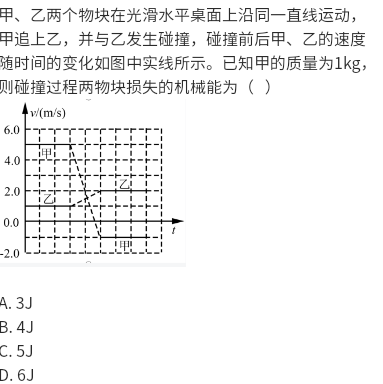

Motion
Uniformly accelerated motion with zero initial velocity
Equal-time displacement ratio 1:3:5:...
Equal-displacement time ratio 1:\(\sqrt{2}-1\):\(\sqrt{3}-\sqrt{2}\):...
If time ratio is \(\frac{1}{2}\):1:1:1:1... , displacement ratio is \(\frac{1}{8}\):1:2:3 or 1:8:16:24:...
Initial and final velocity being zero
\(\frac{t_1}{t_2}=\frac{x_1}{x_2}=\frac{a_2}{a_1}\)
If \(ma_1=(F-f)\) and \(ma_2=f\), \(\frac{F}{f}=\frac{t_1+t_2}{t_1}=\frac{x_1+x_2}{x_1}\)
Equal-time return
\(x_1:x_2=1:1\) \(v_1:v_2=1:2\) \(a_1:a_2=1:3\)
Movement
Parabola
Curved motion with constant acceleration
Note: Sometimes the speed cannot decease to 0.
Procedure: Newton's second law of The whole system
\( F_x = m_1 a_1x + m_2 + a_2x + ... \)
Exercise
1
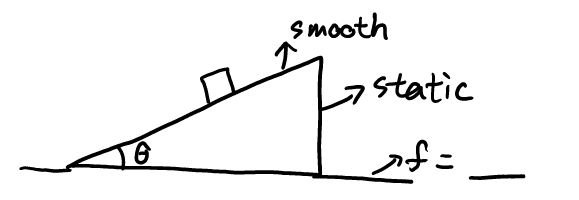
Solution
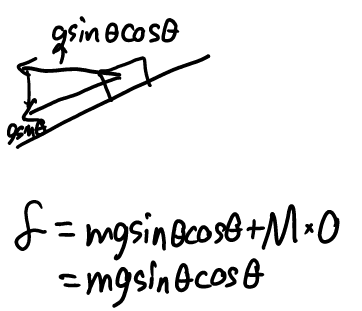
Procedure 2
\( \left\lvert \frac{F_x}{F_y} \right\rvert = \left\lvert \frac{\Delta v_x}{\Delta v_y} \right\rvert \) (deduced from impulse-momentum theorem)
Horizontal cast movement

\( y = \frac{1}{2} a t^2 = \frac{1}{2} a (\frac{x}{v_0})^2 = \frac{F}{2m v_0^2} x^2 = \frac{F}{4E_{k0}} x^2 \)
\( tan \theta = y' = \frac{F}{m v_0^2} x = \frac{F}{2E_{k0}} x \)
\( tan \theta_v = 2 tan \theta \)
Utilities
Well-know Utilities for Examination-Oriented Studying
Exam-Oriented-Chinese-Writings
Mar 20 2021
Body
在有尽的时间里创造无穷的价值
时间有限,有些人选择以有限的生命去交换无限的事物,为社会与人类创造价值,成中国的脊梁,后生的楷范;有些人选择把时间留给家人,为旁人提供幸福,铭写了人生的意义。 在2020年那个特殊的春节,无数的志士仁人承受不能陪伴家人之苦,“以血荐轩辕”,奋战在疫情第一线。医者仁心,身患渐冻症的院长张定宇,拖着不利索的双腿,与时间和生命赛跑,奔波四处,不曾退缩,坚守于救死扶伤最前线,救助不计其数的患者;耄耋老人钟南山亲自奔赴武汉,列车上处理厚厚的一摞文件,彻夜未眠,为抗疫做贡献;韩红驾车13小时,将60车急需物质送往武汉,为疫区人民倾注全部的心血,最终累倒在病床上。他们用大爱润泽了这个世界,守望疫区百姓的生命,让疫情的阴霾之中,留有一抹亮色;他们扛起了沉重的道义担当,彻底诠释了什么是中华民族不屈的脊梁,在史册上写下了悲壮雄浑的篇章,泽被万世。试想,如果面对严酷的疫情,他们没有挺身而出,而是选择瑟缩在一个角落,疫情怎能这么快得被控制?他们又怎会被世人所铭记?正是选择在有限的时间里“为天地立心,为生民立命”,为人创造价值,支撑起这个时代的栋梁,抗疫才有了今日的胜利,他们的人生才闪耀着无比璀璨的光辉。 “境界有大小,不以是而分优劣。”(静安先生语)境界没有高低之分,只要是。宋丹丹最后一次登上春晚时说,未来会把时间留给家人。不错,把有限的时间留给家人,不失也为创造价值实现自身的意义的一种方式。傅怒安其子留学海外时,以一封封殷切真诚的信件进行全方位的教育。其家书被誉为“傅雷毕生最重要的著作”。在有限的光阴里,他成就了他人,也成就了自己。 反观当下之时代,消费主义盛行的社会,不少年轻人贪图享乐之生活,整日空喊“太累”,泅游于声色犬马的囹圄,宣扬所谓的“佛系”心态,失却了锐气与豪情,吸食着精神鸦片,丢失了精神之家园与自身意义,令人唏嘘不已。还有许多人成为了精致的利己主义者,理想完全退场,精神无根地漂泊,把自己异化为了追名逐利的生存机器。他们努力的目标不是改变这个世界,让这个世界变得更好。他们正如弗里德里希·尼采口中的市侩,没有任何主见,没有信仰,除了为己,没有任何目标。精心打扮与伪装的包装之下,他们所作所为都只是自身利益的打量,自身利益的计算,把有限的人生全部用于交换利益,不择手段,危害他人,殊不知这样的,没有任何精神内涵的人生,没有任何价值与意义。北大中文系钱理群教授在教学生涯中常常会碰到这样的“精英”。一天,一个学生突然出现在钱理群的鲁迅研究课堂上,表现得非常积极活跃,时不时点头致意,课程之后主动条分缕析地分享见解,恭维钱理群,之后日日如此。几个月后,课下交流完毕后这个学生突然拿出了留学推荐信。写完之后,之后的课,他再也没有出现过,人间蒸发,就此消失。一切都是套路,一切都是算计的点头,一切都只是为了一纸知名教授的推荐信。我们曾经嘲笑过一个草原上的孩子,放羊为了赚钱,赚钱为了繁育后代,繁育后代继续放羊的老路。那些精致的利己主义者也正如此,赚钱名和利,养育后代,培育下一代精致的生存机器。足印遍布世界,而一切精致只为己,没有突破自己的欲望,不想为这个世界创造什么价值,在没有意义的桎梏里泅浮,放弃了在有尽的时间里创造无穷的价值的可能。 ”为往圣继绝学,为万世开太平“,在有限的生命里奋斗不息,用短暂的年华成就他人,成就自己,成就无限的事业,这便是人生意义之所在。
Make-Halting-Problem-An-Unsolved-Problem-Again
Make-Halting-Problem-An-Unsolved-Problem-Again.tgz
Music-Homework-Dec-2020
NCEE
Raw Data
学业考试历次成绩查询
考试年月 语文 数学 外语 思想政治 历史 地理 物理 化学 生物 技术 信息技术 通用技术 综合
201906 B A A
202001 B B
202007 B C B B
202101 A
高考选考历次成绩查询
考试年月 外语 思想政治 历史 地理 物理 化学 生物 技术
202101 131 82 61 88
部分考生由于存在转学、身份证变更等情况,有部分数据未输入或合并,如有疑问,请联系中学管理人员反馈信息
学业考试最终成绩查询
科目 语文 数学 外语 思想政治 历史 地理 物理 化学 生物 技术 信息技术 通用技术 综合
等第 B C A B B B A B B A
1月选考报告单
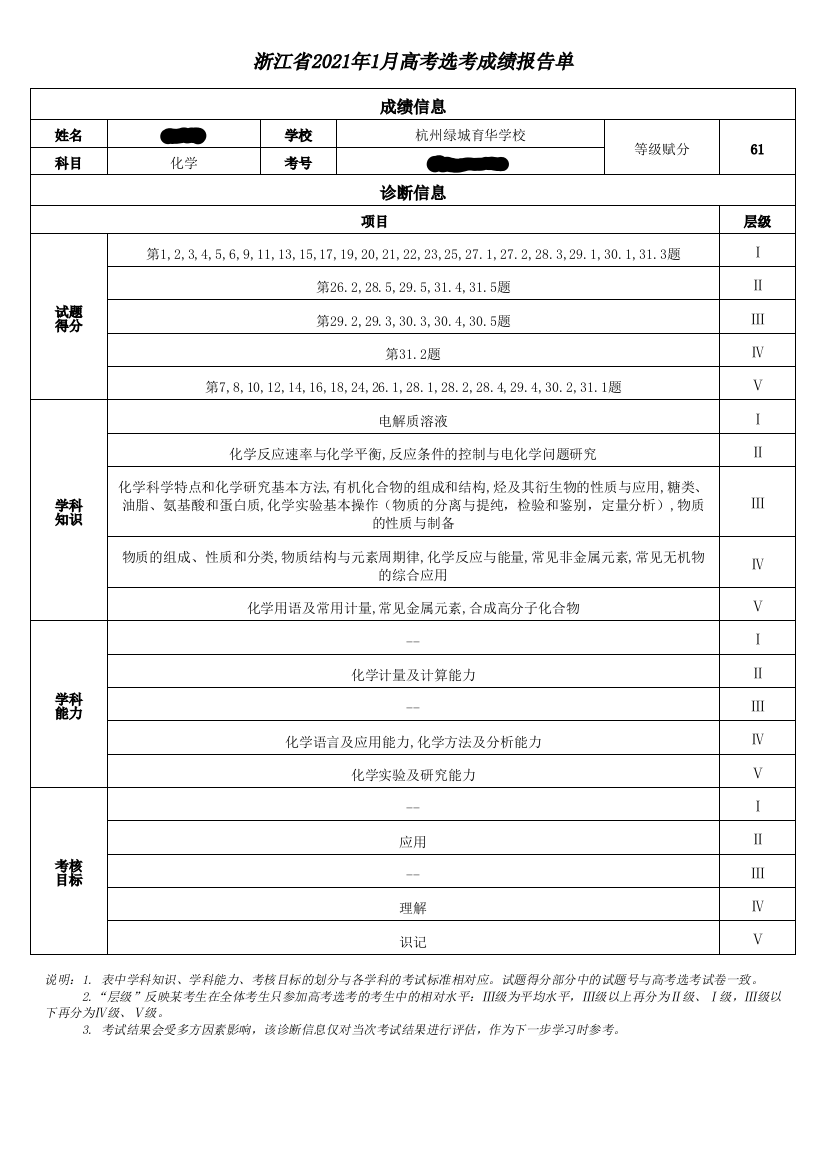
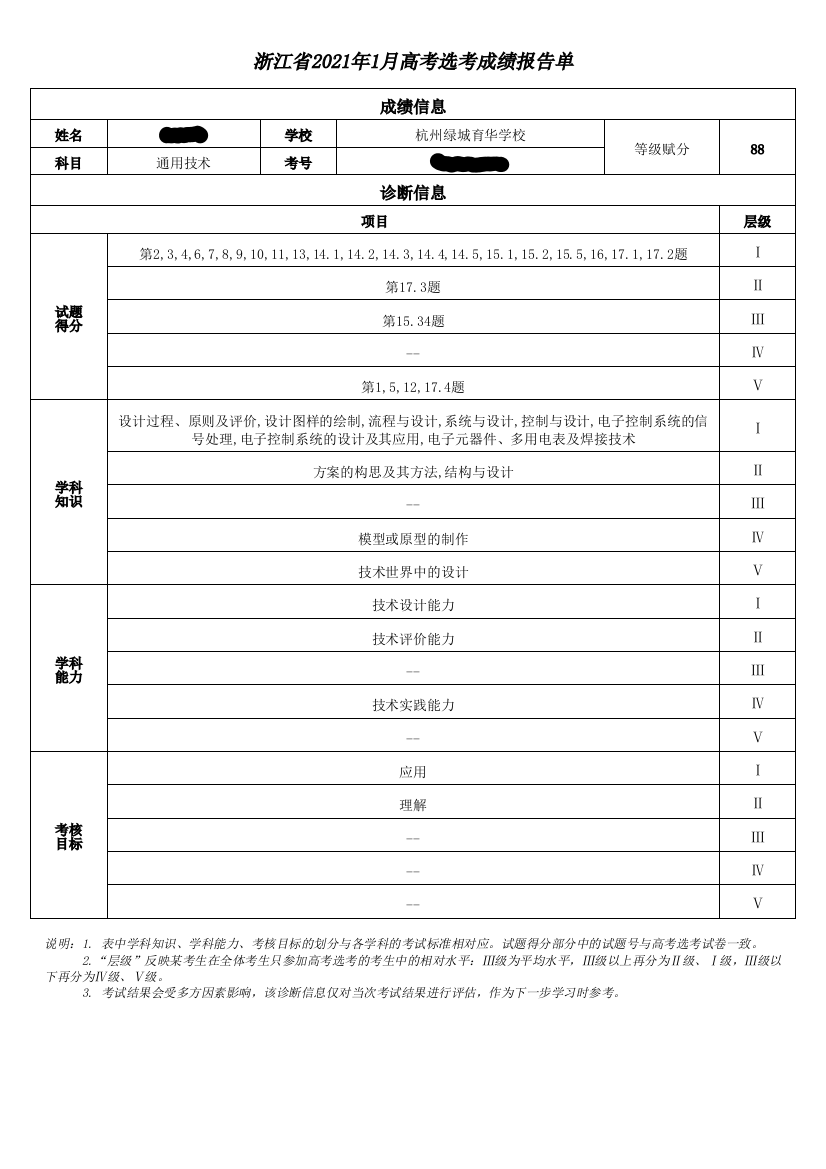
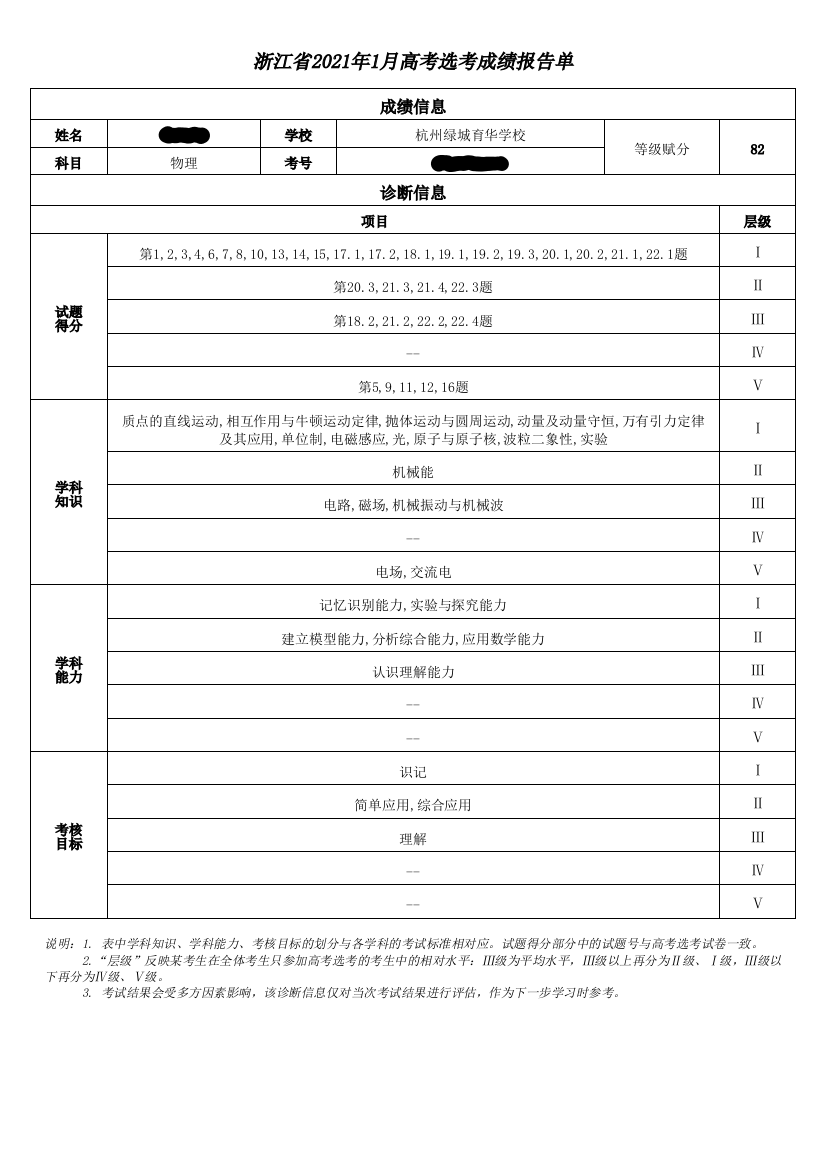
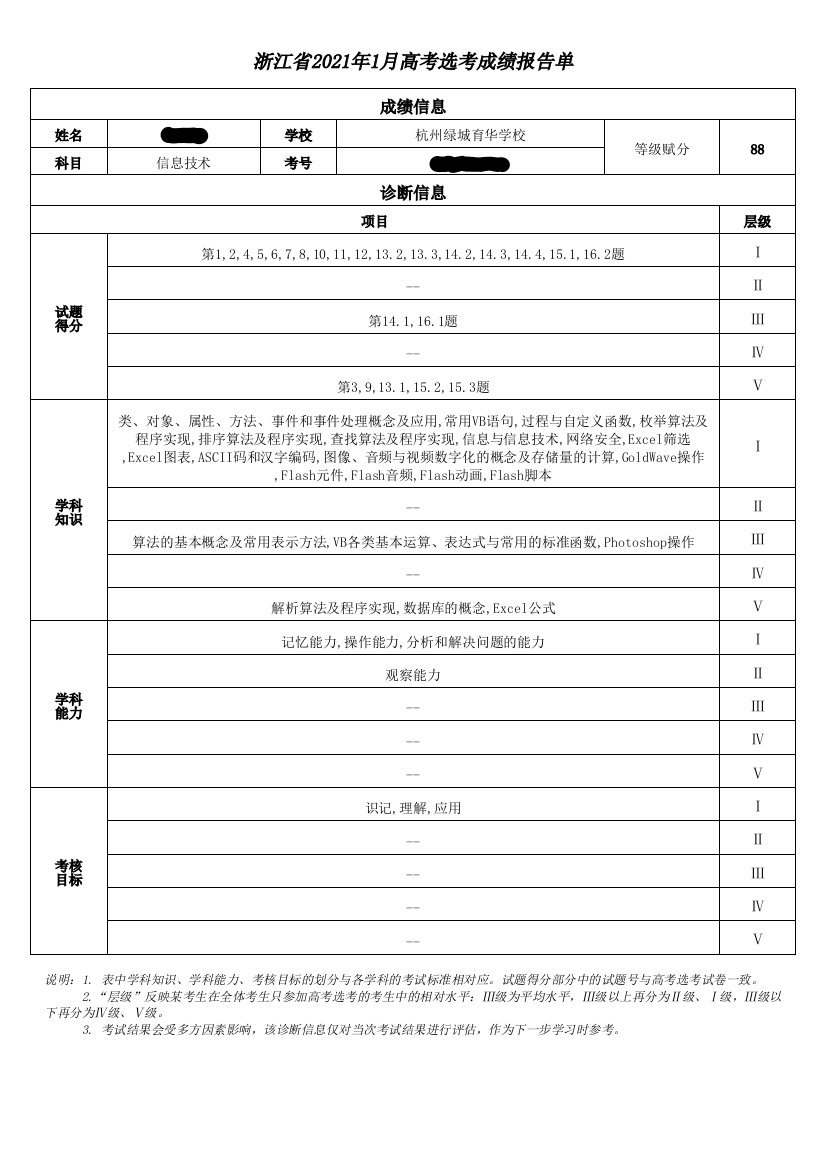
6月某些情況的記錄
語文:作文關鍵詞 有限賽局與無限賽局:高考,柯達;君子不器(借司母鼎的比喻),事敗了但人成功:孔子顏回;事(政治上)成功掩蓋了人物本身:周公,曹丕(四科八体,打破文学为政治服务的藩篱) 作文还是没有好好写字 这次所有字仍是抱笔写的,用了那种毫无生机和艺术感的常见字体 數學:選擇題最後三問沒解出;導數題沒算出任何一小問;圆锥曲线还是没有算完 英語:聽力沒認真聽;續寫第二段沒好好寫 物理:20題沒算數;壓軸題最後一小問沒算數 化學:无机推断没算出;最后5min写出了一个同分异构未能检查前面选项没看完的选择题 技术:通用技术第一题还是不确定选什么;通用技术压轴这次居然没有完全做出来
final 成绩
语 97 数 101 外 131 物 82 化 82 技 88 总 581 位次 5-062944
For reference:
去年SZU位次是15925
特殊类型招生控制线 589分 (相当于去年一段线)
62944/(33.3*10000) = 0.18902102102
6月raw data
语文
97
数学
101
外语
131
选考科目1名称
物理
选考科目1成绩
82
本次选考科目1成绩
76
选考科目2名称
化学
选考科目2成绩
82
本次选考科目2成绩
82
选考科目3名称
技术
选考科目3成绩
88
本次选考科目3成绩
88
特征分
总分
581
本次外语成绩
120
总分位次号
5-062944
浙江省2021年普通高校招生成绩查询结果

高考泄題/疑似高考泄題?
某人告訴我2021年1月的化學有某校出了很多100分,可能有泄題之類的
2021年6月英語七選五,完型,小作文疑似泄題
最後一年選考成績兩年有效,但英語平均分低於去年?
NCEE-like-test-papers
Chemistry
0
- 某混合溶液中\(CrO_4^{2-}\)和\(Cl-\)的浓度均为\(0.010 mol \cdot L^{-1}\)。当慢慢向其中滴入\(AgNO_3\)溶液时,何种离子先生成沉淀?当第二种离子刚刚开始沉淀时,第一种离子的浓度为多少? \(K_{sp}(AgCl)=1.77\times 10^{-10} K_{sp}(Ag_2CrO_4)=1.12\times10^{-12}\)
- 最近,我国一留美化学家参与合成了一种新型炸药(化合物A),它与三硝基甲苯类似,对震动的敏感度比较低,甚至用锤子砸也不会爆炸,但一经引爆就会发生激烈爆炸,据信是迄今为止最烈性的非核爆炸品。该炸药的化学式为\(C_8N_8O_{16}\)。其合成路线如图所示。
(C)  \(C_{12}H_4O_4Cl_4 (B) \)
\(C_{12}H_4O_4Cl_4 (B) \) 
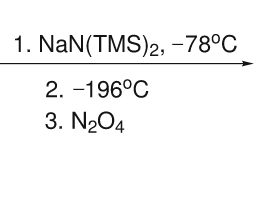
 \(C_8N_8O_{16} (A) \)
\(C_8N_8O_{16} (A) \)
已知:
2-环戊烯酮的结构简式为
请回答:
(1) 已知同种元素在化合物A中毫无区别,其结构简式为__
(2) 已知化合物A中有一种含氧官能团,其名称为__
(3) 下列说法正确的是__
(4) 写出反应A的化学方程式__
(5) 写出符合下列条件的化合物B的3种同分异构体
没有碳碳三键及碳碳双键
(6) 合成化合物A需要用到2-溴代环戊二烯酮,设计由2-环戊烯酮为原料来合成2-溴代环戊二烯酮的路线(用流程图表示,无机试剂任选)
0 - anwser
\(Cl^-\)
\(1.6\times10^{-5}\)
1
- 最近,我国一留美化学家参与合成了一种新型炸药,它与三硝基甲苯类似,对震动的敏感度比较低,甚至用锤子砸也不会爆炸,但一经引爆就会发生激烈爆炸,据信是迄今为止最烈性的非核爆炸品。该炸药的化学式为\(C_8N_8O_{16}\)。其合成路线如图所示。
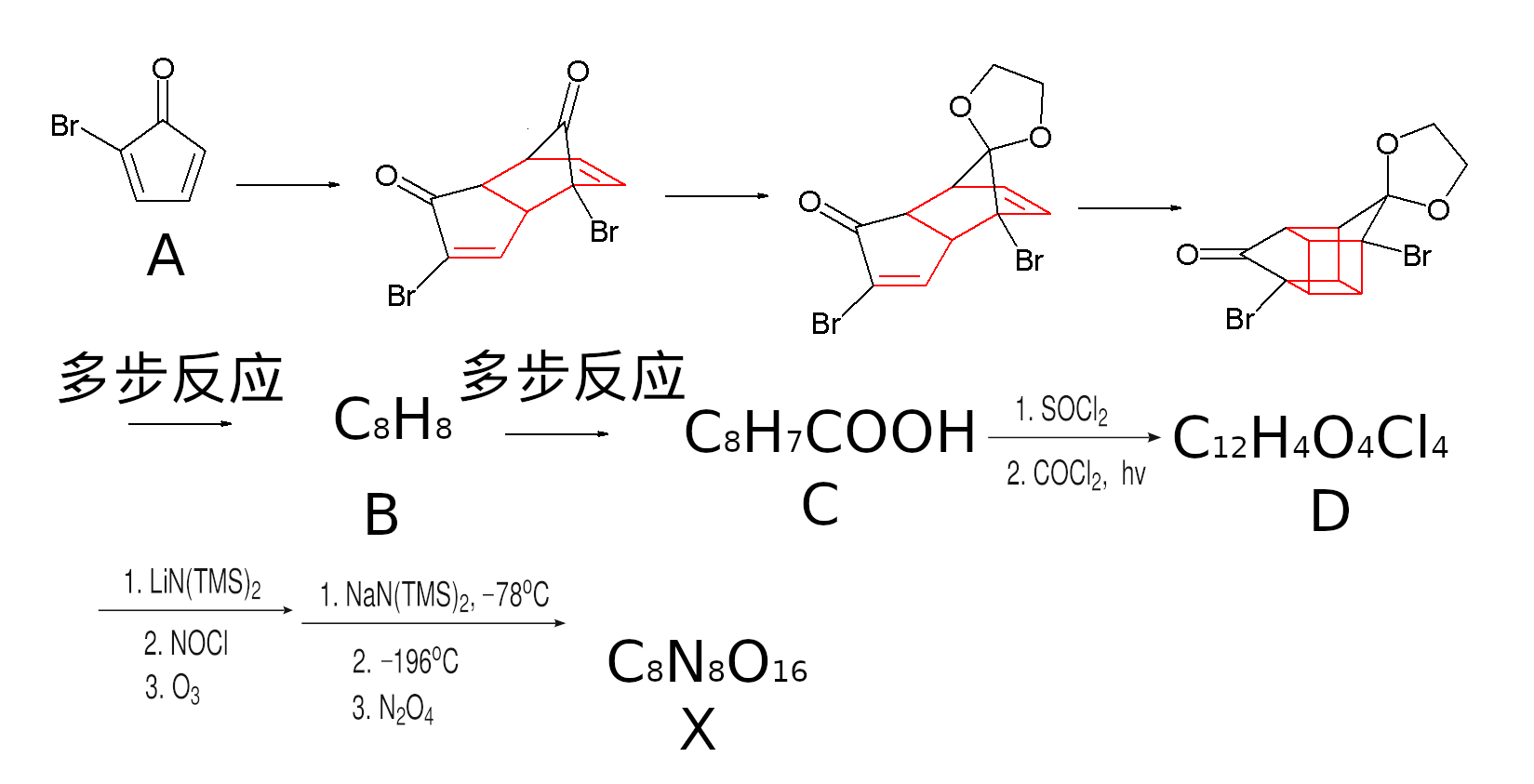
已知
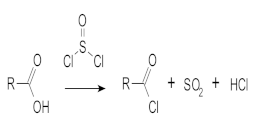
D中所有氯毫无区别
B是烷烃
请回答:
(1) 已知同种元素在化合物B与X中毫无区别,其结构简式分别为__
(2) 已知化合物X中有一种含氧官能团,其名称为__
(4) 写出B到D的所有反应方程式
(5) 写出符合下列条件的化合物X的三种同分异构体
没有碳碳三键及碳碳双键
(6) 设计由2-环戊烯酮为原料来合成2-溴代环戊二烯酮(化合物A)的路线(用流程图表示,无机试剂任选)
TODO-List
literature
literature
基本設定
(用人類一般可理解的方式表示)
universe之表示形式等價與同時出現的因果環,即互爲因果的原因與結果
有了時間維度後不同觀測者可能觀測到不同順序的因及果,因此不同觀測者對其命名方式可能不同
也許等價的設定
時間是一個普通的維度
附加解釋 - 一個可能的版本
有一定因果環後可以得到一個n維空間 因果環之演進(或稱爲因果環之因果環)在n+1維空間上進行
效應
-
允許時空穿梭
-
...
objects
Homemade
jetpack
kill vehicle
https://en.wikipedia.org/wiki/Multiple_Kill_Vehicle
https://web.archive.org/web/20200914135539/https://en.wikipedia.org/wiki/Multiple_Kill_Vehicle
technology reborn
Interferometric modulator display
https://web.archive.org/web/20201001130643/https://en.wikipedia.org/wiki/Interferometric_modulator_display
... / NCEE (gaokao) / college / university ...
Goal
我读大学的主要目的是拖延时间,绝不是深造。
Prepare For National College Entrance Examination
Why?
- Learn to learn
- Learn to teach myself
- Learn to self-correct
- Learn to rest
- Learn to build connections between informations
- Learn to tackle problems in an extremely limited time
- Learn to grasp the possibly hidden meanings from texts written in badly designed languages
- Learn to do number calculation speedily and more importantly accurately
Non-Goals
- Violate a very important original intention, which is not to be admitted to Tsinghua University
- Find a good university
- Diploma
The very important original intention
Why?
The very sentence on the Admission Letter reads: 清华,是你一生的骄傲
Tsinghua is hence strictly prohibited to, and will never, be an attributive of my name.
If, unfortunately, I violate the original intention, I will remove the sentence from the letter as quickly as I can using effective methods, including but not limited to burning
Appendix: blacklist
Banned by me
- 上海科技大学 - no reason
- UCAS - no reason
- SUSTech - no reason
- 杭州电子科技大学 - 非综合性大学; 浙江三位一体初审被拒
這讓我想起了某些歷史:
- 中考時blacklist:学军中学紫金港校区
- 志願等價爲在重高之後直接填了現在的學校
Trying to avoid
- 浙江理工大学 - 浙江三位一体初审被拒
- USTC - 校歌
- THU - above
- 浙大城市学院 & 浙大宁波理工学院 - no reason
Appendix: (曾經的) 有待了解 & 有待选择
現在該附錄爲空。
粵
- SZU
- 中山大学
- cuhksz
- 北师港浸大
蘇
- 九所高校: 南京大学、东南大学、南京师范大学、南京农业大学、河海大学、南京林业大学、南京工业大学、江南大学、江苏大学
浙
無
专业选择 (Draft)
普通双非一本/普通双一流/普通C9:选“上课耽误学习”的计算机类 以便有尽量多的时间学习? 等等...我在一個很多人把一本作爲目標的高中? whatever 其他:具体分析
Life during which: Sleep
get up at normally 5:50AM to 6:20AM
Do not sleep between 10:30 PM to 11:30 PM according to the 90-minute sleep cycle theory
但是也不要故意拖延到特定时间,否则可能会发生像May 30 2021那样的事故。
Do not do midday rest if unable to do it
Do not head to bed suddenly without preparations
如果沒有讓自己平靜下來,或者太興奮或者太...,會發現自己40min以後並沒有入睡。
有时会发现自己困得无法犯困。
Un titled
价格
最贵的,最耗費時間的是应试教育与学习应试技巧,而不是學習。
留学
尚未發現什麼東西是必須留學才能學習的。如果不是爲了證書,留國自學最好。(這只是一個借口。真實的原因包含COVID-19,開銷,等等等等) 不用担心没人能教得了自己。自己能教別人。
無論如何,2021年6月就可以學習了(希望如此),岂不快哉。
These days could very well be an end of an era, an era when I can not learn.
“马上就可以上一个差或者更差的大学,发现自己比老师厉害几千倍,没人能教得了我...” 2021年5月28日,最后一节高中数学课上(课前),我兴奋地和同桌讨论着美好的未来。同桌提醒我还可能可以得到奖学金呢!
xyh 曾語及IUB,稱其爲PL之天堂。
如果能教會足夠多人,或許再建一個社團,也許可以也把一所中國大陸的差大學變成PL的天堂。
還有2日,或還有一日或數小時,但仍不能靜心應試。那就繼續學習吧
戏填正气歌
余於中國。坐一大陸。其廣深五百萬。当此夏日,诸气萃然:题如长蛇,瞬息试毕,时则为phy气;穷究蜗角,末节为本,时则为che气;学古探微,或VB,或Adobe Flash,腐气日出,时则为tech气;...;阴阳激荡,昔明纷至,時則爲心氣;疊是數氣。當之者鮮不為厲。而予以孱弱。俯仰其間。於茲數年矣。幸而無恙。而誠非有養致然。彼氣有七。吾氣無一。以無敵七。吾何以患焉。(吾何其患焉。/吾何患焉。)
dustbin
objects
droplets-3D-display
讓幾乎沒有表面張力的大量液滴從指定位置滴落。液滴下方有裝置在特定的時間發出激光,以便在三維空間內某個特定的點顯示特定的顏色。
Some more files
inner
lang
nautural
zh
computing zh_CN <-> zh_TW
| en_US | zh_CN | zh_TW |
|---|---|---|
| 英文 | 大陆 | 台湾 |
| abstract | 抽象的 | 抽象的 |
| abstraction | 抽象性、抽象件 | 抽象性、抽象件 |
| access | 访问 | 存取、取用 |
| access level | 访问级别 | 存取級別 |
| access function | 访问函数 | 存取函式 |
| adapter | 适配器 | 配接器 |
| address | 地址 | 地址 |
| address-of operator | 取地址操作符 | 地址連算子 |
| aggregation | 聚合 | 聚合 |
| algorithm | 算法 | 演算法 |
| allocate | 分配 | 配置 |
| allocator | 分配器 | 配置器 |
| application | 应用程序 | 應用程式 |
| architecture | 体系结构 | 體系結構 |
| argument | 实参 | 引數 |
| array | 数组 | 陳列 |
| arrow operator | 箭头操作符 | 箭頭連算子 |
| assembly language | 汇编语言 | 組合語言 |
| assert | 断言 | 斷言 |
| assign | 赋值 | 賦值 |
| assignment operator | 赋值操作符 | 賦值連算子 |
| base class | 基类 | 基礎類別 |
| base type | 基类型 | 基礎型別 |
| binary search | 二分查找 | 二分搜尋 |
| binary tree | 二叉树 | 二元樹 |
| binary operator | 二元操作符 | 二元連算子 |
| binding | 绑定 | 綁定 |
| bit | 位 | 位元 |
| block | 区块 | 區塊 |
| boolean | 布尔值 | 布林值 |
| breakpoint | 断点 | 中斷點 |
| build | 建置 | 建置 |
| build-in | 内置 | 內建 |
| bus | 总线 | 匯流排 |
| byte | 字节 | 位元組 |
| cache | 高速缓存(区) | 快取(區) |
| call | 调用 | 呼叫 |
| callback | 回调 | 回呼 |
| call operator | call 操作符 | call 連算子 |
| character | 字符 | 字元 |
| child class | 子类 | 子類別 |
| class | 类 | 類別 |
| class template | 类模板 | 類別模板 |
| client | 客户 | 客戶 |
| code | 代码 | 程式碼 |
| compatible | 兼容 | 相容 |
| compile time | 编译期 | 編譯期 |
| compiler | 编译器 | 編譯器 |
| component | 组件 | 組件 |
| composition | 复合 | 複合 |
| concrete | 具象的 | 具象的 |
| concurrent | 并发 | 並行 |
| configuration | 配置 | 組態 |
| connnection | 连接 | 連接 |
| constraint | 约束 | 約束 |
| constant | 常量 | 常數 |
| constructor | 构造函数 | 建構式 |
| copy(动词) | 拷贝 | 拷貝,複製 |
| copy(名词) | 复件,副本 | 復件,副本 |
| create | 创建 | 產生,建立,生成 |
| custom | 定制 | 訂製,自定 |
| data | 数据 | 資料 |
| database | 数据库 | 資料庫 |
| data member | 成员变量 | 成員變數 |
| data structure | 数据结构 | 資料結構 |
| debug | 调试 | 除錯 |
| debugger | 调试器 | 除錯器 |
| declaration | 声明式 | 宣告式 |
| default | 缺省 | 預設 |
| definition | 定义式 | 定義式 |
| delegate | 委托 | 委託 |
| dereference | 提领 | 提領 |
| derived class | 派生类 | 衍生類別 |
| design pattern | 设计模式 | 設計範式 |
| destroy | 销毁 | 銷燬 |
| destructor | 析构函数 | 解夠式 |
| directive | 指示符 | 指令 |
| document | 文档 | 文件 |
| dynamic binding | 动态绑定 | 動態綁定 |
| entity | 物体 | 物體 |
| encapsulation | 封装 | 封裝 |
| enum | 枚举 | 列舉 |
| equality | 相等 | 相等 |
| equivalence | 等价 | 等價 |
| evaluate | 核定,核算 | 核定,核算 |
| exception | 异常 | 異常 |
| explicit | 显式 | 顯式,明白的 |
| expression | 表达式 | 算式 |
| file | 文件 | 檔案 |
| framework | 框架 | 框架 |
| full specialization | 全特化 | 全特化 |
| function | 函数 | 函式 |
| function object | 函数对象 | 函式物件 |
| function template | 函数模板 | 函式模板 |
| generic | 泛型,泛化,一般化 | 泛型,泛化,一般化 |
| global | 全局的 | 全域的 |
| handle | 句柄 | 識別號,權柄 |
| handler | 处理函数 | 處理函式 |
| hash table | 哈希表,散列表 | 雜湊表 |
| header | 头文件 | 表頭檔 |
| heap | 堆 | 堆積 |
| hierarchy | 继承体系 | 繼承體系 |
| identifier | 标识符 | 識別字,識別符號 |
| implement | 实现 | 實作 |
| implicit | 隐喻的,隐式 | 隱喻的,隱時 |
| information | 信息 | 資訊 |
| inheritance | 继承 | 繼承 |
| inline | 内联 | 行內 |
| initialization list | 初值列 | 初值列 |
| initialize | 初始化 | 初始化 |
| instance | 实体 | 實體 |
| instantiate | 具现化,实体化 | 具現化,實體化 |
| interface | 接口 | 介面 |
| Internet | 互联网 | 網際網路 |
| interpreter | 解释器 | 直譯器 |
| invatiants | 恒常性 | 恆常性 |
| invoke | 调用 | 喚起 |
| iterator | 迭代器 | 迭代器 |
| library | 程序库 | 程式庫 |
| linker | 连接器 | 連結器 |
| literal | 字面常量 | 字面常數 |
| list | 链表 | 串列 |
| load | 装载 | 載入 |
| local | 局部的 | 區域的 |
| lock | 机锁 | 機鎖 |
| loop | 循环 | 迴圈 |
| lvalue | 左值 | 左值 |
| macro | 宏 | 巨集 |
| member | 成员 | 成員 |
| member function | 成员函数 | 成員函式 |
| memory | 内存 | 記憶體 |
| memory leak | 内存泄漏 | 記憶體泄漏 |
| meta- | 元- | 超- |
| meta-programming | 元编程 | 超編程 |
| modeling | 塑模 | 模塑 |
| module | 模块 | 模組 |
| modifier | 修饰符 | 飾詞 |
| multi-tasking | 多任务 | 多工 |
| namespace | 命名空间 | 命名空間 |
| native | 固有的 | 原生的 |
| nested | 嵌套 | 嵌套,巢狀 |
| object | 对象 | 物件 |
| object based | 基于对象的 | 植基於物件,以物件爲基礎 |
| object model | 对象模型 | 物件模型 |
| object oriented | 面向对象 | 物件導向 |
| operand | 操作数 | 連算元 |
| operating system | 操作系统 | 作業系統 |
| operator | 操作符 | 連算子 |
| overflow | 溢出 | 上限溢位 |
| overhead | 额外开销 | 額外開銷 |
| overload | 重载 | 重載 |
| override | 覆写 | 覆寫 |
| package | 包 | 套件 |
| parallel | 并行 | 平行 |
| parameter | 参数,形参 | 參數 |
| parent class | 父类 | 父類別 |
| parse | 解析 | 解析 |
| partial specialization | 偏特化 | 偏特化 |
| pass by reference | 按址传递 | 傳址 |
| pass by value | 按值传递 | 傳值 |
| pattern | 模式 | 範式 |
| pointer | 指针 | 指標 |
| polymorphism | 多态 | 多型 |
| preprocessor | 预处理器 | 前處理器 |
| 打印 | 列印 | |
| printer | 打印机 | 印表機 |
| process | 进程 | 行程 |
| program | 程序 | 程式 |
| programmer | 程序员 | 程式員 |
| programming | 编程 | 編程 |
| project | 项目 | 專案 |
| pseudo code | 伪码 | 僞碼 |
| quality | 质量 | 品質 |
| queue | 队列 | 佇(zhu |
| raw | 原始的,未经处理的 | 原始的,未經處理的 |
| recursive | 递归 | 遞迴 |
| refer to | 指向 | 指向 |
| reference | 引用 | 參考,引用 |
| regular expression | 正则表达式 | 正則算式 |
| resolve | 解析 | 決議 |
| return | 返回 | 回返,傳回 |
| return type | 返回类型 | 回返類別 |
| return value | 返回值 | 回返值 |
| runtime | 运行期 | 執行期 |
| rvalue | 右值 | 右值 |
| save | 存储 | 儲存 |
| schedule | 调度 | 排程 |
| scheduler | 调度器 | 排程器 |
| scope | 作用域 | 作用域 |
| search | 查找 | 搜尋 |
| semantics | 语义 | 語意 |
| signature | 签名 | 簽名 |
| smart pointer | 智能指针 | 智慧型指標 |
| specialization | 特化 | 特化 |
| source | 源码 | 源碼 |
| stack | 栈 | 堆疊 |
| standard library | 标准程序库 | 標準程式庫 |
| statement | 语言 | 述句 |
| static | 静态的 | 靜態的 |
| string | 字符串 | 字串 |
| subtype | 子类型 | 子類別 |
| support | 支持 | 支援 |
| template | 模板 | 範本 |
| temporary object | 临时对象 | 暫時物件 |
| text | 文本 | 文字 |
| thread | 线程 | 緒程 |
| thread safe | 多线程安全 | 多緒安全 |
| throw | 抛,掷 | 拋 |
| token | 语汇单元 | 語彙單元 |
| type | 类型 | 型別 |
| unary function | 单参函数 | 一元函式 |
| underflow | 下溢 | 下限溢位 |
| user | 用户 | 用戶 |
| user interface | 用户界面 | 用戶介面 |
| value | 值,数值 | 值,數值 |
| variable | 变量 | 變數 |
| vector | 矢量 | 向量 |
| virtual function | virtual函数 | virtual函式 |
| virtual machine | 虚拟机 | 虛擬機器 |
References
os
Archlinux
Installation
... # connect to the internet and configure partitions
timedatectl set-ntp true
pacstrap /mnt base
genfstab -U /mnt >> /mnt/etc/fstab
arch-chroot /mnt
pacman -S linux-lts linux-firmware nano man-db man-pages
ln -sf /usr/share/zoneinfo/$Region/$City /etc/localtime
hwclock --systohc
nano /etc/locale.gen # Uncomment `en_US.UTF-8 UTF-8` in /etc/locale.gen
locale-gen
echo 'LANG=en_US.UTF-8' > /etc/locale.conf
echo localhost > /etc/hostname
cat << 'EOF' >> /etc/hosts
127.0.0.1 localhost
::1 localhost
EOF
passwd
pacman -S sudo
useradd -m user
passwd user
echo 'user ALL=(ALL) ALL' > /etc/sudoers.d/user
chmod 440 /etc/sudoers.d/user
... # configure bootloader
umount -R /mnt
reboot
pacman -S intel-ucode
Btrfs subvolumes with swap LVM_on_LUKS
fdisk /dev/sda # sda1: EFI(512 M, type: EFI System) sda2: rest
cryptsetup luksFormat --label=arch_os /dev/sda2
cryptsetup open /dev/sda2 cryptlvm
pvcreate /dev/mapper/cryptlvm
vgcreate CryptVolGrp /dev/mapper/cryptlvm
lvcreate -L 8G CryptVolGrp -n swap
lvcreate -l 100%FREE CryptVolGrp -n root
mkswap /dev/CryptVolGrp/swap
swapon /dev/CryptVolGrp/swap
mkfs.btrfs /dev/CryptVolGrp/root
mount -o compress=zstd /dev/CryptVolGrp/root /mnt
btrfs subvolume create /mnt/@
btrfs subvolume create /mnt/@home
btrfs subvolume create /mnt/@snapshots
btrfs subvolume create /mnt/@home@snapshots
umount /mnt
mount -o compress=zstd,subvol=@ /dev/CryptVolGrp/root /mnt
mkdir /mnt/.snapshots
mount -o compress=zstd,subvol=@snapshots /dev/CryptVolGrp/root /mnt/.snapshots
mkdir /mnt/home
mount -o compress=zstd,subvol=@home /dev/CryptVolGrp/root /mnt/home
mkdir /mnt/home/.snapshots
mount -o compress=zstd,subvol=@home@snapshots /dev/CryptVolGrp/root /mnt/home/.snapshots
mkdir /mnt/boot
mkfs.fat -F32 /dev/sda1
mount /dev/sda1 /mnt/boot
... # install Arch
arch-chroot /mnt
pacman -S lvm2 btrfs-progs
nano /etc/mkinitcpio.conf # HOOKS: insert `encrypt` and `lvm2` between `block` and `filesystems`; `keyboard` before `encrypt` # BINARIES=("/usr/bin/btrfs")
mkinitcpio -P
pacman -S grub efibootmgr
grub-install --target=x86_64-efi --efi-directory=/boot --bootloader-id=GRUB
# ls -lh /dev/disk/by-uuid/ | grep sda2 | awk '{print $9;}' >> /etc/default/grub # For the convenience of editing
nano /etc/default/grub # add the following kernel parameter: `cryptdevice=UUID=${device-UUID}:cryptlvm` # Ctrl+K: cut this line;Ctrl+U: paste # or: `cryptdevice=LABEL=arch_os:cryptlvm`
grub-mkconfig -o /boot/grub/grub.cfg
or ... systemd-boot - ArchWiki
bootctl --path=/boot install
cat << 'EOF' > /usr/share/libalpm/hooks/90_USER_systemd-boot.hook
[Trigger]
Type = Package
Operation = Upgrade
Target = systemd
[Action]
Description = Upgrading systemd-boot ...
When = PostTransaction
Exec = /usr/bin/bootctl update
EOF
cat << 'EOF' > /boot/loader/loader.conf
timeout 4
console-mode max
default arch.conf
editor yes
EOF
cat << 'EOF' > /boot/loader/entries/arch.conf
title Arch
linux /vmlinuz-linux-lts
initrd /intel-ucode.img
initrd /initramfs-linux-lts.img
options cryptdevice=LABEL=arch_os:cryptlvm root=/dev/CryptVolGrp/root rootflags=subvol=@ rw
EOF
GNOME
pacman -S gnome
systemctl enable gdm
systemctl enable NetworkManager
systemctl enable bluetooth
References
GNOME - ArchWiki GDM - ArchWiki
KDE
pacman -S plasma-meta plasma-wayland-session
systemctl enable sddm
systemctl enable NetworkManager
systemctl enable bluetooth
References
CJK Fonts and IME
sudo pacman -S noto-fonts-cjk ibus-rime
mkdir -p ~/.config/ibus/rime
cat << 'EOF' > ~/.config/ibus/rime/default.custom.yaml
patch:
schema_list:
- schema: terra_pinyin
EOF
# Optional: install plum
git clone --depth 1 https://github.com/rime/plum.git
cd plum
bash rime-install :preset
snapper
pacman -S snap-pac rsync snapper
umount /.snapshots
rmdir /.snapshots
snapper -c root create-config /
rm -r /.snapshots
mkdir /.snapshots
mount /.snapshots
umount /home/.snapshots
rmdir /home/.snapshots
snapper -c home create-config /home
rm -r /home/.snapshots
mkdir /home/.snapshots
mount /home/.snapshots
systemctl enable snapper-timeline.timer
systemctl enable snapper-cleanup.timer
cat << 'EOF' | tee /usr/share/libalpm/hooks/50_USER_bootbackup.hook
[Trigger]
Operation = Upgrade
Operation = Install
Operation = Remove
Type = Package
Target = linux*
Target = ${PACKAGES SUCH AS grub}
[Action]
Depends = rsync
Description = Backing up /boot...
When = PreTransaction
Exec = /usr/bin/rsync -a --delete /boot /.bootbackup
EOF
References
fcitx-googlepinyin
sudo pacman -S fcitx-googlepinyin fcitx-configtool fcitx-gtk2 fcitx-gtk3 fcitx-qt5
cat << 'EOF' > ~/.pam_environment
GTK_IM_MODULE=fcitx
QT_IM_MODULE=fcitx
XMODIFIERS=@im=fcitx
EOF
References
fedora
updating
sudo dnf clean all && sudo dnf upgrade && sudo dnf remove $(dnf repoquery --installonly --latest-limit=-1 -q) && sudo dnf clean all
parabola openrc
Installation
https://wiki.parabola.nu/Installation_Guide
... # connect to the internet and configure partitions
pacman -Sy archlinux-keyring archlinuxarm-keyring parabola-keyring
pacman -U https://www.parabola.nu/packages/core/i686/archlinux32-keyring-transition/download/
pacstrap /mnt base elogind linux-libre-lts linux-libre-firmware
genfstab -p /mnt >> /mnt/etc/fstab
arch-chroot /mnt
pacman -S nano
ln -sf /usr/share/zoneinfo/$Region/$City /etc/localtime
nano /etc/locale.gen # Uncomment `en_US.UTF-8 UTF-8` in /etc/locale.gen
locale-gen
echo 'LANG=en_US.UTF-8' > /etc/locale.conf
#echo 'hostname="localhost"' > /etc/conf.d/hostname # by default
cat << 'EOF' >> /etc/hosts
127.0.0.1 localhost
::1 localhost
EOF
nano /etc/pacman.conf # enable nonsystemd
pacman -S sudo
useradd -m user
passwd user
echo 'user ALL=(ALL) ALL' > /etc/sudoers.d/user
chmod 440 /etc/sudoers.d/user
passwd # root's password is "" by default!
... # configure bootloader
umount -R /mnt
reboot
Partitions
Utils
https://wiki.parabola.nu/LVM
modprobe dm-mod
vgscan
vgchange -ay
pacman -Sy cryptsetup
Main
https://wiki.parabola.nu/OpenRC
fdisk /dev/sda # sda1: EFI(512 M, type: EFI System) sda2: rest
cryptsetup luksFormat --label=parabola_os /dev/sda2
cryptsetup open /dev/sda2 cryptlvm
pvcreate /dev/mapper/cryptlvm
vgcreate CryptVolGrp /dev/mapper/cryptlvm
lvcreate -L 8G CryptVolGrp -n swap
lvcreate -l 100%FREE CryptVolGrp -n root
mkswap /dev/CryptVolGrp/swap
swapon /dev/CryptVolGrp/swap
mkfs.btrfs /dev/CryptVolGrp/root
mount -o compress=zstd /dev/CryptVolGrp/root /mnt
btrfs subvolume create /mnt/@
btrfs subvolume create /mnt/@home
umount /mnt
mount -o compress=zstd,subvol=@ /dev/CryptVolGrp/root /mnt
mkdir /mnt/home
mount -o compress=zstd,subvol=@home /dev/CryptVolGrp/root /mnt/home
mkdir /mnt/boot
mkfs.fat -F32 /dev/sda1
mount /dev/sda1 /mnt/boot
... # install parabola
arch-chroot /mnt
pacman -S lvm2 btrfs-progs cryptsetup
nano /etc/mkinitcpio.conf # HOOKS: insert `encrypt` and `lvm2` between `block` and `filesystems`; `keyboard` before `encrypt` # BINARIES=("/usr/bin/btrfs")
mkinitcpio -P
pacman -S lvm2-openrc cryptsetup-openrc
rc-update add lvm boot
rc-update add dmcrypt boot
Grub
pacman -S grub efibootmgr
grub-install --target=x86_64-efi --efi-directory=/boot --bootloader-id=GRUB
nano /etc/default/grub # add the following kernel parameter: `cryptdevice=LABEL=parabola_os:cryptlvm`
grub-mkconfig -o /boot/grub/grub.cfg
Gnome
https://wiki.parabola.nu/OpenRC https://wiki.parabola.nu/GNOME
pacman -S gnome openrc-desktop lxdm
rc-update add NetworkManager elogind default
rc-update add elogind default
rc-update add dbus default
nano /etc/conf.d/xdm # DISPLAYMANAGER="lxdm"
rc-update add xdm default
Basic Gui Apps
pacman -S icecat xfce4-terminal
Qubes OS
hardware without IOMMU (QubesOS R4.0)
qvm-prefs --set sys-net virt_mode pv
qvm-prefs --set sys-usb virt_mode pv
References
Running Qubes OS 4.0.1 under KVM
Fedora30
Remove unnecessary kernel in TemplateVM
sudo dnf remove kernel kernel-modules kernel-core kernel-debug-devel && sudo dnf install linux-firmware
ibus
echo '
# ibus
export GTK_IM_MODULE=ibus
export XMODIFIERS=@im=ibus
export QT_IM_MODULE=ibus
export QT4_IM_MODULE=ibus
ibus-daemon -d
' >> ~/.profile &&
ibus-setup
fcitx-googlepinyin
Share State Among Window = No
Use System Tray Icon = false
Status Panel Hide Mode = Hide
archlinux
cat << 'EOF' > ~/.pam_environment
GTK_IM_MODULE=fcitx
QT_IM_MODULE=fcitx
XMODIFIERS=@im=fcitx
EOF
Docker
echo '#Docker
systemctl start docker
chown user /var/run/docker.sock' | sudo tee -a /rw/config/rc.local &&
sudo mkdir -p /rw/config/qubes-bind-dirs.d &&
echo "binds+=( '/var/lib/docker' )
binds+=( '/etc/docker' )" | sudo tee /rw/config/qubes-bind-dirs.d/50_user_docker.conf &&
sudo systemctl start docker &&
sudo /usr/lib/qubes/init/bind-dirs.sh
Debian10
Remove unnecessary kernel in TemplateVM
sudo apt purge cryptsetup-initramfs linux-image-4.19.0-6-amd64 linux-image-amd64 linux-headers-4.19.0-6-amd64 linux-headers-amd64 linux-headers-4.19.0-6-common linux-kbuild-4.19
Docker
echo '#Docker
chown user /var/run/docker.sock' | sudo tee -a /rw/config/rc.local &&
sudo mkdir -p /rw/config/qubes-bind-dirs.d &&
echo "binds+=( '/var/lib/docker' )
binds+=( '/etc/docker' )" | sudo tee /rw/config/qubes-bind-dirs.d/50_user_docker.conf &&
sudo /usr/lib/qubes/init/bind-dirs.sh
anbox(StandaloneVM)
sudo apt install snapd adb android-sdk-platform-tools-common
sudo snap install --devmode --beta anbox
echo deb http://ppa.launchpad.net/morphis/anbox-support/ubuntu disco main | sudo tee /etc/apt/sources.list.d/morphis-ubuntu-anbox-support.list
sudo apt-key adv --keyserver keyserver.ubuntu.com --recv-keys 21C6044A875B67B7
sudo apt update && sudo apt install anbox-modules-dkms
## Upgrade system: ## sudo apt update && sudo apt full-upgrade && sudo apt autoremove && sudo apt clean && sudo snap refresh --beta --devmode anbox
麟卓
sudo apt update && sudo apt full-upgrade && sudo apt autoremove && sudo apt clean
wget -O - https://liquidtelecom.dl.sourceforge.net/project/xdroid/2.7/xDroidInstall-x86_64-v2.7000-20190621155253.tar.gz | tar -xzv
./xDroidInstall-x86_64/install.sh
rm -fr xDroidInstall-x86_64
Nix
sudo mkdir -p /rw/config/qubes-bind-dirs.d &&
echo "binds+=( '/nix' )" | sudo tee /rw/config/qubes-bind-dirs.d/50_user_nix.conf &&
sudo mkdir /nix &&
sudo /usr/lib/qubes/init/bind-dirs.sh &&
sudo chown -R user /nix &&
curl https://nixos.org/nix/install | sh
updating
dom0
sudo qubes-dom0-update && sudo dnf remove $(dnf repoquery --installonly --latest-limit=-1 -q)
debian/ubuntu
sudo apt update && sudo apt full-upgrade && sudo apt autoremove && sudo apt clean
fedora
sudo dnf clean all && sudo dnf upgrade && sudo dnf remove $(dnf repoquery --installonly --latest-limit=-1 -q) && sudo dnf clean all
Windows 10
remove built-in apps/functions
How to Uninstall Windows 10’s Built-in Apps (and How to Reinstall Them)
How to Disable Cortana in Windows 10
How to Permanently Disable The Touch Keyboard In Windows 8 and 10
UNIX-like without Windows Subsystem for Linux
Adding Git-Bash to the new Windows Terminal
util
aria2
aria2c -s65536 -j65536 -x16 -k1M ...
inner posts
ㄗㄠˋ ㄑㄧˊ's inner universe
20200623夏令營事件
20200623之前一周,曰有夏令營之項目,約十日,約暑假之半。奉自願報名之原則,費用人民幣4000(注:約當時公辦高中二學期之學費)。因住宿制,與20200622周一記報名者。初,不到一半。逐推銷其項目曰將請名師來校,若有願報名者可旦日班會課告之。後叫標準化分數較高之同學某、某,獨與之推銷項目,二人皆允之。
其校近乎私營,各作爲皆或似僅爲經濟之私利。或曰莫可得回扣,故定之目標人數而不計手段推之。然此臆造也,不足爲信。
20200623,某:汝等知初中之費用否?一萬某人民幣。高中支出各費用後有虧損。然皆不信也。
班會課,先言高考之改革,後言或懼見我,故行逆向之思維,若有不願者至某室找我。
某與某去。某反,摔門入,口中有辱罵之詞。須臾,某歌而入,復述其言曰:“若不去,日後周日補課勿來。”後某亦去而反,旁人問之曰:“是否亦不願去?”對曰:“有什麼辦法呢?”
Category Theory
範疇描述物件及態射及其是否相等的规则。
我的高中
前
初三前半段時光,排名尚在後二分之一。因爲分層的緣故,上課宜小憩。 而初三最後百日,友人曾說我就像已保送,即使實際上參與保送的資格都沒有。
主
學校气势恢弘、风格雅致,环境优美、设施齐备
食堂
食堂素來十分環保,按其風格一分子都不會浪費。
- 友人曾說
在我們體訓隊的時間來食堂,你就能知道明天早上會吃到什麼。 - 大約2020年6月的某段時期筷子上有少量油污,我想大概是爲了環保。
制度
寄宿制,十四小時制(AM7:00至PM9:00)
住宿
住宿的環境很好,我曾被宣傳住過大學的寢室就會懷念這裏的寢室的。這裏的邏輯是無比嚴密的(向更差的看齐)
後
我在任何學科都沒有突出才能或表現,因爲我沒有獎項。按計劃我會純拼標準化分數考大學。
夏令營
與其宣傳略有異。所謂晚間活動皆不存在而所謂特級教師多爲本校。盈利爲目的之機構,此等變化皆可理解,畢竟已爲其學生,其處壟斷之地位,如此已極善矣。況其爲賣方之市場,或曾言:“不缺一個。”
休業式之日,公布課表。初,科目標以正常之名稱。然须臾易以第二版,以“數海搏擊”代“數學”,“電影文學鑑賞”代“語文”雲者。語、數、英各兩節課,他科各一節,如此自8:00自16:50。語、數、英以成績爲分班之根據,是以數爲之分入最差之班,刪所謂難題,故餘其時常小憩。
餘未通背書之技,故願以一理科易一記憶爲主體之所謂理科。申請換科夏令營,不許,曰年級中數人,皆不許也。或擅自爲之,爲某所辱罵。餘立世之道,不自取辱也,故不從之。
既爲夏令營,原校規不再適用。學生之權利來源於學校,學生接受賦予。或援引校規:“最後一天可不穿校服”,某斥之曰 是非上課
notes
learning to learn
_
使用所學的東西
描述
練習
feynman technique
命名起源
後人名之也。
_
Teaching<->Learning
使用普通的,可視化的,描述性的類比性的語言描述簡化的事物之特徵。
與此同時可知自己未曾了解之處,以便fix
Examples
Set -> Ball
有相嵌的球,完全獨立的球...
Different Sets
附
爲了達成此目標,勢必須分解其特徵,而個分點須有所聯系。
life algorithm
Slow motion multitasking
自行發明之後找到的類似而更加清晰的描述
TED Talk - A powerful way to unleash your natural creativity
philosophy
道德經
天之道,損有餘而補不足。 人之道則不然,損不足以奉有餘。
生物以负熵爲食,而整個系統熵增。
高考志愿
Draft
浙江大学 ~666
河海大学、江苏大学、深圳大学、海南大学、宁波大学、浙江工业大学 ~620 ~640
南京大学、东南大学、南京师范大学、南京农业大学、河海大学、南京林业大学、南京工业大学、江南大学、江苏大学
中国计量大学、浙大...、... ~600
Draft 2
Cat 0 - 双
- 宁波大学 中外合作 596
Cat 1 - ZJU - 立交桥(好像已经没了) - 师资
not recommended
- 浙大城市学院
- 浙大宁波理工学院
Cat 2 - 上海地区 - 上海插班生考试
华东政法大学、上海第二工业大学、上海电机学院、上海电力大学、上海对外经贸大学、上海工程技术大学、上海海关学院、上海海事大学、上海理工大学、上海立信会计金融学院、上海商学院、上海师范大学、上海健康医学院、上海应用技术大学、上海政法学院
- 上海体育学院 594 53755 一流学科建设高校
Cat 3 - 中外合作
- 宁波诺丁汉大学
- 北师港浸大
- 温州肯恩大学
- 西交利物
Cat 4 - 杭州双非
- 杭州师范大学
- 浙江农林大学 594 53731
- 浙江海洋大学
- 中国计量大学 594 595
- 浙江外国语学院
- 浙江工业大学 中外合作 595 low priority
- 浙江理工大学 597
Cat 5 - 浙江双非
- 温州大学 594
Cat 6 - GREENTOWN YUHUA的去处
- 台州学院
- 丽水学院
Cat 7
- 安徽大学 中外合作 594 53618 一流学科建设高校
Final
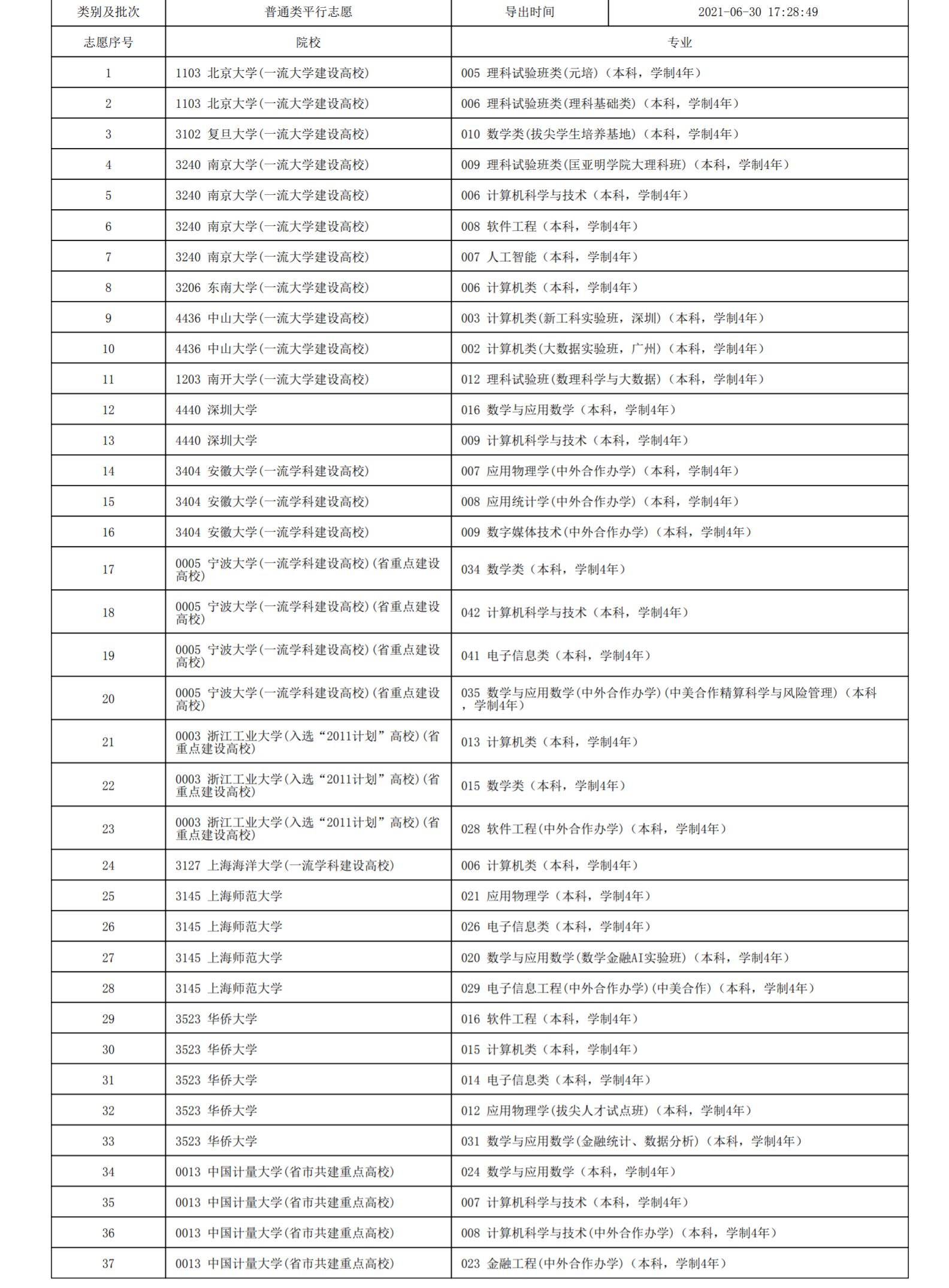
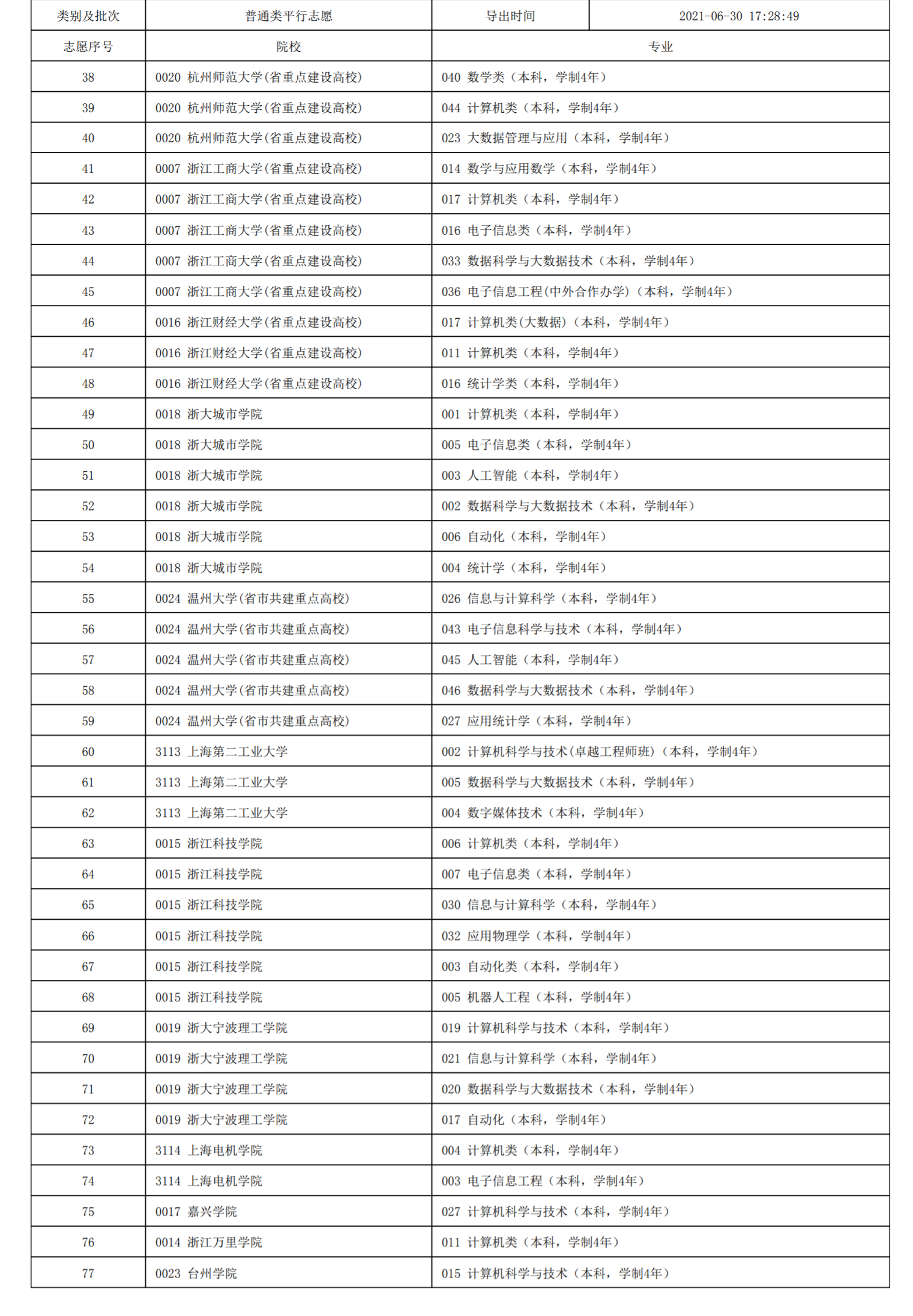


[志愿录入模版 - 09.xls](志愿录入模版 - 09.xls)
literature
literature -> Chinese
Abstract Brings Repeatation
Abstract words are used extensively, and abstract words are inconvenient to create, resulting in considerable repetition.
Abstract
張永剛 董學文, 文學原理 北京大学出版社, 2014 page 170 ISBN 978-7-301-23769-4
Google Lens: 开情害志的载体,在诗作中,一切皆为写意画存在,结果形成中国业將的评 歌意境。意境仿佛大手笔的国而,不重细节对现实的精确呈现,而以流动的 视点超然万物之上,以夸张、比喻,拟人, 象征等手法追求变形奇拿。多多发 销之中,负载人的精神个性与人格气质已然成形,以少总多以简练的文学 传达 开侧的心灵视野,只有写意オ可以达到这种程度。这种表现的特点, 至作为一种创作精神,透潜在中国后来出现的敘事文体即小说和戏中心 们本应以再现为本,但表现的特点却十分突出。中国小说的人物描写,以写 意为主以传神为重,所用的词汇也充满了意会性,如“相貌堂堂”、“成风車 團”、“精神抖擞”这类抽象化词语在小说写人中被大量运用就是个例子 戏園中人物唱词说白高度诗化更是普遍现象,可以说中国戏剧中球与音乐 的成分超过了戏剧。这已成为人们的共识。足见正是“表现”使中国文学获 得了自己的传统,并以此保持着在世界文学中的独立地位。
Repeatation, An example
野山も里も,見渡すかぎり -> 万里无云多宁静
mathematics
SMT & SAT (Satisfiability modulo theories & Boolean satisfiability problem)
几年前好像在哪里看到过说随机生成的SMT问题随着规模的增加变得几乎不可解决,而人写的问题,很多可以被优化过的求解器快速的地解决,可能是问题中隐含着一个更小更简单的问题。今天不知为何这个东西突然出现在思考其他问题的过程中,想,这可以类比为随机生成计算机程序。
algebra
draft
L'Hôpital's rule and 端点效应
Do they have any remarkable relationship with each other?

端點效應:\(f(x)+kg(x)\)在\(x=1\)處函數值爲0,一次導數爲0,可知二次導數大於等於0。
L'Hôpital's rule:\(\frac{f(x)}{g(x)}\)
Zero
意义: 分界(the critical state)
note & prosa
Cause and Effect
认为因果或未来与现在与过去或...相对或同时出现或...的文学作品
TODO: 名字忘了
主旨1:明确知道未来何时自身会如何毁灭但仍旧认真地生存着
Related: das Sein zum Tode (向死存有)
Sein und Zeit - Martin Heidegger
Doing Tasks
Multitasking is bad
No one wants a traditional computer with just single core to switch between heavy processes forth and back every a few instruments, wasting time on context switch. So is human brain.
Multitasking is bad, but how about Hyperthreading?
Due to the nature of some tasks, a considerable amount of time is wated while waiting.
I argue that the waiting time can be used by doing other task, which is called filling task by me, but not normally recommended.
Slow-Motion Multitasking
A powerful way to unleash your natural creativity | Tim Harford - TED Talk
It can be also called lightweight thread and Hyperthreading and green thread and event loop and so on
How to Speak
MIT How to Speak, IAP 2018 Instructor: Patrick Winston View the complete course: https://ocw.mit.edu/how_to_speak
How to Start
Give an empowerment promise
People always fog out
Solution:
- Cycle: repeat ~3 times
- Seam
- Provide landmarks
- Ask questions - 7 seconds - right difficulty
Idea
Fence
Time and Place
- well lit
- 踩点
- right size
Board / Slides
...
- Hand
Props ...
Mess: something unstructed
提純雜質(by Z.J.J.)與什麼都不做都很困難。
person
Thomas Young
The Last Man Who Knew Everything
A polymath's dilemma - Andrew Robinson
Thomas Young strove to satisfy his curiosity in virtually every scientific subject and, undeterred by sceptics calling for a narrower focus, made discoveries in almost all the fields he studied.
Polymaths have always posed a problem in academia. How do they relate to specialization and interdisciplinarity, genius and dilettantism, inspiration and perspiration? Robert Hooke, Benjamin Franklin and Alexander von Humboldt were among those who were too academically wide-ranging for posterity to cope with, and their scientific reputations suffered as a consequence.
Individual curiosity is the driving force of science, but when insatiable, can it hamper the intellectual? The life and work of the polymath Thomas Young (1773–1829) illuminates the issue perhaps more acutely than that of any other scientist. Today, views of Young span the spectrum from near-universal genius to dabbling dilettante. Those who appreciate him — especially physicists, physiologists and Egyptologists — admire his range, his intuition and his far-sightedness. Those who do not, depreciate these same aspects of his life and work as sloppiness and opportunism.
Some great names of nineteenth-century science, notably John Herschel, Hermann von Helmholtz and John William Strutt (Rayleigh), were in awe of Young. In 1931, Einstein paid tribute to him in a brief foreword to Newton's Opticks; he referred to Newton's observations of the colours of thin films “as the origin of the next great theoretical advance, which had to await, over a hundred years, the coming of Thomas Young.” In Nature, Joseph Larmor, a former Lucasian professor of mathematics at Cambridge, wrote an essay on Young calling his 1802–03 lectures on natural philosophy at the Royal Institution “the greatest and most original of all general lecture courses”. In 1973, on Young's bicentenary, the Science Museum in London noted, startlingly, that “Young probably had a wider range of creative learning than any other Englishman in history. He made discoveries in nearly every field he studied.”
World explorer: from the human eye to Egyptian script, Thomas Young's interests ranged widely. Credit: BRIDGEMAN.CO.UK
Young made a pioneering contribution to the understanding of light by demonstrating interference patterns, known as ‘Young's fringes’, around 1800, which led to the Young–Fresnel undulatory theory. He also formulated an important measure of elasticity, called ‘Young's modulus’. He was the first to explain the accommodation of the eye; he discovered the phenomenon of astigmatism; and he proposed the three-colour theory of vision. This was later known as the Young–Helmholtz theory, and was finally confirmed experimentally in 1959. He undertook seminal detective work on the Rosetta Stone and helped to found Egyptology. Although the credit for finally reading the hieroglyphs belongs to Jean-François Champollion, Young was the decipherer of the second type of Egyptian script on the Rosetta Stone, known as demotic script.
In addition, he was a distinguished physician at St George's Hospital; foreign secretary of the Royal Society for a quarter of a century; an authoritative writer on all manner of subjects; a major scholar of ancient Greek; and a phenomenal linguist who coined the term ‘Indo-European’ for the language family that includes Greek and Sanskrit.
When pressed to contribute to the Encyclopaedia Britannica, Young offered articles on the alphabet, annuities, attraction, capillary action, cohesion, colour, dew, Egypt, the eye, focus, friction, haloes, hieroglyphics, hydraulics, motion, resistance, ships, sound, strength, tides, waves and “anything of a medical nature”. And he wasn't boasting: having been an ‘inspector of calculations’ and physician of a London-based life-insurance company in the 1820s, he knew about annuities. And his roles as adviser to the Admiralty on shipbuilding, secretary of the Board of Longitude, and superintendent of the vital Nautical Almanac from 1818 until his death had informed him on ships.
He also wrote many biographical articles about scientists and mathematicians, an occupation that led him to reflect on his own intellectual motivation to a close friend: “The biographical articles seldom amuse me much in writing; there is too little invention to occupy the mind sufficiently: I like a deep and difficult investigation when I happen to have made it easy to myself if not to all others — and there is a spirit of gambling in this, whether as by the cast of a die, a cal-culation à perte de vue, shall bring out a beautiful and simple result, or shall be wholly thrown away.”
Scarcely the words of a dilettante. But, on the other hand, Young was restlessly curious. He generally moved on long before he had fully explored his intuitions and discoveries. As a result, his reputation suffered, which he well knew. “Whether the public would have been more benefited by his confining his exertions within narrower limits, is a question of great doubt,” Young said in an autobiographical sketch intended for a posthumous edition of the Britannica. After his death, the president of the Royal Society could not help but echo this ambivalence towards polymathy in a valedictory address: “[His] example is only to be followed by those of equal capacity and equal perseverance; and rather recommends the concentration of research within the limits of some defined portion of science, than the endeavour to embrace the whole.”
Whether one admires polymaths seems a matter of taste, not objective judgement. But it should surely be indisputable that a man of sweeping vision like Young has a place in science as valuable as, say, the more narrowly focused Augustin Fresnel, Helmholtz or Champollion. In Young's own perceptive words: “It is probably best for mankind that the researches of some investigators should be conceived within a narrow compass, while others pass more rapidly through a more extensive sphere of research.”
physics
Basic
Definition
x
t
m
\(v=\frac{\Delta x}{\Delta t}=\dot x\)
\(a=\frac{\Delta v}{\Delta t}=\dot v=\ddot x\)
\(F=m\cdot a\)
Corollary
\(x=\Sigma v_i \Delta t=v_0 t+\frac{1}{2}a t^2\)
\(I=F\cdot t=m\cdot a\cdot t=m\cdot v\)
\(E_k=F\cdot x=\Sigma F\cdot v_t\cdot \Delta t=\Sigma m\cdot a\cdot v_t\cdot \Delta t=\Sigma m\cdot v\cdot v_t=\frac{1}{2}m v^2\)
\(v_1^2-v_0^2=2ax\) <=> \(E_{k1}-E_{k0}=W\)
Physiology or Medicine
Slowly Rocking Bed
The Effect of a Slowly Rocking Bed on Sleep
Effect of Rocking Movements on Afternoon Sleep
Participants transitioned faster into deep sleep under the influence of medium intensity rocking
NCEE
Every new parent knows that rocking can calm that uneasy baby when it's time to take a nap. But the benefits of gentle movement may go beyond the baby stage. Because two new studies show that rocking also helps
grown-ups, both human and mouse, get a good night's
sleep.
What should be no surprise is that movement can calm someone.
Think of how many times you've fallen
asleep on a train.
But can motion really cause a nap,
and
make for a deeper sleep?
To find out, researchers invited 18 healthy volunteers for a sleepover.
"So they came to the lab and slept one time on the motionless, normal bed. And one night where they got rocked." said Aurore Perrault, a sleep researcher at the University of Geneva
in Switzerland." And what we find is that when compared to a motionless
night, a whole night of rocking sleep has a beneficial effect not only on sleep beginning
but also on sleep continuity."
Subjects who were rocked also did better on a memory test the next morning than the stiller sleepers. In the second study, Kompotis, a student
at the University of Lausanne, rocked a group of mice."
Whether rocking
affects sleep in other species was never before discussed. So the main questions
for our study were whether
rocking affects sleep
in mice
and what is the possible system?"
Kompotis placed the mouse cages on a platform that moved from side to side. Though mice were rocked four times faster than their human counterparts—a frequency of one back-and-forth per second,
or 1 Hertz, worked best—the results were strikingly similar." During rocking at 1 Hertz, time spent asleep increased, and mice fell asleep twice as fast as at still condition." However, additional studies could allow the researchers to identify a new aim for treating sleep disorders, including insomnia(失眠).
If you want a good night's sleep, you
might think about adding a little swing to your
night-time routine.
Piece of Code
Expression-Oriented-C
Expression-Oriented-C-with-git-history.tgz https://github.com/zaoqi/Expression-Oriented-C
Signal - A Monad for signal handling
inspired by original [Elm](https://en.wikipedia.org/wiki/Elm_(programming_language). Maybe some versions before 1.0?
https://github.com/zaoqi/Signal.hs/blob/master/Control/Concurrent/Signal.hs
--Copyright (C) 2017 Zaoqi
--This program is free software: you can redistribute it and/or modify
--it under the terms of the GNU Affero General Public License as published
--by the Free Software Foundation, either version 3 of the License, or
--(at your option) any later version.
--This program is distributed in the hope that it will be useful,
--but WITHOUT ANY WARRANTY; without even the implied warranty of
--MERCHANTABILITY or FITNESS FOR A PARTICULAR PURPOSE. See the
--GNU Affero General Public License for more details.
--You should have received a copy of the GNU Affero General Public License
--along with this program. If not, see <http://www.gnu.org/licenses/>.
{-# LANGUAGE TypeOperators #-}
{-# LANGUAGE DataKinds #-}
{-# LANGUAGE FlexibleContexts #-}
{-# LANGUAGE MultiParamTypeClasses #-}
{-# LANGUAGE FlexibleInstances #-}
{-# LANGUAGE GADTs #-}
module Control.Concurrent.Signal (
newSignal,
newStreamSignal,
runSignal,
runStreamSignal,
scanp,
sampleOn,
slift,
sliftinit,
isStreamSignal,
noSampleOn
) where
import Control.Concurrent
import Control.Concurrent.Chan
import Control.Monad
import Data.IORef
import Control.Exception
catch_ :: IO () -> IO ()
catch_ x =
x
`catch` \(SomeException _) -> return ()
data Signal a = Signal ((a -> IO ()) -> IO ()) | -- 有新信号时调用(a -> IO ()),不能同时多次调用,返回的IO ()用来注册
Stream (IO (IO a)) --返回的IO a调用时返回下一个值
newSignal :: ((a -> IO ()) -> IO ()) -> Signal a
newSignal s = Signal $ \f -> s $ catch_ . f
newStreamSignal :: IO (IO a) -> Signal a
newStreamSignal = Stream
stream2Signal (Stream x) = newSignal $ \f -> do
s <- x
forkIO $ forever $ do
i <- s
f i
return ()
runSignal :: Signal a -> (a -> IO ()) -> IO ()
runSignal (Signal x) = x
runStreamSignal :: Signal a -> (a -> IO ()) -> IO ()
runStreamSignal x = runSignal . stream2Signal $ x
instance Functor Signal where
fmap f (Signal s) = Signal $ \n -> s $ n . f
fmap f (Stream s) = Stream $ fmap (fmap f) s
--fmap f (Stream s) = Stream $ do
--g <- s
--return $ do
--x <- g
--return $ f x
splus (Signal a) (Signal b) =
let
call ra rb f r i = do
atomicWriteIORef r (Just i)
ia <- readIORef ra
ib <- readIORef rb
case (,) <$> ia <*> ib of
Just x -> f x
Nothing -> return ()
in Signal $ \f -> do
ra <- newIORef Nothing
rb <- newIORef Nothing
b $ call ra rb f rb
a $ call ra rb f ra
splus (Stream a) (Stream b) = Stream $ do
fa <- a
fb <- b
return $ (,) <$> fa <*> fb
splus (Signal a) (Stream b) = Signal $ \f -> do
fb <- b
a $ \ia -> do
ib <- fb
f (ia, ib)
splus (Stream a) (Signal b) = Signal $ \f -> do
fa <- a
b $ \ib -> do
ia <- fa
f (ia, ib)
instance Applicative Signal where
pure = Stream . return . return
x <*> y = fmap (\(f, x) -> f x) $ splus x y
scanp :: (b -> a -> b) -> b -> Signal a -> Signal b
scanp f x (Signal s) = Signal $ \n -> do
r <- newIORef x
s $ \i -> do
p <- readIORef r
let ns = f p i
writeIORef r ns
n ns
scanp f x (Stream s) = Stream $ do
fi <- s
r <- newMVar x
return $ do
i <- fi
uninterruptibleMask $ \restore -> do
p <- takeMVar r
let ns = f p i
onException (restore $ do
putMVar r ns
return ns) (putMVar r p)
sampleOn :: Signal b -> Signal a -> Signal a
sampleOn (Stream _) x = x
sampleOn (Signal c) (Stream v) = Signal $ \n -> do
fv <- v
c $ \_ -> do
i <- fv
n i
sampleOn (Signal c) (Signal v) = Signal $ \n -> do
r <- newIORef Nothing
v $ \i -> atomicWriteIORef r (Just i)
c $ \_ -> do
i <- readIORef r
case i of Just x -> n x
Nothing -> return ()
slift :: Signal (IO a) -> Signal a
slift (Signal s) = Signal $ \n -> s $ \f -> do
x <- f
n x
slift (Stream s) = Stream $ fmap join s
sliftinit :: IO a -> Signal a
sliftinit f = Stream $ do
x <- f
return . return $ x
isStreamSignal :: Signal a -> Bool
isStreamSignal (Stream _) = True
isStreamSignal _ = False
noSampleOn :: Signal a -> Signal a
noSampleOn (Signal f) = Stream $ do
r <- newIORef undefined
f $ atomicWriteIORef r
return $ readIORef r
zKanren
https://github.com/the-language/zKanren zKanren-with-git-history.tgz
order-irrelevance for conj
microKanren's disj is order-irrelevant, but conj is not
microKanren: https://github.com/jasonhemann/microKanren/blob/master/microKanren.scm
;; Jason Hemann and Dan Friedman
;; microKanren, final implementation from paper
(define (var c) (vector c))
(define (var? x) (vector? x))
(define (var=? x1 x2) (= (vector-ref x1 0) (vector-ref x2 0)))
(define (walk u s)
(let ((pr (and (var? u) (assp (lambda (v) (var=? u v)) s))))
(if pr (walk (cdr pr) s) u)))
(define (ext-s x v s) `((,x . ,v) . ,s))
(define (== u v)
(lambda (s/c)
(let ((s (unify u v (car s/c))))
(if s (unit `(,s . ,(cdr s/c))) mzero))))
(define (unit s/c) (cons s/c mzero))
(define mzero '())
(define (unify u v s)
(let ((u (walk u s)) (v (walk v s)))
(cond
((and (var? u) (var? v) (var=? u v)) s)
((var? u) (ext-s u v s))
((var? v) (ext-s v u s))
((and (pair? u) (pair? v))
(let ((s (unify (car u) (car v) s)))
(and s (unify (cdr u) (cdr v) s))))
(else (and (eqv? u v) s)))))
(define (call/fresh f)
(lambda (s/c)
(let ((c (cdr s/c)))
((f (var c)) `(,(car s/c) . ,(+ c 1))))))
(define (disj g1 g2) (lambda (s/c) (mplus (g1 s/c) (g2 s/c))))
(define (conj g1 g2) (lambda (s/c) (bind (g1 s/c) g2)))
(define (mplus $1 $2)
(cond
((null? $1) $2)
((procedure? $1) (lambda () (mplus $2 ($1))))
(else (cons (car $1) (mplus (cdr $1) $2)))))
(define (bind $ g)
(cond
((null? $) mzero)
((procedure? $) (lambda () (bind ($) g)))
(else (mplus (g (car $)) (bind (cdr $) g)))))
not equal
TODO
report: book report / review / excerpt / ...
Escape from Freedom
TODO
Music Theory: From Beginner to Expert
Symbolical language and the underlying meaning
If you are interested in learning to read music, then there are many tools
available for you to do so, but it is worth saying here that it isn’t a necessary part
of learning theory. Theory is a collection of ideas, ideas that interact with one
another and guide our ears. Putting that theory down symbolically on the staffcan be useful, but it doesn’t all by itself mean that we will understand it or be
able to use it any better.
國史新論
內在條件與外在條件;人與事
一三 中國歷史人物
內在條件 Quote
一切外在條件,使岳飛失敗。而岳飛個人之內在條件,則使岳飛成功了。成功的乃是岳飛這個人。
外在條件遮掩內在條件 Quote
孔子若做了魯國宰相,當了權,他的成績可能比管仲更大,或許孔子可與周公相比。然而縱是周公政績偉大,也只表現在事上。一切都得變,西周仍變了東周。
scripts
todo / ongoing projects
legacy
A Book About Basic Ideas of CS
Title Candidates
- Non-Essentials of Electronic Computing
Words
一些需要被理解的單詞
- noncoalescence: 水面上的水滴
- minimal surface egg
Chores
- Evaluate MOOC, MITOCW and stanfordonline
- re-make smallest rpi0 with touch screen and battery
- Backup WayBack Machine
- Send FPV into Space
- Read and Translate "Sein und Zeit", "À la recherche du temps perdu" and "How Proust Can Change Your Life"
- Make enough money (several hundreds of millions?) so that I can get customized ASIC
Instruments: I want to buy or get sth
Chemputer or any programmable Chemical Synthesis Machine
LinnStrument
configurations
Backup
Physics
SSD / HDD
注意寿命问题
注意翻新盘/...的问题(几乎无法区分)
BD
Services
Baidu / Google Drive
VIP失效/Google One失效不影响原文件--适合只读备份。
Storage VPS
expensive
Novel Solutions
降低需要备份的数据量
Project Silica
Devices
A small and portable amd64 laptop (about 7inch)
Conditions: Intel Core / AMD; More than 2 USB 3.0 ports
Available
Brands: GPD / One-Netbook
| Name | Price (Secondhand) / RMB | CPU | Mem | Size / cm | Extra |
|---|---|---|---|---|---|
| GPD P2 Max | 3500-4000 | m3-8100Y | 16G | 15*21 | stylus&touch |
| One-Netbook 2s | 2000-2700 | m3-8100Y | 8G | 11*18 | stylus&touch |
| One-Netbook 3s | 3400-4000 | m3-8100Y | 16G | 13*20 | stylus&touch |
A small and portable amd64 workstation
Conditions: Intel Core i7/i9 / AMD Ryzen; standalone graphics card
Available
Brands: Taobao brands
|Taobao Link|Prices (No Memory and SSD by default) / RMB|
|9.0 hi:/,QPv0X2e552b, 占美 微型i7-9700F独显迷你电脑台式主机高清4K吃鸡游戏设计HT610|i7-8750H - 3200|
|4👈 ha:/微6vs8X2e5meU啊 酷睿I9独显迷你主机I7微小型台式电脑mini工控htpc游戏吃鸡专场|i7-9750H - 3360 i9-9880H - 3650|
|5.0 hihi:/啊5V9FX2e6JsP微 吃鸡i9台式mac黑苹果迷你电脑小主机mini独显游戏家用nuc便携itx|...|
Apple Sillicon
|Name|Price / RMB| |Macbook Air (M1) (Macao)|6400| |Mac mini (M1) (Secondhand)|4300-5900|
A
Refitted Mac mini (DC power) + iPad Pro for I/O
| Model | Price (Secondhand) / RMB |
|---|---|
| iPad Air4 | Brand new: 3600 |
| iPad Pro 2018 | 3700-4600 |
B
Macbook
A foldable amd64 laptop with stylus
Lenovo Yoga
Lenovo Yoga X1 - possibly too expensive
HP Envy x360 - pen is not included by default
Acer Spin5
FPGA with ARM
Usages:
https://github.com/vmware/cascade https://github.com/apache/tvm-vta More
Available:
- xilinx zynq
- Terasic DE10 Nano SoC and the ULX3S
reconfigurable FPGA ? (Partial Reconfiguration - xilinx) For JIT
this? Partial Reconfiguration - xilinx
Mobile Linux GUI Shell on Android
Goal
Run Plasma Mobile or phosh on top of Android
References / Resources
ArchWiki - User:Fordprefect/Plasma Mobile pm-arch - PKGBUILD Manjaro ARM - PKGBUILD TermuxArch on Github XServer XSDL on Github phosh - AUR KDE Plasma 5 running on rooted Android 10 under Wayland with OpenGL 3D Acceleration with Linux Deploy!
Opt-in State - Windows
use portable sandboxie
Implementation ideas
- Windows PE
- btrfs https://github.com/maharmstone/btrfs & https://github.com/maharmstone/quibble
- commercial software: Deep Freeze & Reboot Restore Rx
iOS external screen (iPhone/iPad)
proper external screen support for displaying more
available solution: the app shiftscreen
Implement it?
Use M1 Mac?
Electronics
Asynchronous
这都已经跳票了至少半个decade
No clk, no period, power-efficient, no need to synchronize all parts, no need to overclock
Implementation ideas
Signal: purely functional & with side-effect
Example: And Gate
(pesude code)
module and (
input reset,
input bit1high,
input bit1low,
input bit2high,
input bit2low,
output reg out1high,
output reg out1low);
reg previous_bit1high;
reg previous_bit1low;
reg previous_bit2high;
reg previous_bit2low;
assign input_done = ((bit1high != previous_bit1high) || (bit1low != previous_bit1low)) && ((bit2high != previous_bit2high) || (bit2low != previous_bit2low));
assign input_1 = bit1high != previous_bit1high;
assign input_2 = bit2high != previous_bit2high;
always @(posedge reset, posedge input_done) begin
if (reset) begin
{out1high, out1low, previous_bit1high, previous_bit1low, previous_bit2high, previous_bit2low} <= {0, 0, bit1high, bit1low, bit2high, bit2low};
end else if (input_done) begin
if (input_1 && input_2) begin
out1high <= ~out1high;
end else begin
out1low <= ~out1low;
end
{previous_bit1high, previous_bit1low, previous_bit2high, previous_bit2low} <= {bit1high, bit1low, bit2high, bit2low};
end
end
endmodule
Snapshot input: purely functional
Copy input or use reversible logic gate for user to check whether the computing is finished or not
TODO: verilog and/or physics may break the semantics
Of course it would break if some wires are too long.
Usage: reset inputs; wait snapshots to become zero; input; wait snapshots
Example: And Gate
(pesude code)
module and (
input bit1,
input bit2,
output out1,
output snapshot_bit1,
output snapshot_bit2);
always @(bit1, bit2) begin
{snapshot_bit1, snapshot_bit2, out1} <= {bit1, bit2, bit1 && bit2};
end
endmodule
A safer version?
(pesude code)
module and (
input bit1,
input bit2,
output reg out1,
output reg snapshot_bit1,
output reg snapshot_bit2);
always @(bit1, bit2) begin
out1 = bit1 && bit2;
{snapshot_bit1, snapshot_bit2} <= {bit1, bit2};
end
endmodule
Dual-Rail
Mutual NOT (01/10)
Valid / Invalid: purely functional & with side-effect
User:
- Make Input invaild
- Wait Output to be invalid
- Input
- Wait Output
(pesude code)
module and (
input bit1high,
input bit1low,
input bit2high,
input bit2low,
output reg out1high,
output reg out1low);
assign input_invalid = !(bit1high || bit1low || bit2high || bit2low);
assign input_valid = (bit1high != bit1low) && (bit2high != bit2low);
assign result = bit1high && bit2high;
always @(posedge input_invalid, posedge input_valid) begin
if (input_invalid) begin
{out1high, out1low} <= {0, 0};
end else if (input_valid) begin
{out1high, out1low} <= {result, !result};
end
end
endmodule
TODO: implement working asynchronous ARM/RISC CPU
Multiple instances of modules of pipeline & Lightweight thread (a scheduler will be needed)
the number of cores? give software a random number
Clock rate? tell software that the frequency is 10Ghz
JIT - FPGA
JIT all the way down to the hardware - FPGA
Journal
set up a new scientific academic journals
machinery
Wind-powered, but faster than wind
vehicle
The vehicle has a fan, instead of a windmill.
Enhancements could be made to allow the vehicle to run at any direction
power generator?
Implement cycles - Stroke (engine) ?
material
YBCO
Making
References
- NileRed on Youtube
- NileRed on Bilibili - read the comments - Quote
这个混合方法真的很硬核。。我上学做的时候就直接研钵磨磨磨的,而且只烧了一个晚上,最后也能让磁铁浮起来( - Applied Science on Youtube
- 我是神经病250 on Bilibili
- 草酸共沉淀法制备YBCO粉体的热力学分析
- 钇钡铜氧超导材料的制备方法 - 郑州大学 1996
note (meta-TODO)
Add some features to mdbook
Tag
Implementation ideas
Make a preprocessor: [[tag]] -> ...; generate a file: graph.html
thing
Automatic Book Scanner
Goal
- Cheap
- Customizable
- Open source
Implementation ideas
Flip Page
- Gravity
- Air Flow
Page Adjustment
- laser making some bright parallel lines on the page
algorithm / virtual / software / ...
A GCed blockchain of GCed blockchains for distrubed voxel game server
GC = garbage collection
Blockchain (Blockchain Block) where Blockchain : Type -> Type
for better writing speed
A fully functional and usable desktop/mobile distribution to provide security through isolation
wanted features
- Opt-in State
- Support GPU
- Run everywhere (amd64 and arm64, not browsers)
- Support Linux, Android and Windows GUI programs
- Simple
Inspirations
might be useful
-
Docker
-
lxc
-
crosvm of Chrome OS?
-
NixOS containers?
-
FreeBSD Linux® Binary Compatibility - use different kernel?
-
Docker on Android - How about run the dist on rooted android phones?
-
postmarketOS - or on a real Linux distribution for phones?
-
proot - or on normal android phones?
A programming language designed for easy expressing and understanding
don't worry about the performance - It can be improved at some point Self Optimizing Virtual Machine
don't worry about the existing ecosystem - It can be easily rebuilt if the design is successful
Design A
A stable dynamic typed purely functional core (a lisp dialect) with a very fixed set of data types
(purely functional here means no side-effect, not referential transparency)
And build things on top of it
things going to be easy
- run programs backward and forward
- virtualization
- manipulate programs
- Language-Oriented Programming
- Implement multiple dependent type system
- security through isolation
- common tools for multiple sub-languages
- ...
things going to be impossible
- DRM (Digital Restrictions Management / Digital rights management)
- debugging using
print() - force everybody to use one unhackable and unchangeable object-oriented programming language
- casually add side-effect to a part of a program
- ...
A Purely functional virtual world
Where people can pratice their skills without the fear of affect variables of the real world, such as other people's views
Where people can try again and again, at little cost
Where Machine Learning Algorithms can ...
An example
Computer Science
Countinuer: algorithm to complete something
something = Music or Unicode Text or ...
Models
- preamble -> one or some unicode character(s)
- preamble -> one or some word(s) 但某些語言無有效的分詞方式。
Implementation
FPGA could be utilized
GUI 1
(pesude code)
data GUI _|_ = Text String | ...
data (GUI (), GUI a) = Button0 (GUI a) | ...
data GUI () = forall a. Button1 (GUI a) | ...
data GUI t = forall t0. Bind (GUI t0) (t0 -> t) | forall t0. forall s. StatedBind (init : s) (GUI t0) (t0, s -> t, s)
data GUI (Listof t) = LeftToRight (Listof (GUI t)) | ...
data GUI t = Virtual (Signal t)
Media converter
Text & Image -> Video
图片如果不够可以依据文本中的单词来寻找。
Video -> Interactive Text
比如鼠標悬停在某一行上可以显示出对应的画面。 最好能分析出关键的画面和动画,默认显示。
这样可以节约看视频的时间。
Security Through Isolation
inspired by Qubes OS
Goal
Create a better (not revolutionary) desktop and mobile operating system to provide security through isolation for existing applications and existing hardwares and existing ecosystems using existing ideas and existing components.
Resources
virtualization & containerization
Ideas
X11 Sandboxing
compatibility layer
Mobile
Script & base distro
FileSystem
Self Optimizing Virtual Machine
Goal
Make a virtual machine, like JVM, that will run any programs very fast with a small resource consumption.
Goal2: strip a program in a virtual machine or on a compatible layer
Usage
Free human from this boring work, including optimizing the virtual machine itself
(Possibly) Difficulties
- Assess different optimized results
- Balance the time of optimization process and execution
- ...
Implementation ideas
- Machine learning
- Ask the virtual machine to write proofs to prove that the optimized ones equal the original ones
- Slightly change the programming language to allow programmers to describe all acceptable results of an experssion
- Optimize a version of virtual machine itself as if it is a program running on the virtual machine - requires the virtual machine to emulate the environment where itself runs
Machine learning
- Improve programs written by programmers
- Rewrite one
Evaluation System: Correctness / Time / Space
Symbolic Expression File System
Goal
Create a atomic file system to store a huge S-Exp.
(Possibly) Difficulties
- bit flipping
Implementation ideas
- Use non-recursive structure to express recursion; Use Automic Reference counting for GC
Supported data types
Core
- Symbol
- List
- Mapping
- Tagged (A pair of a tag and a list)
Extra
- Number
- String
- Binary
- ...
- Function
- ...
interplanet (Multiplanetary)
Human will sooner or later become a multiplanet species.
Universal Net (a interplanet network)
To create one feasible computer network that can work on multiple planets
Implementation ideas
- Immutable to the greatest extent
What does the current internet provide?
- Nearly Static Informations (Webpages) - Use Distributed Cache
- instant messaging - send messages as is
Universe Wide Push-Only Stack (interplanet blockchain)
(Also known as Blockchain)
What do blockchains provide?
- currency
- ?
A multiplanet Voxel Game
miniKanren-related
Branch prediction based on historical data
or use machine learning to predict branch?
Running Linux Kernel on miniKanren with Acceptable Performance
Then we can exploit linux kernel easily!
translation
chinese
What’s the Point If We Can’t Have Fun?
Author: David Graeber
譯文
我和我的朋友June Thunderstorm曾經在山中的一個湖泊中呆了一個小時,坐着,看着懸掛在草莖頂端的尺蠖,向各個方向扭轉身體,然後跳到下一根草莖上重復同樣的活動。就像這樣,它一圈一圈地,似乎毫無理由地,消耗了大量的能量。
“所有動物都在玩,”June曾對我這樣說,“即使是螞蟻。”她數年都從事園丁工作,經常遇到這樣的值得觀察與思考的事件。“看,”她略帶着勝利者的表情,說,“看明白我的用意了嗎?”
我們中大部分人聽到這個故事後都會極力反駁。我們怎麼知道蠕蟲在玩耍?或許這些無形的圓圈,正是它尋找某種未知的獵物的軌跡。或是一種交配形式。我們能證明它們不在做這些事情嗎?即便蠕蟲真的在玩耍,我們要如何知道這種玩耍沒有實用的生存目的:運動,抑或是自我訓練,爲了迎接將來的緊急情況?
這也是絕大部分倫理學家的反應。一般而言,分析動物的行爲被認爲是不科學的,除非我們假設,動物會做一些計算,就像人們會在做經濟交易時做的那樣,並根據這些計算來行動。在這個假設之下,任何能源的支出必須針對某種目標,無論是獲取食物,維護領地,取得統治階級的地位,或是最大化生殖成功--除非有人可以證明絕對不是這種情況。而此類問題的證明,就像人們所想一樣,很難實現。
我必須在此強調,科學家可能接受哪種動物動機的理論並不重要:她所認爲的動物正在思考的內容,她是否認爲動物可以被認爲,在思考。我不是在說行爲學家真的認爲動物僅僅是理性計算機器。我只是說,行爲學家把自己限制在了一個世界裏,在這個世界裏,科學意味着提供一個對於行爲的理性解釋,而這意味着描述動物時將其視作嘗試最大化自己利益的理性經濟物,無論他們的動物心理學理論或動機如何。
這就是動物遊戲被視作學術醜行的原因。對它的研究極爲不足,並且人們認爲相關研究者有點古怪。就像許多模糊的,投機性的概念一樣,許多難以滿足的標準被引入,以防證明動物遊戲的存在。即使被認可,研究也常常試圖證明遊戲必須有遠期的生存或生殖功能來瓦解自己的見解。
盡管如此,那些確實關注了這個事情的人總是被迫承認整個動物界中確實存在遊戲。並且這不只存在於猴子,海豚或幼犬這些臭名昭著的玩世不恭的動物,也存在於青蛙,米諾魚,蝾螈,招潮蟹這些看似不可能玩耍的物種中。甚至還有螞蟻,它們不僅僅以個體爲單位從事無聊的活動,自從19世紀以來,人們就一直在觀察它們編排模擬戰爭,顯然這只是爲了好玩。
動物爲何而玩?或者爲什麼它們不能玩?問題是,爲什麼,爲了表現出純粹的行動樂趣的這些行動,爲了純粹的行使能力的樂趣而行使能力,會讓我們震驚?What does it tell us about ourselves that we instinctively assume that it is?
失配的幸存
自從十九世紀初達爾文主義科學的盛行開始,從經濟角度看待生物世界就成爲了一種流行思想趨勢。畢竟,查爾斯·達爾文從社會學家赫伯特·斯賓塞那裏借來了“適者生存”一詞,那個強盜男爵的寵兒。但斯賓塞反而對《自然起源》中推動自然選擇的力量大小感到震驚,而這與他自己的自由放任的經濟理論有密切的聯系。資源的爭奪,合理算計優勢以及弱者逐漸滅絕被視作宇宙的根本運行原則。
(TODO)
爲什麼是我?
(TODO)
電子會起舞嗎?
(TODO)
與魚共遊
讓我們想像一個原則。我們稱呼其爲自由原則,或者,由於Latinate constructions tend to carry more weight in such matters,因此稱其為荒謬的自由原則。讓我們想像一下,至少在某些情況下,主體最複雜的權力或能力的行使自由往往會成為其目的。顯然,這不是自然界的唯一原則。其他有其他方式。但是,如果沒有任何別的方式,它將有助於解釋我們實際觀察到的內容,例如,為什麼存在熱力學第二定律,但宇宙似乎變得越來越複雜而不是相反。正如最近一本書的標題所言,進化心理學家聲稱,他們可以解釋“為什麼性生活很有趣”。他們無法解釋的是為什麼樂趣才是樂趣。而這個原則可以。
我不否認我到目前為止所提出的理論是對一個非常複雜的問題的粗略簡化。我甚至不是在說我在這裡建議的立場--在所有物理現實的基礎上都有一個遊戲原則-必定是正確的。我只是堅持認為,這樣的觀點,至少與當前正統的怪異不一致的推測,看似一樣合理,在這種推測中,一個毫無頭腦的機器性的宇宙突然產生了無所不在的詩人和哲學家。我認為,將游戲視為一個自然原則也不一定意味著要採用任何一種milky的烏托邦式的觀點。遊戲原則可以幫助解釋性為什麼有趣,但也可以解釋暴力為什麼有趣。 (正如任何觀看過用鼠標看貓的人都可以證明的那樣,很多動物的遊玩方式並不是特別的好)但這為我們提供了思考周圍世界的基礎。
多年前,我在耶魯大學任教時,有時把閱讀一本包含著名道教故事的讀物作爲作業。我向所有可以告訴我最後一行有什麼含義的學生提供無理由的“ A”。(沒有人成功過)
莊子與惠子遊於濠梁之上。 莊子曰:「儵魚出遊從容,是魚樂也。」 惠子曰:「子非魚,安知魚之樂?」 莊子曰:「子非我,安知我不知魚之樂?」 惠子曰:「我非子,固不知子矣;子固非魚也,子之不知魚之樂全矣。」 莊子曰:「請循其本。子曰『汝安知魚樂』云者,既已知吾知之而問我,我知之濠上也。」
這個軼事通常被認為是兩種不可調和的關於世界的方法之間的對抗:邏輯學家與神秘主義者。但是,如果這是真的,那麼為什麼莊子要寫下這篇文章,表明自己被自己的邏輯學家朋友打敗了?
在考慮了多年的故事之後,我想到了這個令我震驚的重點。眾所周知,莊子和惠子是最好的朋友。他們喜歡爲了爭論這樣的事情花上花幾個小時。當然,那是莊子真正要達到的目標。之所以我們每個人都可以理解對方的感受,是因為在談論魚時,我們正在做的正是魚在做的事情:玩得開心,純粹是為了做這件事本身,做着某些自己做得很好的事情,參與遊戲。你感到被迫試圖在爭論中擊敗我,並且很高興能夠做到,這一事實表明,你所主張的前提必須是錯誤的。如果哲學家主要動機是這種樂趣,是僅僅爲了行使本身而行使其最高權力,那麼這肯定是存在於自然各個層面上的一個原理,這也就是我可以在魚類的行爲中自發地識別它的原因。
莊子說得對。June Thunderstorm也是對的。我們的思想只是大自然的一部分。我們之所以可以理解魚類、螞蟻或尺蠖的幸福,是因為,最終促使我們思考和爭論此類問題的原因是完全相同的。
現在,這不是很有趣嗎?
原文
What’s the Point If We Can’t Have Fun?
My friend June Thunderstorm and I once spent a half an hour sitting in a meadow by a mountain lake, watching an inchworm dangle from the top of a stalk of grass, twist about in every possible direction, and then leap to the next stalk and do the same thing. And so it proceeded, in a vast circle, with what must have been a vast expenditure of energy, for what seemed like absolutely no reason at all.
“All animals play,” June had once said to me. “Even ants.” She’d spent many years working as a professional gardener and had plenty of incidents like this to observe and ponder. “Look,” she said, with an air of modest triumph. “See what I mean?”
Most of us, hearing this story, would insist on proof. How do we know the worm was playing? Perhaps the invisible circles it traced in the air were really just a search for some unknown sort of prey. Or a mating ritual. Can we prove they weren’t? Even if the worm was playing, how do we know this form of play did not serve some ultimately practical purpose: exercise, or self-training for some possible future inchworm emergency?
This would be the reaction of most professional ethologists as well. Generally speaking, an analysis of animal behavior is not considered scientific unless the animal is assumed, at least tacitly, to be operating according to the same means/end calculations that one would apply to economic transactions. Under this assumption, an expenditure of energy must be directed toward some goal, whether it be obtaining food, securing territory, achieving dominance, or maximizing reproductive success—unless one can absolutely prove that it isn’t, and absolute proof in such matters is, as one might imagine, very hard to come by.
I must emphasize here that it doesn’t really matter what sort of theory of animal motivation a scientist might entertain: what she believes an animal to be thinking, whether she thinks an animal can be said to be “thinking” anything at all. I’m not saying that ethologists actually believe that animals are simply rational calculating machines. I’m simply saying that ethologists have boxed themselves into a world where to be scientific means to offer an explanation of behavior in rational terms—which in turn means describing an animal as if it were a calculating economic actor trying to maximize some sort of self-interest—whatever their theory of animal psychology, or motivation, might be.
That’s why the existence of animal play is considered something of an intellectual scandal. It’s understudied, and those who do study it are seen as mildly eccentric. As with many vaguely threatening, speculative notions, difficult-to-satisfy criteria are introduced for proving animal play exists, and even when it is acknowledged, the research more often than not cannibalizes its own insights by trying to demonstrate that play must have some long-term survival or reproductive function.
Despite all this, those who do look into the matter are invariably forced to the conclusion that play does exist across the animal universe. And exists not just among such notoriously frivolous creatures as monkeys, dolphins, or puppies, but among such unlikely species as frogs, minnows, salamanders, fiddler crabs, and yes, even ants—which not only engage in frivolous activities as individuals, but also have been observed since the nineteenth century to arrange mock-wars, apparently just for the fun of it.
Why do animals play? Well, why shouldn’t they? The real question is: Why does the existence of action carried out for the sheer pleasure of acting, the exertion of powers for the sheer pleasure of exerting them, strike us as mysterious? What does it tell us about ourselves that we instinctively assume that it is?
Survival of the Misfits
The tendency in popular thought to view the biological world in economic terms was present at the nineteenth-century beginnings of Darwinian science. Charles Darwin, after all, borrowed the term “survival of the fittest” from the sociologist Herbert Spencer, that darling of robber barons. Spencer, in turn, was struck by how much the forces driving natural selection in On the Origin of Species jibed with his own laissez-faire economic theories. Competition over resources, rational calculation of advantage, and the gradual extinction of the weak were taken to be the prime directives of the universe.
The stakes of this new view of nature as the theater for a brutal struggle for existence were high, and objections registered very early on. An alternative school of Darwinism emerged in Russia emphasizing cooperation, not competition, as the driver of evolutionary change. In 1902 this approach found a voice in a popular book, Mutual Aid: A Factor of Evolution, by naturalist and revolutionary anarchist pamphleteer Peter Kropotkin. In an explicit riposte to social Darwinists, Kropotkin argued that the entire theoretical basis for Social Darwinism was wrong: those species that cooperate most effectively tend to be the most competitive in the long run. Kropotkin, born a prince (he renounced his title as a young man), spent many years in Siberia as a naturalist and explorer before being imprisoned for revolutionary agitation, escaping, and fleeing to London. Mutual Aid grew from a series of essays written in response to Thomas Henry Huxley, a well-known Social Darwinist, and summarized the Russian understanding of the day, which was that while competition was undoubtedly one factor driving both natural and social evolution, the role of cooperation was ultimately decisive.
The Russian challenge was taken quite seriously in twentieth-century biology—particularly among the emerging subdiscipline of evolutionary psychology—even if it was rarely mentioned by name. It came, instead, to be subsumed under the broader “problem of altruism”—another phrase borrowed from the economists, and one that spills over into arguments among “rational choice” theorists in the social sciences. This was the question that already troubled Darwin: Why should animals ever sacrifice their individual advantage for others? Because no one can deny that they sometimes do. Why should a herd animal draw potentially lethal attention to himself by alerting his fellows a predator is coming? Why should worker bees kill themselves to protect their hive? If to advance a scientific explanation of any behavior means to attribute rational, maximizing motives, then what, precisely, was a kamikaze bee trying to maximize?
We all know the eventual answer, which the discovery of genes made possible. Animals were simply trying to maximize the propagation of their own genetic codes. Curiously, this view—which eventually came to be referred to as neo-Darwinian—was developed largely by figures who considered themselves radicals of one sort or another. Jack Haldane, a Marxist biologist, was already trying to annoy moralists in the 1930s by quipping that, like any biological entity, he’d be happy to sacrifice his life for “two brothers or eight cousins.” The epitome of this line of thought came with militant atheist Richard Dawkins’s book The Selfish Gene—a work that insisted all biological entities were best conceived of as “lumbering robots,” programmed by genetic codes that, for some reason no one could quite explain, acted like “successful Chicago gangsters,” ruthlessly expanding their territory in an endless desire to propagate themselves. Such descriptions were typically qualified by remarks like, “Of course, this is just a metaphor, genes don’t really want or do anything.” But in reality, the neo-Darwinists were practically driven to their conclusions by their initial assumption: that science demands a rational explanation, that this means attributing rational motives to all behavior, and that a truly rational motivation can only be one that, if observed in humans, would normally be described as selfishness or greed. As a result, the neo-Darwinists went even further than the Victorian variety. If old-school Social Darwinists like Herbert Spencer viewed nature as a marketplace, albeit an unusually cutthroat one, the new version was outright capitalist. The neo-Darwinists assumed not just a struggle for survival, but a universe of rational calculation driven by an apparently irrational imperative to unlimited growth.
This, anyway, is how the Russian challenge was understood. Kropotkin’s actual argument is far more interesting. Much of it, for instance, is concerned with how animal cooperation often has nothing to do with survival or reproduction, but is a form of pleasure in itself. “To take flight in flocks merely for pleasure is quite common among all sorts of birds,” he writes. Kropotkin multiplies examples of social play: pairs of vultures wheeling about for their own entertainment, hares so keen to box with other species that they occasionally (and unwisely) approach foxes, flocks of birds performing military-style maneuvers, bands of squirrels coming together for wrestling and similar games:
We know at the present time that all animals, beginning with the ants, going on to the birds, and ending with the highest mammals, are fond of plays, wrestling, running after each other, trying to capture each other, teasing each other, and so on. And while many plays are, so to speak, a school for the proper behavior of the young in mature life, there are others which, apart from their utilitarian purposes, are, together with dancing and singing, mere manifestations of an excess of forces—“the joy of life,” and a desire to communicate in some way or another with other individuals of the same or of other species—in short, a manifestation of sociability proper, which is a distinctive feature of all the animal world.
To exercise one’s capacities to their fullest extent is to take pleasure in one’s own existence, and with sociable creatures, such pleasures are proportionally magnified when performed in company. From the Russian perspective, this does not need to be explained. It is simply what life is. We don’t have to explain why creatures desire to be alive. Life is an end in itself. And if what being alive actually consists of is having powers—to run, jump, fight, fly through the air—then surely the exercise of such powers as an end in itself does not have to be explained either. It’s just an extension of the same principle.
Friedrich Schiller had already argued in 1795 that it was precisely in play that we find the origins of self-consciousness, and hence freedom, and hence morality. “Man plays only when he is in the full sense of the word a man,” Schiller wrote in his On the Aesthetic Education of Man, “and he is only wholly a Man when he is playing.” If so, and if Kropotkin was right, then glimmers of freedom, or even of moral life, begin to appear everywhere around us.
It’s hardly surprising, then, that this aspect of Kropotkin’s argument was ignored by the neo-Darwinists. Unlike “the problem of altruism,” cooperation for pleasure, as an end in itself, simply could not be recuperated for ideological purposes. In fact, the version of the struggle for existence that emerged over the twentieth century had even less room for play than the older Victorian one. Herbert Spencer himself had no problem with the idea of animal play as purposeless, a mere enjoyment of surplus energy. Just as a successful industrialist or salesman could go home and play a nice game of cribbage or polo, why should those animals that succeeded in the struggle for existence not also have a bit of fun? But in the new full-blown capitalist version of evolution, where the drive for accumulation had no limits, life was no longer an end in itself, but a mere instrument for the propagation of DNA sequences—and so the very existence of play was something of a scandal.
Why Me?
It’s not just that scientists are reluctant to set out on a path that might lead them to see play—and therefore the seeds of self-consciousness, freedom, and moral life—among animals. Many are finding it increasingly difficult to come up with justifications for ascribing any of these things even to human beings. Once you reduce all living beings to the equivalent of market actors, rational calculating machines trying to propagate their genetic code, you accept that not only the cells that make up our bodies, but whatever beings are our immediate ancestors, lacked anything even remotely like self-consciousness, freedom, or moral life—which makes it hard to understand how or why consciousness (a mind, a soul) could ever have evolved in the first place.
American philosopher Daniel Dennett frames the problem quite lucidly. Take lobsters, he argues—they’re just robots. Lobsters can get by with no sense of self at all. You can’t ask what it’s like to be a lobster. It’s not like anything. They have nothing that even resembles consciousness; they’re machines. But if this is so, Dennett argues, then the same must be assumed all the way up the evolutionary scale of complexity, from the living cells that make up our bodies to such elaborate creatures as monkeys and elephants, who, for all their apparently human-like qualities, cannot be proved to think about what they do. That is, until suddenly, Dennett gets to humans, which—while they are certainly gliding around on autopilot at least 95 percent of the time—nonetheless do appear to have this “me,” this conscious self grafted on top of them, that occasionally shows up to take supervisory notice, intervening to tell the system to look for a new job, quit smoking, or write an academic paper about the origins of consciousness. In Dennett’s formulation,
Yes, we have a soul. But it’s made of lots of tiny robots. Somehow, the trillions of robotic (and unconscious) cells that compose our bodies organize themselves into interacting systems that sustain the activities traditionally allocated to the soul, the ego or self. But since we have already granted that simple robots are unconscious (if toasters and thermostats and telephones are unconscious), why couldn’t teams of such robots do their fancier projects without having to compose me? If the immune system has a mind of its own, and the hand–eye coordination circuit that picks berries has a mind of its own, why bother making a super-mind to supervise all this?
Dennett’s own answer is not particularly convincing: he suggests we develop consciousness so we can lie, which gives us an evolutionary advantage. (If so, wouldn’t foxes also be conscious?) But the question grows more difficult by an order of magnitude when you ask how it happens—the “hard problem of consciousness,” as David Chalmers calls it. How do apparently robotic cells and systems combine in such a way as to have qualitative experiences: to feel dampness, savor wine, adore cumbia but be indifferent to salsa? Some scientists are honest enough to admit they don’t have the slightest idea how to account for experiences like these, and suspect they never will.
Do the Electron(s) Dance?
There is a way out of the dilemma, and the first step is to consider that our starting point could be wrong. Reconsider the lobster. Lobsters have a very bad reputation among philosophers, who frequently hold them out as examples of purely unthinking, unfeeling creatures. Presumably, this is because lobsters are the only animal most philosophers have killed with their own two hands before eating. It’s unpleasant to throw a struggling creature in a pot of boiling water; one needs to be able to tell oneself that the lobster isn’t really feeling it. (The only exception to this pattern appears to be, for some reason, France, where Gérard de Nerval used to walk a pet lobster on a leash and where Jean-Paul Sartre at one point became erotically obsessed with lobsters after taking too much mescaline.) But in fact, scientific observation has revealed that even lobsters engage in some forms of play—manipulating objects, for instance, possibly just for the pleasure of doing so. If that is the case, to call such creatures “robots” would be to shear the word “robot” of its meaning. Machines don’t just fool around. But if living creatures are not robots after all, many of these apparently thorny questions instantly dissolve away.
What would happen if we proceeded from the reverse perspective and agreed to treat play not as some peculiar anomaly, but as our starting point, a principle already present not just in lobsters and indeed all living creatures, but also on every level where we find what physicists, chemists, and biologists refer to as “self-organizing systems”?
This is not nearly as crazy as it might sound.
Philosophers of science, faced with the puzzle of how life might emerge from dead matter or how conscious beings might evolve from microbes, have developed two types of explanations.
The first consists of what’s called emergentism. The argument here is that once a certain level of complexity is reached, there is a kind of qualitative leap where completely new sorts of physical laws can “emerge”—ones that are premised on, but cannot be reduced to, what came before. In this way, the laws of chemistry can be said to be emergent from physics: the laws of chemistry presuppose the laws of physics, but can’t simply be reduced to them. In the same way, the laws of biology emerge from chemistry: one obviously needs to understand the chemical components of a fish to understand how it swims, but chemical components will never provide a full explanation. In the same way, the human mind can be said to be emergent from the cells that make it up.
Those who hold the second position, usually called panpsychism or panexperientialism, agree that all this may be true but argue that emergence is not enough. As British philosopher Galen Strawson recently put it, to imagine that one can travel from insensate matter to a being capable of discussing the existence of insensate matter in a mere two jumps is simply to make emergence do too much work. Something has to be there already, on every level of material existence, even that of subatomic particles—something, however minimal and embryonic, that does some of the things we are used to thinking of life (and even mind) as doing—in order for that something to be organized on more and more complex levels to eventually produce self-conscious beings. That “something” might be very minimal indeed: some very rudimentary sense of responsiveness to one’s environment, something like anticipation, something like memory. However rudimentary, it would have to exist for self-organizing systems like atoms or molecules to self-organize in the first place.
All sorts of questions are at stake in the debate, including the hoary problem of free will. As innumerable adolescents have pondered—often while stoned and first contemplating the mysteries of the universe—if the movements of the particles that make up our brains are already determined by natural laws, then how can we be said to have free will? The standard answer is that we have known since Heisenberg that the movements of atomic particles are not predetermined; quantum physics can predict to which positions electrons, for instance, will tend to jump, in aggregate, in a given situation, but it is impossible to predict which way any particular electron will jump in any particular instance. Problem solved.
Except not really—something’s still missing. If all this means is that the particles which make up our brains jump around randomly, one would still have to imagine some immaterial, metaphysical entity (“mind”) that intervenes to guide the neurons in nonrandom directions. But that would be circular: you’d need to already have a mind to make your brain act like a mind.
If those motions are not random, in contrast, you can at least begin to think about a material explanation. And the presence of endless forms of self-organization in nature—structures maintaining themselves in equilibrium within their environments, from electromagnetic fields to processes of crystallization—does give panpsychists a great deal of material to work with. True, they argue, you can insist that all these entities must either simply be “obeying” natural laws (laws whose existence does not itself need to be explained) or just moving completely randomly . . . but if you do, it’s really only because you’ve decided that’s the only way you are willing to look at it. And it leaves the fact that you have a mind capable of making such decisions an utter mystery.
Granted, this approach has always been the minority position. During much of the twentieth century, it was put aside completely. It’s easy enough to make fun of. (“Wait, you aren’t seriously suggesting that tables can think?” No, actually, no one’s suggesting that; the argument is that those self-organizing elements that make up tables, such as atoms, evince extremely simple forms of the qualities that, on an exponentially more complex level, we consider thought.) But in recent years, especially with the newfound popularity, in some scientific circles, of the ideas of philosophers like Charles Sanders Peirce (1839–1914) and Alfred North Whitehead (1861–1947), we have begun to see something of a revival.
Curiously, it’s largely physicists who have proved receptive to such ideas. (Also mathematicians—perhaps unsurprisingly, since Peirce and Whitehead themselves both began their careers as mathematicians.) Physicists are more playful and less hidebound creatures than, say, biologists—partly, no doubt, because they rarely have to contend with religious fundamentalists challenging the laws of physics. They are the poets of the scientific world. If one is already willing to embrace thirteen-dimensional objects or an endless number of alternative universes, or to casually suggest that 95 percent of the universe is made up of dark matter and energy about whose properties we know nothing, it’s perhaps not too much of a leap to also contemplate the possibility that subatomic particles have “free will” or even experiences. And indeed, the existence of freedom on the subatomic level is currently a heated question of debate.
Is it meaningful to say an electron “chooses” to jump the way it does? Obviously, there’s no way to prove it. The only evidence we could have (that we can’t predict what it’s going to do), we do have. But it’s hardly decisive. Still, if one wants a consistently materialist explanation of the world—that is, if one does not wish to treat the mind as some supernatural entity imposed on the material world, but rather as simply a more complex organization of processes that are already going on, at every level of material reality—then it makes sense that something at least a little like intentionality, something at least a little like experience, something at least a little like freedom, would have to exist on every level of physical reality as well.
Why do most of us, then, immediately recoil at such conclusions? Why do they seem crazy and unscientific? Or more to the point, why are we perfectly willing to ascribe agency to a strand of DNA (however “metaphorically”), but consider it absurd to do the same with an electron, a snowflake, or a coherent electromagnetic field? The answer, it seems, is because it’s pretty much impossible to ascribe self-interest to a snowflake. If we have convinced ourselves that rational explanation of action can consist only of treating action as if there were some sort of self-serving calculation behind it, then by that definition, on all these levels, rational explanations can’t be found. Unlike a DNA molecule, which we can at least pretend is pursuing some gangster-like project of ruthless self-aggrandizement, an electron simply does not have a material interest to pursue, not even survival. It is in no sense competing with other electrons. If an electron is acting freely—if it, as Richard Feynman is supposed to have said, “does anything it likes”—it can only be acting freely as an end in itself. Which would mean that at the very foundations of physical reality, we encounter freedom for its own sake—which also means we encounter the most rudimentary form of play.
Swim with the Fishes
Let us imagine a principle. Call it a principle of freedom—or, since Latinate constructions tend to carry more weight in such matters, call it a principle of ludic freedom. Let us imagine it to hold that the free exercise of an entity’s most complex powers or capacities will, under certain circumstances at least, tend to become an end in itself. It would obviously not be the only principle active in nature. Others pull other ways. But if nothing else, it would help explain what we actually observe, such as why, despite the second law of thermodynamics, the universe seems to be getting more, rather than less, complex. Evolutionary psychologists claim they can explain—as the title of one recent book has it—“why sex is fun.” What they can’t explain is why fun is fun. This could.
I don’t deny that what I’ve presented so far is a savage simplification of very complicated issues. I’m not even saying that the position I’m suggesting here—that there is a play principle at the basis of all physical reality—is necessarily true. I would just insist that such a perspective is at least as plausible as the weirdly inconsistent speculations that currently pass for orthodoxy, in which a mindless, robotic universe suddenly produces poets and philosophers out of nowhere. Nor, I think, does seeing play as a principle of nature necessarily mean adopting any sort of milky utopian view. The play principle can help explain why sex is fun, but it can also explain why cruelty is fun. (As anyone who has watched a cat play with a mouse can attest, a lot of animal play is not particularly nice.) But it gives us ground to unthink the world around us.
Years ago, when I taught at Yale, I would sometimes assign a reading containing a famous Taoist story. I offered an automatic “A” to any student who could tell me why the last line made sense. (None ever succeeded.)
Zhuangzi and Huizi were strolling on a bridge over the River Hao, when the former observed, “See how the minnows dart between the rocks! Such is the happiness of fishes.”
“You not being a fish,” said Huizi, “how can you possibly know what makes fish happy?”
“And you not being I,” said Zhuangzi, “how can you know that I don’t know what makes fish happy?”
“If I, not being you, cannot know what you know,” replied Huizi, “does it not follow from that very fact that you, not being a fish, cannot know what makes fish happy?”
“Let us go back,” said Zhuangzi, “to your original question. You asked me how I knew what makes fish happy. The very fact you asked shows that you knew I knew—as I did know, from my own feelings on this bridge.”
The anecdote is usually taken as a confrontation between two irreconcilable approaches to the world: the logician versus the mystic. But if that’s true, then why did Zhuangzi, who wrote it down, show himself to be defeated by his logician friend?
After thinking about the story for years, it struck me that this was the entire point. By all accounts, Zhuangzi and Huizi were the best of friends. They liked to spend hours arguing like this. Surely, that was what Zhuangzi was really getting at. We can each understand what the other is feeling because, arguing about the fish, we are doing exactly what the fish are doing: having fun, doing something we do well for the sheer pleasure of doing it. Engaging in a form of play. The very fact that you felt compelled to try to beat me in an argument, and were so happy to be able to do so, shows that the premise you were arguing must be false. Since if even philosophers are motivated primarily by such pleasures, by the exercise of their highest powers simply for the sake of doing so, then surely this is a principle that exists on every level of nature—which is why I could spontaneously identify it, too, in fish.
Zhuangzi was right. So was June Thunderstorm. Our minds are just a part of nature. We can understand the happiness of fishes—or ants, or inchworms—because what drives us to think and argue about such matters is, ultimately, exactly the same thing.
Now wasn’t that fun?
Video Game
Driver: San Francisco
A video game where you can play in 2nd person?
This Is What a "Second-Person" Video Game Would Look Like - Nick Robinson - Youtube
Design: shift
You can shift into a npc's car whenerver you want
偽書 偽文
禹
人心惟危,道心惟微,惟精惟一,允執厥中
友人
- 谢宇恒 - xyh
- Z. J.J. - Z.J.J.


